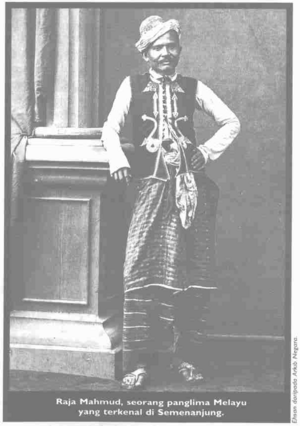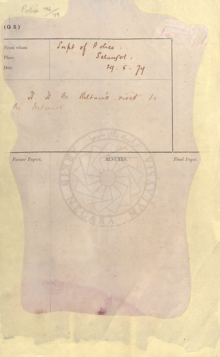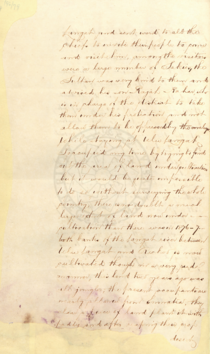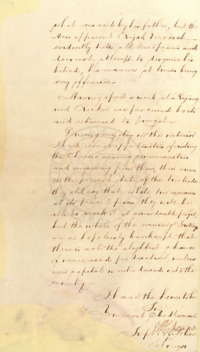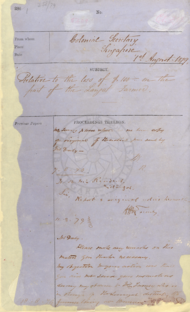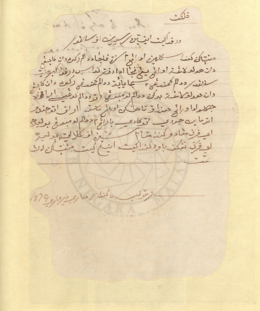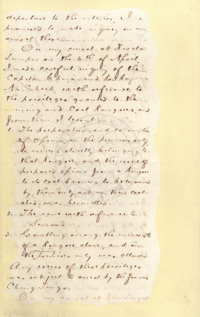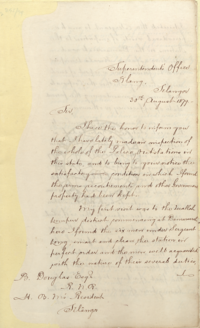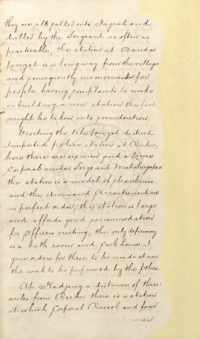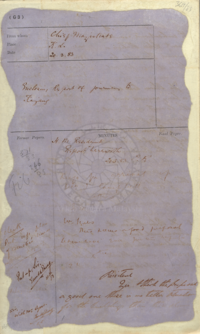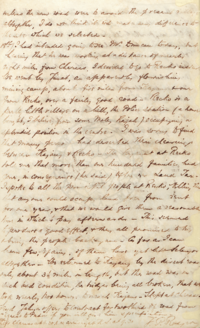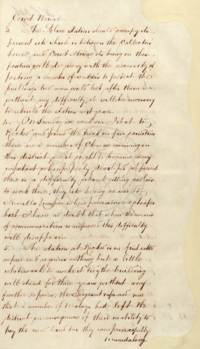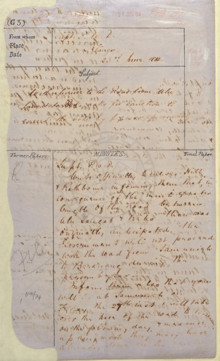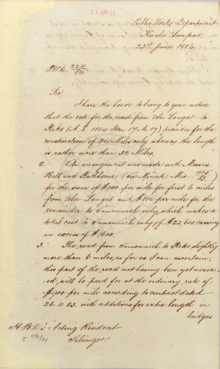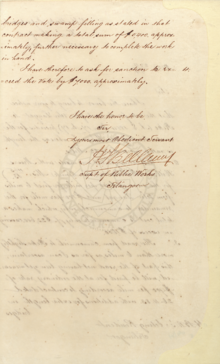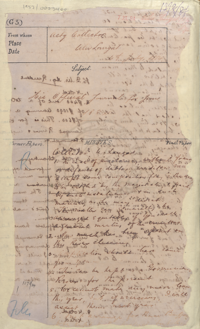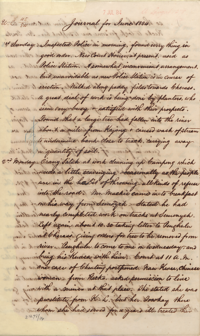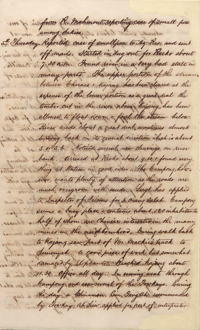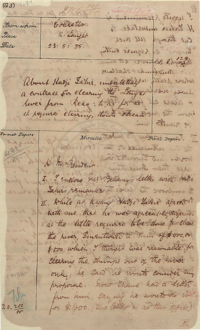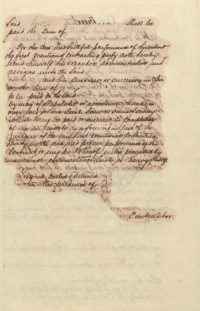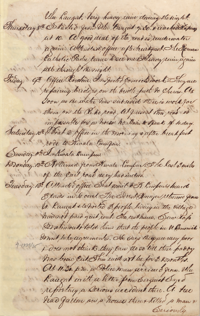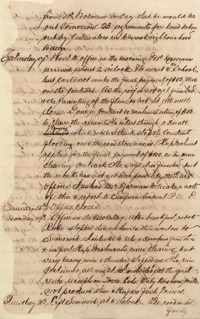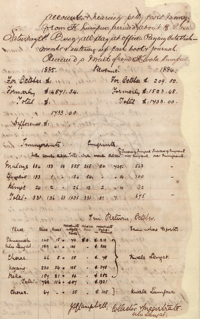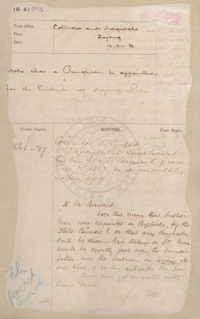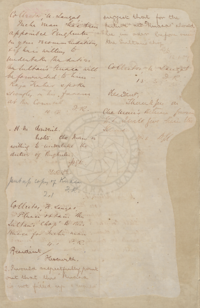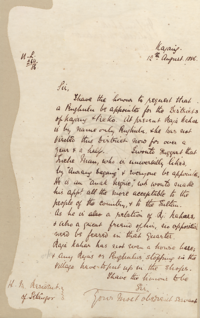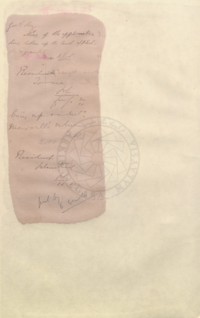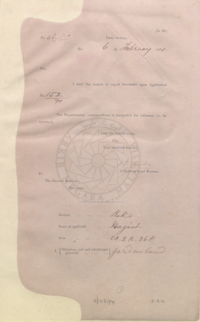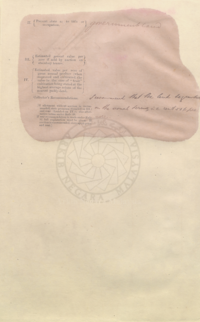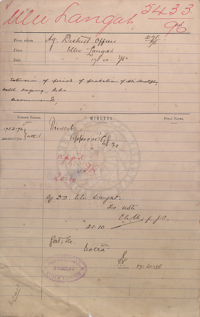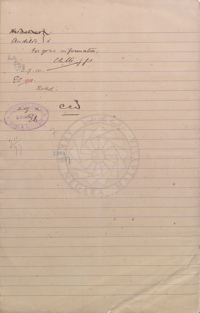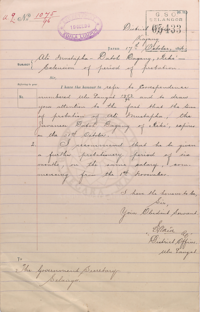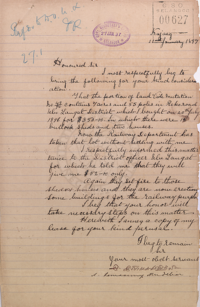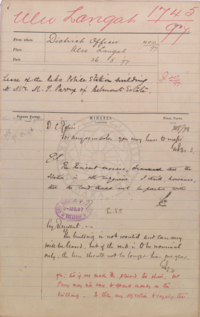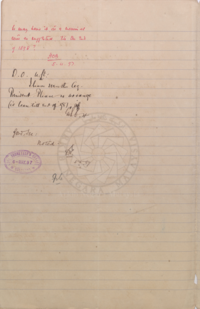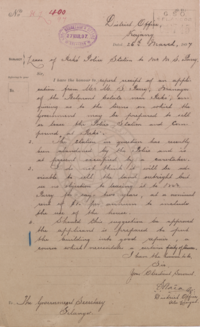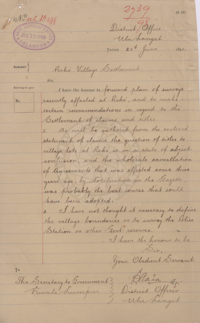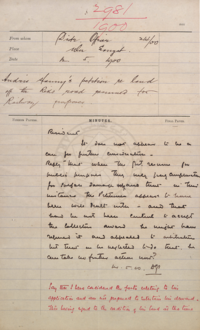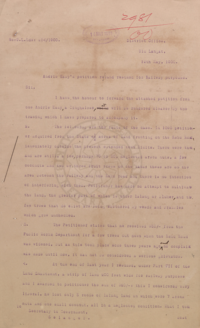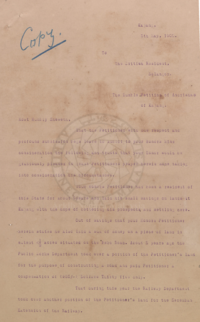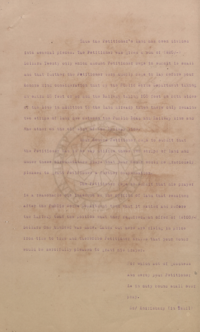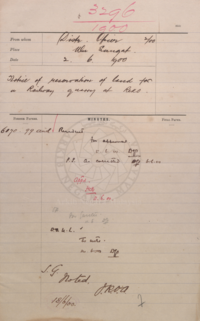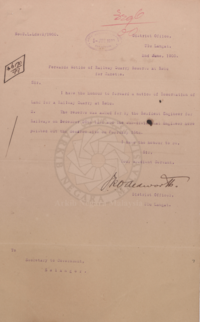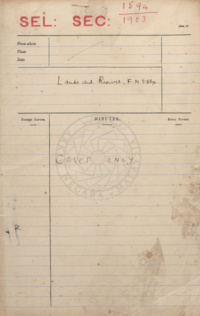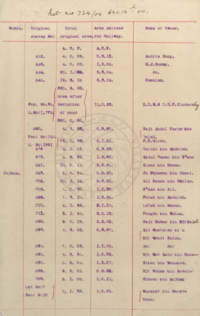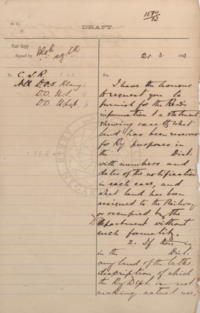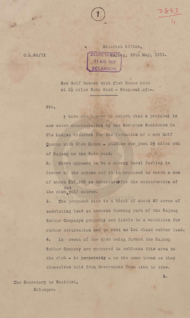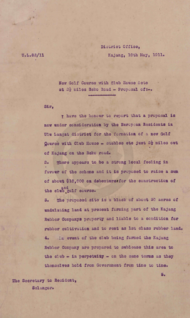Jadual Kandungan
Rekoh
Dirujuk oleh
Perihal
Lokasi
Lokasi Rekoh: “Bila saya baca buku A History of Selangor 1766-1939 oleh J.M. Gullick, saya mendapat maklumat bahawa pada akhir abad ke-19 yang lalu, di hujung Jalan Reko, berhampiran dengan setesyen komuter Bandar Baru Bangi dan UKM yang ada sekarang, ada sebuah pekan kecil bernama Rekoh. Nama Rekoh ini ada dalam peta daerah Ulu Langat (sekarang Hulu Langat) abad ke-19. Sebuah sungai kecil berhampiran dengan UKM dan berhampiran dengan bekas tapak pekan Rekoh sehingga sekarang masih bernama Sungai Rekoh.” (Andin Salleh @ Mohd Salleh Lamry, 2012: |"Dari mana asal nama Jalan Reko?").
“Kajang started as a market place in 1860s where goods and produce were exchanged. Exploration for tin had been the main attraction in pulling migrants from Sumatra and Hakka labourers into Hulu Langat. Earliest recorded site of tin mining was at Rekoh, about 4 km from present Kajang. This is how Jln Reko, the road leading to UKM got its name. Frank Swettenham visited Rekoh in 1875 described the town had been a glorious place.” (Kajang Heritage Centre乌鲁冷岳社区文物馆, 21 April 2020: |"Kajang, a Tin Mining Town").
“Lee (Kim Sin) said much of Kajang’s history dating back to 1850s had been lost – Reko, the oldest settlement traced here, had “the best shops and houses of the time” according to the first British High Commissioner of Malaya Sir Frank Swettenham, but none of that can be seen now.” (Yip Yoke Teng @ The Star, 28 Jan 2019: |"Modern look is a defaced facade").

Lokasi Rekoh (sekitar bulatan hijau), 1904 dan kini.
Kiri: Peta tahun 1904 (Edinburgh Geographical Institute, 1904 @ Yale University Library - Digital Collections: |"Selangor, Federated Malay States, 1904 / John Bartholomew & Co ; W.T. Wood, chief draftman").
Kanan: Peta kini (Mapcarta).
1580-1799: Penerokaan Warga Temuan
Sebagaimana keseluruhan kawasan negeri Selangor amnya, pada mulanya Kajang dan kawasan sekitarnya diterokai dan didiami oleh masyarakat Temuan (Jabatan Kemajuan Orang Asli (JAKOA): |"Suku Kaum Orang Asli Semenanjung Malaysia"). Menurut suatu sumber lisan: “Menurut sumber lisan, Jalan Reko mendapat nama disebabkan kawasan ini dahulunya terdapat banyak buah 'serengkoh'/'serengkung' iaitu buah dari sejenis pokok renik di kawasan ini. Orang asli dari suku Temuan yang mula-mula meneroka kawasan ini telah menamakannya 'Rekoh'. Kini, setelah melalui perubahan masa, perkataan 'Rekoh' telah menjadi 'Reko' sahaja.” (Sekolah Menengah Kebangsaan Jalan Reko, 2020: |"Wawasan Edisi ke-24: SEJARAH SEKOLAH", m.s.15).
Antara tahun-tahun penerokaan sekitar Kajang yang ada disebutkan:-
- 1580: “Perkataan Kajang lahir daripada beberapa sumber berikut : Pendapat Pertama : Adalah dipercayai Kajang telah diterokai oleh orang-orang suku Temuan kira-kira tahun 1580 lagi. Suku inilah yang memberi nama Kajang berdasarkan sejenis mengkuang hutan yang digunakan untuk membuat atap yang tumbuh dengan banyaknya di kawasan itu.” (Majlis Perbandaran Kajang, 2013: |"Asal-Usul Nama Kajang").
- 1709: “Terdapat beberapa cerita lisan berkenaan dengan penerokaan awal pekan Kajang dan kawasan sekitarnya. Menurut orang-orang tua, Kajang dan kawasan sekitarnya sebelum didatangi peneroka-peneroka dari luar adalah merupakan kawasan kediaman orang-orang asli dari Suku Temuan. Menurut seorang pengkaji sejarah tempatan En. Shahabudin Ahmad, Kajang telah diterokai pada tahun 1709 oleh orang-orang asli yang berpusat di Klang. Pada waktu itu Klang diperintah oleh orang-orang asli yang ketuanya dipanggil Batin Seri Alam. Ketua ini mentadbir di Klang kerana ketika itu hutan ini adalah pusat pentadbiran bagi orang-orang asli. Klang mempunyai jajahannya yang tersendiri yang ditadbirkan oleh 3 orang anak kepad Batin Seri Alam.” (Majlis Perbandaran Kajang: |"Info Kajang"). Ada sumber yang mengatakan nama “Kajang” tercipta di pekan Rekoh, yang telah pun wujud sebelumnya: “Ada juga sumber-sumber lain yang menerangkan asal kejadian Kajang. Sumber tersebut menyatakan bahawa suatu ketika dulu terdapat dua orang sahabat menaiki sampan melalui Sungai Langat untuk pergi ke Pekan Reko. Mereka adalah terdiri dari seorang Melayu dan seorang Asli yang mendiami kawasan Reko. Apabila sampai ke Kajang, ( ketika itu belum bernama kajang ), hujan turun dengan lebatnya. Orang Melayu mengajak rakannya ' berkajang ' di situ. Menurut cerita itu ' berkajang ' bagi orang Melayu ialah berteduh, tetapi orang Asli tersebut memahami ' berkajang ' itu sebagai bertikam. Disebabkan salah faham akan maksud rakannya itu maka orang Asli terus menikam rakannya. Dengan perisiwa bertikam itu maka tempat itu dinamakan Kajang.” (MAJLIS PERBANDARAN KAJANG (MPKj), 2006: |"SEJARAH KAJANG").
- 1799: “Terdapat beberapa versi tentang asal-usul Kajang. Hampir semua hipotesis mengenai kewujudan Kajang bertitik-tolak daripada etimologi berdasarkan nama pondok berkajang atap mengkuang yang didirikan oleh peneroka asal. Satu versi mengutarakan bahawa Kajang telah diterokai oleh 'orang asli' suku Temuan pada kira-kira 1580 (versi lain pada 1799) dan merekalah yang menamakan tempat itu 'Kajang'. Varian lain mengisahkan bahawa peneroka itu adalah seorang ketua orang asli bernama Batin Seri Alam atau Batin Berenggai Besi, dari Kelang atau Sungai Ujong.” (Abdur-Razzaq Lubis, 2021: "Tarikh Raja Asal: Derap Perantauan Kaum Mandailing dari Sumatra ke Tanah Semenanjung", m.s.224-225).
CATATAN: “Catatan pada laman web tersebut (Majlis Perbandaran Kajang) diambil daripada pengkaji sejarah tempatan Shahabudin Ahmad, 'Asal Nama Kajang Dan Sekitarnya', Minggu Sejarah Negeri Selangor 16-18 Julai, 1975, Persatuan Sejarah Malaysia Cawangan Selangor (Buku Cenderamata).” (Abdur-Razzaq Lubis, 2021: "Tarikh Raja Asal: Derap Perantauan Kaum Mandailing dari Sumatra ke Tanah Semenanjung", m.s.225).
Selain Hulu Langat, Selangor, terdapat beberapa petempatan di sekitar rantau ini yang turut dinamakan sebagai “Rekoh”. Kebanyakannya terletak di kawasan pedalaman dan diduduki oleh peribumi tempatan:-
| Negara | Negeri | Mukim/Daerah | Petempatan | Penduduk | Rujukan |
|---|---|---|---|---|---|
| Malaysia | Pahang | Lipat Kajang, Temerloh | Kampung Paya Rekoh | Jah Hut, Semoq Beri | Jabatan Perancangan Bandar dan Desa Negeri Pahang, 2018: |Penerbitan -> Profil Daerah -> PROFIL DAERAH PAHANG 2018, m.s.46 Nor Baiti binti Mustafa, 2013: |"Tradisi dan kepercayaan orang Asli Jah Hut di Kampung Penderas, Temerloh", m.s. 6 |
| Malaysia | Johor | Masai, Pasir Gudang | Kampung Rekoh, Sungai Rekoh | ? | Majlis Bandaraya Pasir Gudang: |"Ketua Kampung" Sunway University, 28 September 2021: |"River restoration by Sunway College JB students"). |
| Thailand | Narathiwat | Sukhirin / Su-ngai Padi | Rekoh | ? | Sekitar Kampung Sega (kini sekitar Su-ngai Padi) dan Momang (kini sekitar Sukhirin): “Leaving Kampong Sega about 8.30 a.m. we rode to Rekoh, where I got down to stretch my limbs by walking over the Pass of Dan Popoh. It was about three miles long, and gave us a very pretty walk through moderately open jungle, the track continually crossing and recrossing streams, as it so frequently does in these parts. The path itself would have been a good one, but for one bad swampy patch, where it led through bamboo scrub on the Momang side of the divide.” (C.A. Gibson-Hill, W. W. Skeat & Dr. F. F. Laidlaw @ Journal of the Malayan Branch of the Royal Asiatic Society Vol. 26, No. 4 (164), 1953: |"The Cambridge University Expedition to the North-Eastern Malay States, and to Upper Perak, 1899 - 1900", m.s.92). |
| Indonesia | Kepulauan Riau (Kepri) | Desa Penaga, Teluk Bintan, Pulau Bintan | Kampung Rekoh | ? | Antara News Kepri, 20 Julai 2023: |"Warga Kampung Rekoh Bintan ziarah makam Datuk Julong pada 1 Muharram". |
1820-an: Perlombongan Orang Rawa
Menjelang tahun 1820 (sezaman dengan Raja Busu di Lukut), Juragan Abdul Rahman, seorang pedagang di Selat Melaka, telah membawa sekumpulan orang Rawa ke Linggi. Menantunya Datuk Muda Katas memiliki 5 buah lombong di Rembau dan Sungai Ujong. Menurut Khoo Kay Kim, beliau telah mengeksport hasil timah terus ke London melalui Hong Kong, tanpa melalui Singapura atau Pulau Pinang. Orang Rawa dibawa masuk bekerja lombong di sekitar Sungai Linggi (dahulu dikenali sebagai Batang Penar), menggunakan kaedah lampan (perlombongan cara tradisi). Namun sebahagian daripada mereka ini bergiat dalam aktiviti lanun dan rompakan. Oleh sebab itu, bagi menjaga keselamatan awam, Datuk Muda Katas menguatkuasakan semula undang-undang sungai di Sungai Linggi, yang menyatakan bahawa tiada kapal/perahu boleh belayar dari Maghrib sehingga Subuh. Pelanggaran terhadap larangan ini dihukum mati.
Sekitar tahun 1825-1826, Raja Labuh telah menggantikan Yamtuan Lenggang sebagai Yamtuan Besar Negeri Sembilan. Beliau bersikap prejudis terhadap orang Rawa, kesan pengalaman berperang dengan mereka. Ketika pemerintahannya, beliau telah menyerang dan menghalau seluruh orang Rawa keluar dari kawasan Rembau. Berikutan itu, kebanyakan orang Rawa melarikan diri ke bahagian utara, di sekitar Sungai Langat, meliputi daerah Rekoh, Beranang, dan Semenyih. Akibat daripada tindakan ini, beliau kemudiannya telah dimakzulkan (diturunkan takhta).
(Sumber: Mohd Khairil Hisham Mohd Ashaari, 23 September 2023: "Wacana Sejarah Hulu Langat 2023: Peranan Syed Abdul Rahman di Rekoh Semasa Perang Rawa 1848: Berdasarkan Laporan Douglas").
Menurut sumber-sumber lain:-
“Aktiviti melombong bijih timah di Kajang bermula di satu kawasan iaitu Reko atau Rekoh yang kini dikenali Kampung Sungai Tangkas yang menjadi daerah paling awal menjalankan aktiviti itu berbanding Kuala Lumpur. Di situ (Reko atau Rekoh) terdapat lombong dan masyarakat Mandailing tinggal di kawasan berkenaan. Orang Mandailing mengetuai aktiviti melombong bijih timah dan menjadi masyarakat pertama menjalankan aktiviti itu sekitar lewat 1840-an atau awal 1850-an.” (Lee Kim Sin @ Harian Metro, Ogos 11, 2017: |"Bijih timah jutaan tahun").
“In Ulu Langat as in many parts of the Malay States, the first stir of commercial activity began with tin mining. An American prospector probably attempted mining for tin at Reko near Kajang in the 1840s (Wong, 1965: 32). This venture was soon abandoned and taken over by some Chinese.” (Voon Phin Keong @ Malaysian Journal of Chinese Studies, Volume 2, No.2, 2013: |"Transforming the Development Frontier: Chinese Pioneers in the Ulu Langat District of Selangor, Malaysia", m.s.7-8).
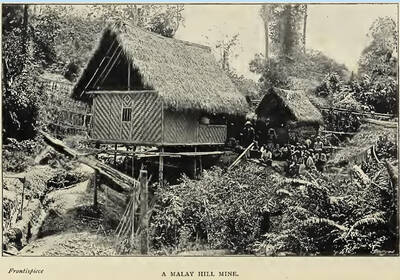
Lombong lampan (Kinta Tin Mining Museum, 10 April 2021: |"Mining method: Lampan (Ground Sluicing)").
1830-an: Pembukaan Kajang
Sementara itu, sekitar tahun 1830-an, terdapat beberapa riwayat pembukaan Kajang (di sebelah utara Rekoh), melibatkan To' Lili (Bugis dari Riau), dan Raja Berayun (dari Mandailing).
MAKLUMAT LANJUT: 1830-an: Pembukaan Kajang
1830-an: Pemukiman Raja Berayun
Latar Penghijrahan: Perang Padri (1816-1833)
Sejarah awal Raja Berayun (serta petempatan pertamanya, Rekoh) boleh dijejaki mulai dengan penghijrahan golongan Mandailing dari Sumatera pasca Perang Padri (1816-1833):-
“Sewaktu Perang Padri (1816-1833) berkecamuk di Sumatra, angkatan Minangkabau menyerbu Mandailing-Natal, kampung halaman bangsa Mandailing. Di mana-mana saja berlaku penjarahan dan kerusakan harta benda. Pihak kolonial Belanda melancarkan pula sistem eksploitasi ekonomi yang menyebabkan rakyat lebih melarat, sengsara dan miskin-papa.
Lantaran situasi yang tidak lagi dapat menjamin kelangsungan hidup, mereka terpaksa pindah secara besar-besaran ke Malaysia Barat kini atau Selangor khususnya yang disebut mereka sebagai “Kolang”. Perpindahan massal mereka itu dalam abad 19 merupakan pola migrasi yang mendekati proporsi exodus.
Orang Mandailing yang sampai di Selangor (Kolang) mendirikan pemukiman , “mamungka huta”, mengikut istilah mereka di pedalaman negeri Selangor. Bahagian pesisirnya, yang telah didiami oleh etnik Nusantara yang lain, sedapat-dapatnya dihindari. Perbukitan dan lembah yang menghijau, cuaca yang sejuk menyegarkan seperti di Luat Mandailing, keadaaan yang aman di pedalaman merupakan salah satu faktor yang menarik mereka tinggal di tempat yang jauh dari pesisir. Salah satu pemukiman keturunan suku Mandailing di pedalaman terdapat seputar Kajang. Pemukiman ini tekenal dengan nama Sg Kantan yang mungkin berupa kependekan Pakantan,suatu huta Mandailing hampir Kotanopan di Mandailing Julu dan yang warganya mayoritas Marga Lubis.”
(Sumber: Haji Hanafiah Kamal Bahrin Lubis, 23 Ogos 2014: |"HORAS ! SEPUTAR DAN BERPUTAR-PUTAR DI JALAN RAJA ALANG,KAJANG,SEL.").
“The Padri raids and invasions into Rao, Mandailing and Angkola, Padang Lawas and the 'Bataklands' (circa 1816-1831), as well as Padri occupation (circa 1820-1835), resulted in the flight of political and economic refugees, as well as forced migration through slave trafficking. Notable events included the Padri destruction of Panyabungan in 1825, and the major Padri invasions which were carried northwards to the Toba lands in 1827 and 1829. Raja Barayun, who hailed from Pidoli Lombang near Panyabungan, could have migrated after 1825 following the devastation of his homeland.” (Abdur-Razzaq Lubis, 2018: "Sutan Puasa: Founder of Kuala Lumpur", m.s.125).
Penghijrahan
“Dulu “Recko ” merupkan satu lagi pemukimannya Mandailing seputar Kajang (kini Reko) .Raja Borayun ,Pendiri Kajang,pada suatu waktu,pernah menjadikan “Recko”basis ataupun bentengnya di pinggir Batang/Sungai Langat.Di sini telah bermukim warga imigran Mandailing yang substansial sekitar pertengahan abad 19 dahulu.
…
Pada umumnya turunan Mandailing marga Nasution dan Lubis tinggal di seputar Bandar Kajang, di samping marga Harahap dan Siregar (*Serigar). Masyarakat Mandailing itu dipimpin oleh Raja Borayun putera Mangaraja Tinating ,marga Nasution ,asal Pidoli Lombang, Mandailing Julu. Salah seorang cucu-cicitnya, Raja Ayub putra Raja Harun putra Raja Hidayat putera Raja Borayun menetap di rumah pusaka yang dibina Raja Harun di Lot 6747, Batu 14, Jalan Cheras, 43000 Kajang. Pusara Encik Nyonya Cantik, isteri Raja Borayun,ompung godang Raja Ayub,terdapat di Perkuburan Islam, Batu 14, Kajang.
Seperti dicatat sebelumnya, Raja Borayun merupakan namora atau raja Mandailing yang menjadi pimpinan komunitas Mandailing di Kajang dalam abad 19. Beliau dianugerahi gelar Tengku Panglima Besar oleh Sultan Abdul Samad yang mulai bersemayam di atas takhta Selangor pada tahun 1857.Raja Mandailing ini, turunan Mangaraja Saoloon Pidoli Lombang , merupakan pemain yang cukup penting di atas panggung politik Negeri Selangor dalam abad 19.
Besar kemungkinan, Raja Borayun sudah menetap di Kolang/Selangor sebelum Sutan Puasa (Sutan Na Poso) sampai di Kolang dari Tobang, Mandailing Julu kira-kira dalam tahun 1830-an. Kemungkinan juga seorang tokoh Mandailing yang lain, Ja Marabun Rangkuti (Bendahara Raja gelar Melayunya) mendampinginya dalam perjalanan ke Kolang. Bendahara Raja ternyata pertama kali menetap di Selangor sewaktu Sultan Muhammad bersemayam (1826-1857) (A.R. Lubis)”
(Sumber: Haji Hanafiah Kamal Bahrin Lubis, 23 Ogos 2014: |"HORAS ! SEPUTAR DAN BERPUTAR-PUTAR DI JALAN RAJA ALANG,KAJANG,SEL.").
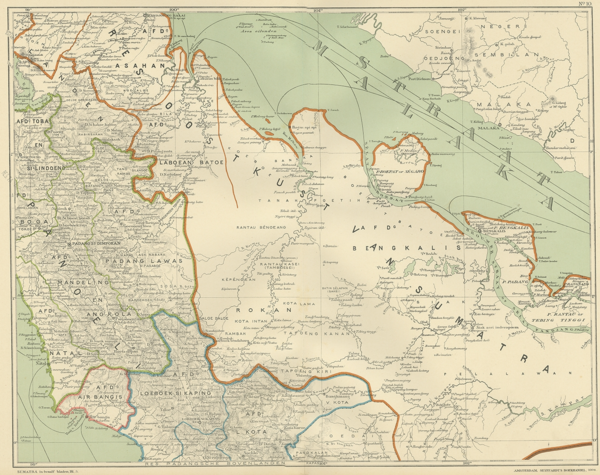
Peta sebahagian Sumatera (Riau dan sekitarnya) dan Tanah Melayu (termasuk Mandailing-Natal, Rokan (Rambah-Tambusai), dll, sekitar 1900-an, sebagai ilustrasi perantauan orang-orang Sumatera ke Tanah Melayu: “Antique map of the East Coast of Sumatra. Also depicting the Strait of Malacca. This map originates from ‘Atlas van Nederlandsch Oost- en West-Indië’ by I. Dornseiffen.” (Seyffardt’s Boekhandel, Amsterdam, 1904 @ Bartele Gallery: |"MAP OF THE EAST COAST OF SUMATRA – DORNSEIFFEN C.1900").
LATAR PERISTIWA: Raja Berayun / Borayun / Brayun / Jabarayun
LATAR PERISTIWA: Raja Alang bin Raja Berayun
1848: Perang Rawa
WS-HL-2023-S2: Peranan Syed Abdul Rahman di Rekoh Semasa Perang Rawa 1848: Berdasarkan Laporan Douglas (Perbadanan Perpustakaan Awam Selangor, 23 September 2023: Sumber rakaman asal (tidak lagi disiarkan)).
Ringkasan pembentangan: WS-HL-2023-S2: Peranan Syed Abdul Rahman di Rekoh Semasa Perang Rawa 1848: Berdasarkan Laporan Douglas.
Sekitar tahun 1848, Dato Kelana Sendeng, ketika itu penghulu Sungai Ujong, juga seorang yang bersikap prejudis terhadap orang Rawa. Dalam suatu kes yang tidak dapat dikenalpasti puncanya, beliau telah menangkap 3 orang Rawa lalu dijatuhkan hukuman mati. Pemimpin Orang Rawa di bawah Raja Berayun di Rekoh memohon Dato Kelana Sendeng untuk melepaskan atau meringankan hukuman, namun ditolak. Ini mencetuskan kemarahan orang Rawa di situ, dan sentimen ini telah merebak ke Klang dan juga Pahang.
Rentetan itu, Raja Berayun telah menemui Syed Abdul Rahman (beliau juga tinggal di Rekoh ketika itu), untuk mendapatkan bantuan dalam serangan terhadap Dato Kelana Sendeng. Syed Abdul Rahman ketika itu adalah musuh Dato Kelana Sendeng (sebelum ini beliau ingin jadi Dato Kelana, tetapi gagal). Beliau bersetuju membantu (kemungkinan dari sudut kewangan), dengan syarat orang Rawa mesti menyokong beliau untuk menjadi Dato Kelana bagi menggantikan Dato Kelana Sendeng kelak. Maka perlakulah perang saudara Rekoh-Sungai Ujong (perang besar bagi orang Rawa, kerana menentang keseluruhan luak, bukan Dato Kelana Sendeng saja).
Sementara itu, sebilangan orang Rawa di bawah Tuanku Tambusai di Rasah, Sungai Ujong, tidak menyokong orang Rawa Syed Abdul Rahman di Rekoh, lalu membantu Dato Kelana Sendeng. Pada akhirnya, orang Rawa Rekoh kalah, dan Syed Abdul Rahman pun kembali ke Rekoh. Penglibatan awal Syed Abdul Rahman dalam konflik ini mungkin ada kesinambungannya dengan konflik tahun 1874 yang menyebabkan perjanjian beliau dengan British pada tahun 1874, diikuti Pemberontakan Rekoh (Rekoh Wreckage) pada tahun 1875 yang diakhiri dengan perjanjian damai dengan Sultan Abdul Samad, seterusnya perjanjian penyerahan Rekoh dan Semenyih (kepada Selangor) serta Lukut (kepada Sungai Ujong) pada tahun 1878.
(Sumber: Mohd Khairil Hisham Mohd Ashaari, 23 September 2023: "Wacana Sejarah Hulu Langat 2023: Peranan Syed Abdul Rahman di Rekoh Semasa Perang Rawa 1848: Berdasarkan Laporan Douglas").
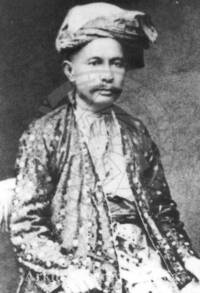
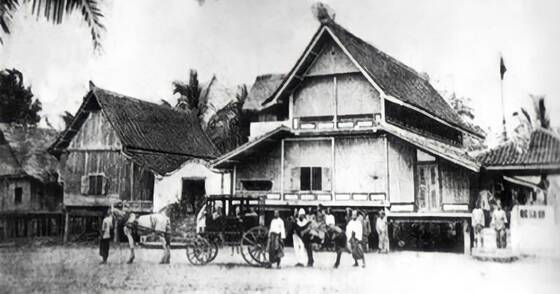
Kiri: Syed Abdul Rahman, 1879 (Arkib Negara Malaysia 2001/0026749W, 31/12/1879: |"DATO KELANA PETRA SYED ABDUL RAHMAN OF SUNGAI UJONG, SINGAPORE; C.1879").
Kanan: “Rumah kediaman Datuk Kelana Sungai Ujong, Sayyid Abdul Rahman pada tahun 1874. (Arkib Negara Malaysia)” (Legasi Pemikir - LEKIR, 24 Januari 2021: "Rumah kediaman Datuk Kelana Sungai Ujong").
Dari sumber-sumber lain:-
“Menjelang tahun 1848, Raja Borayun berhasil menjalin hubungan yang rapat dengan pembesar-pembesar Bugis yang berpengaruh di istana Selangor. Dalam pada itu beliau berhasil menggalang angkatan hulu-balangnya yang merupakan kesatuan kombatan yang kuat. Menyadari posisinya yang bertambah kuat itu, pada tahun 1848 Raja Borayun menyerang Sg. Ujong (Seremban) sebab Dato Klana Sendeng tidak membayar “duit nyawa” (blood money) sejumlah $400 atas terbunuhnya seorang anak buahnya. Tentu saja masuk akal serangan itu diatur dan dilancarkan dari “Recko”, pangkalan dan pemukiman Mandailing di Selatan Kajang yang tidak jauh dari Seremban.”
(Sumber: Haji Hanafiah Kamal Bahrin Lubis, 23 Ogos 2014: |"HORAS ! SEPUTAR DAN BERPUTAR-PUTAR DI JALAN RAJA ALANG,KAJANG,SEL.").
Peristiwa serangan Raja Brayun terhadap Datoh Klana Sendeng, menurut anak beliau, Raja Alang (melalui wawancara dan tulisan J.C. Pasqual): “At this time Raja Brayun, a Mendeleng from Sumatra, invaded Sungei Ujong and attacked Datoh Klana Sendeng, because a friend of Raja Brayun was murdered and Datoh Klana Sendeng refused to pay the blood money of $400 according to the 'adat' Malayu. On the side of Raja Brayun there was Panglima Garang and Panglima Si Gara, both 'invulnerable' and fierce warriors, besides 500 fighting men. But he was defeated although he had bribed one of Datoh Kalan Sendeng's men with $3,000 to burn the granaries and blow up a powder magazine. Raja Brayun then retired to Recko, a village on the Langat river a short distance upstream from Kajang, and invited Raja Abdulsamad to live with him. He built a stockade at Recko and had a large force of fighting men who lived by robbery and raiding Sakais to sell them into slavery.” (The Straits Times, 11 November 1934, Page 21: |"WHEN COCKFIGHTING WAS THE RAGE").
“Thomas Braddell in his note on the history of Negeri Sembilan enclosed with SS Despatch to the CO dated 29th December 1874, reveals the involvement of the Rawa (Rao) and Mandailing in the Rawa War of 1848. The latter were in Sungai Ujong (Seremban today) following the wake of the Padri War (1816-1833).
” The Rawa disturbances in 1848 are of sufficient importance to justify a few words giving an account of another and a most serious misfortune to the Sungai Ujong mine.
“ The Rawa are an adventurous people with a strong turn for trade, living to the north east of the Pagarooyong (Menangkabowe) district, in the middle of Sumatra. They have long been in the habit of trading to the Peninsula, and have established Colonies in several places, the most important of which was at Pahang, where they almost monopolized the trade. The superiority of these people over the ordinary Malay give rise to jealousies which require them to be on their guard, and to combine for mutual protection, so that when any of the tribe are injured the rest are bound to assist in protecting them, a feature in their character which adds to the dislike of them entertained by the Malays; but being like the Chinese, good colonists, they are allowed to remain in the Malay countries.
” Causes of. - A number of the tribe had settled in Sungei Ujong, and were getting the chief portion of the local trade in their hands where three of them were put to death by the Klana for an alleged offence. The justice of the execution was denied by the trio, and they determined to exact vengeance. Assistance was sent for to Pahang, their head quarters, and open war was declared. This was said to have been the pretext for the war, but the truth probably was, that the many differences and jealousies between the two races had brought matters to such a state that it required very little to bring on a war.
“ Result of. - The Rawa proved their individual superiority over the Malays during the war. But being few in numbers and distant from their resources they were at last obliged to retire; and they have not since been allowed to return to the country. The Rawas who are now in Sungei Ujong are said to be Tamoosai Rawas, and do not mix with the others, Rawa Ulu (or up country Rawas); in fact the Tamoosais sided with the Klana.”
Here in this passage we have the first mention of the presence of the “Tamoosai” in the Peninsula in the second quarter of the 19th century. There were probably two groups of people from Rao - the Mandailings and the Rao. Rao is the frontier country between Minangkabau and Mandailing. The Rao or “orang Rawa” as they are known in the Peninsula and in East Sumatra. The “Tamoosai Rawas” were Rawa from Tambusai, while Rawa Ulu (or up country Rawas) were probably Mandailing, whose homeland was to the north of Rao. Of course, this does not discount the Tambusai's presence, a distinct group in themselves.
The Mandailing involvement in the “Sungei Ujong” affair was confirmed by J.C. Pasqual who wrote about the episode in 1930s based on an account from “Raja Allang ibni Raja Brayun, who was a Forest ranger of the Ulu Langat district in the late 'eighties (1880's)”. He implied that the Mandailings were not on the side of Dato' Klana but against him.
“ At this time Raja Brayun, a Mendeleng from Sumatra, invaded Sungei Ujong and attacked Datoh Klana Sendeng, because a friend of Raja Brayun was murdered and Datoh Klana Sendeng refused to pay the blood money of $400 according to 'adat' Malayu. On the side of Raja Brayun there was Panglima Garang and Panglima Si Gara, both 'invulnerable' and fierce warriors, besides 500 fighting men. But he was defeated although he had bribed one of Datoh Klana Sendeng's men with $3,000 to burn the granaries and blow up a powder magazine. Raja Brayun then retired to Recko, a village on the Langat river a short distance upstream from Kajang, and invited Raja Abdulsamad to live with him. He built a stockade at Recko and had a large force of fighting men who lived by robbery and raiding Sakais to sell them into slavery.”
Mandailings as well as Rawas raided Orang Asli and sold them into slavery. This is not to say that historically all Mandailings and Rawas were a party to this. Other Mandailings were also noted in British records as having employed Orang Asli.“
(Sumber: Abdur-Razzaq Lubis dll @ mandailing.org, 2004-2006: |"The Rawa War of 1848").
1853: Tempat Perlindungan Raja Abdul Samad
Sekitar tahun 1853, Rekoh menjadi tempat perlindungan Raja Abdul Samad (10 tahun sebelum pertabalannya sebagai Sultan Abdul Samad pada tahun 1863):-
“Namun pada tahun 1853, istana Selangor digemparkan dengan kemangkatan mengejut ketiga-tiga putera sultan yang sedang berselisihan faham mengenai takhta diraja Selangor tanpa diketahui sebab-musababnya. Namun begitu tidak lama selepas itu sebuah angkatan tentera Bugis Selangor telah diarahkan menangkap anak saudara Sultan Muhammad Shah yang bernama Raja Abdul Samad yang juga merupakan menantunya setelah Raja Abdul Samad dikahwinkan dengan puteri baginda yang bernama Raja Aftah. Raja Abdul Samad pada masa itu tinggal di Langat bersama dengan bapanya Raja Abdullah bin Sultan Ibrahim Shah yang diberikan hak untuk menjaga dan mengutip cukai di sana. Apabila mendapat tahu dirinya diburu, Raja Abdul Samad pun meninggalkan Langat dan berlindung kepada Jabarayun di Kampung Reko. - The Sunday Times, 2 Dec 1934.
Apabila mendapat tahu Raja Abdul Samad sedang berlindung dengan Jabarayun di Ulu Sungai Langat, Sultan Muhammad Shah memberi amaran dan memerintahkan Jabarayun agar jangan campur tangan dengan memberi perlindungan kepada Raja Abdul Samad. Tetapi Jabarayun langsung tidak mengendahkannya. Lantaran itu Sultan Muhammad Shah pun mengarahkan angkatan tentera Bugis supaya bersiap-sedia dengan 500 perahu perang di Kelang untuk menyerang Jabarayun di Kampung Reko.
‘Recko was located in Selangor on the Langat River, but within a few miles of the Sungei Ujong border.’ (121) – Burns (The Journal of J.W.W. Birch)
Apabila mendapat tahu angkatan tentera Bugis Selangor sedang dalam perjalanan untuk menyerang Kampung Reko, Jabarayun bersiap-sedia dengan 300 pengikutnya yang bersenjatakan kapak dan beliung. Jabarayun dan panglima-panglimanya merancang untuk menebang pokok-pokok tinggi di tengah hutan untuk merentangi Sungai Langat dan menghalang kemaraan perahu-perahu angkatan tentera Bugis. Dengan cara itu orang-orang Jabarayun boleh meluru untuk membunuh tentera-tentera Bugis yang terperangkap di tengah-tengah sungai itu.
Rombongan tentera Bugis itu bertolak dari Kelang dan memudiki Sungai Langat sehingga sampai dekat Kampung Dengkil sebelum berpatah balik ke Kelang secara tiba-tiba tanpa diketahui sebabnya. Akhirnya tiada serangan yang berlaku. Sejak itulah nama Jabarayun menjadi terkenal dan berpengaruh serta sangat ditakuti oleh pembesar-pembesar Bugis Selangor.”
(Sumber: Mohamed Azli bin Mohamed Azizi @ Lembaga Adat Mandailing Malaysia (LAMA): |"Kuala Lumpur Siapa Punya?").
“Kuasa dan wibawa Raja Borayun makin terkonsolidasi setelah beliau berhasil memukul mundur angkatan yang bakal menyerangnya di “Recko” tanpa tempur berkuah darah. Awalnya Raja Borayun dimurkai Sultan Muhammad sebab menjalin persahabatan yang akrab dengan Abdul Samad, keponakan dan menantu Sultan. Lantaran tidak menghiraukan kemurkaan Sultan, beliau menghadapi serangan angkatan Istana Selangor yang kiranya akan menghabisinya sama sekali.
Angkatan istana sejumlah 500 buah perahu digalang di Kajang. Raja Borayun yang berada di “Recko” akan diserang dari sungai. Mujurlah Strategi Raja Borayun berhasil mematahkan serangan yang berbahaya dan mematikan itu.Kombatan Mandailing yang heroik sejumlah 300 orang menebang pohon kayu dan merintangkannya di tengah sungai. Apabila perahu yang membawa angkatan penyerang terbentur di tengah sungai, mereka akan diamuki dan dibantai semuanya. Menyadari peristiwa pembantaian berkuah darah yang bakal menimpa, para penyerang puntang-panting mendayung perahu kembali ke Kajang.”
(Sumber: Haji Hanafiah Kamal Bahrin Lubis, 23 Ogos 2014: |"HORAS ! SEPUTAR DAN BERPUTAR-PUTAR DI JALAN RAJA ALANG,KAJANG,SEL.").
Peristiwa serangan Sultan Muhammad terhadap Raja Brayun di Rekoh, menurut anak beliau, Raja Alang (melalui wawancara dan tulisan J.C. Pasqual): “In the reign of Sultan Mahomad he was afraid of Raja Abdulsamad (afterwards Sultan), his cousin, who he suspected would betray him and usurp the throne, and for this reason he ordered the arrest of Abdulsamad who field(fled) to Kajan(g), a village higher up the Langat river, and settled there. At this time Raja Brayun, a Mendeleng from Sumatra, invaded Sungei Ujong and attacked Datoh Klana Sendeng, because a friend of Raja Brayun was murdered and Datoh Klana Sendeng refused to pay the blood money of $400 according to the 'adat' Malayu. On the side of Raja Brayun there was Panglima Garang and Panglima Si Gara, both 'invulnerable' and fierce warriors, besides 500 fighting men. But he was defeated although he had bribed one of Datoh Kalan Sendeng's men with $3,000 to burn the granaries and blow up a powder magazine. Raja Brayun then retired to Recko, a village on the Langat river a short distance upstream from Kajang, and invited Raja Abdulsamad to live with him. He built a stockade at Recko and had a large force of fighting men who lived by robbery and raiding Sakais to sell them into slavery. When Sultan Mahomad heard that Abdulsamad was living with Raja Brayun he sent a warning to Raja Brayun not to shelter Abdulsamad or have anything to do with him. As Raja Brayun paid no heed to his warning, the Sultan fitted up an expedition of 500 prahus from Kajang to attack Recko, and everybody warned Raja Brayun to be on his guard. On his part, Raja Brayun got together 300 men with axes and bliongs with orders to fell the forest across the river on hearing the report of a gun, and to run amuck and massacre Sultan Mahomad's men if they attempted to cut through the blockade. Nothing happened as the expedition returned to Kajang.” (The Straits Times, 11 November 1934, Page 21: |"WHEN COCKFIGHTING WAS THE RAGE").
1855: Pelombong dari Amerika
”…dikatakan ada orang Amerika yang telah membuka lombong bijih di Sungai Tangkas yang letaknya tidak jauh dari Rekoh dengan pengikutnya kira-kira 60 orang Orang Hitam. Akan tetapi mereka telah diserang oleh penduduk tempatan. Tiga orang orang Amerika dan setengah dozen buruh telah dibunuh dan rumah mereka telah dibakar. Pelombong yang lain berpindah untuk sementara ke Bagan Terendah, sebelum meneruskan usaha melombong di Kuala Langat.“ (Andin Salleh @ Mohd Salleh Lamry, July 18, 2013: |"Pekan Rekoh yang sudah lenyap").
Ringkasan Peristwa
“Pada akhir 1840an kira-kira sedozen orang putih Amerika bersama pengikutnya seramai 60 orang hitam (hamba Habsyi) datang ke Rekoh* (sekarang Reko berdekatan Kg. Sungai Tangkas - UKM Bangi) iaitu 6 batu dari sempadan Selangor - Sg. Ujong. Mereka memulakan operasi perlombongan yang berjaya di Rekoh. Bagaimanapun mereka tidak meminta izin dan berunding dengan Tok Perkasa (Tok Pawang Besar) yang kemudiannya mengadu hal tersebut pada Tok Bandar Lili (Pembesar Kajang) mengenai pelanggaran hak istimewanya (sebagai pembuka lombong) dan sikap kurang ajar pendatang asing membuka lombong tanpa kebenarannya. Tok Bandar Kajang bersimpati dengan beliau dengan itu beliau berpakat dan mengarahkan empat atau lima “orang Tambusai” membuat amuk. Serangan nekad itu berlaku pada waktu malam. Orang - orang Tambusai membakar rumah kongsi pelombong Amerika dan menikam apabila mereka keluar untuk cuba menyelamatkan diri. Orang - orang Tambusai berhasil membunuh tiga orang putih Amerika dan enam atau tujuh daripada kuli orang hitam mereka juga dibunuh. Yang terselamat melarikan diri dan berlindung seketika di Bagan Terendan dekat Pasangan, dan kemudiannya akhir mereka melarikan diri ke hilir ke Kuala Langat.
* Rekoh sebuah pekan perlombongan dibuka orang Melayu yang punya pekan, perkampungan, balai polis, hospital dan juga punya pengkalan yang kemudian lenyap dari sejarah, terutama apabila kuasa ekonomi perlombongan Melayu musnah apabila tamatnya Perang Saudara Selangor dan kemasukan British Selangor pada 1874. Dalam banyak catatan juga di eja sebagai Reko, Recko, Rakoh, nama tempat ini juga wujud di Sumatera Barat.
* Orang Tambusai - adalah gelaran bagi pengikut Tuanku Tambusai yang berhijrah ke Sg. Ujong dan Semenanjung daripada daerah Rokan Hulu, Riau Sumatera. Keturunan Tambusai di Hulu Langat masih menetap di sekitar Kampung Jenderam, Sg. Merab dan Kampung Bangi.
- Kisah ini punya dua versi berlainan- satu lagi adalah versi Raja Berayun mengarahkan ratusan pengikut membuat amuk pada 1850an. Sumber ini diterjemahkan dan disusun semula daripada buku Selangor Journal & Sutan Puasa Founder Of Kuala Lumpur. Catatan ajaizainal.”
(Sumber: Faizal Zainal @ Facebook Pekan Bangi, 11 Ogos 2025: "Sejarah Daerah Kita: Amuk Di Rekoh").
Sumber akhbar
- “Looking through the Selangor Journal the other day, I came upon what is perhaps the most extraordinary episode in the history of European penetration of Malaya. Somewhere about the year 1855 a party of twelve Americans and 60 Orang Hitam (negroes) sailed up the Langat river, in Selangor, took possession of the village of Reko, and began mining at a place called Sungei Tangkas. They neglected, however, to obtain the permission of the district chief, with the result that the Malays launched a night attack, killed three Americans and six or seven negroes, and set fire to the wooden house in which they were living. The survivors fled downstream and made a fresh settlement near Passangan, but after a short stay they left the Langat river and were never heard of again.” (The Straits Budget, 7 February 1935, Page 6: | "AMERICANS AT REKO").


“An American prospector started a tin mine at Rekoh in 1855. However, the locals objected as he did not possess any consent and the venture was abandoned. There were altercations and eventually, the Americans left.” (AKU BUDAK TELOK, Jun 15, 2021: |"KISAH SULTAN DAN NEGRO DI JUGRA DAN REKOH").
Sumber asal
“TRADITIONS OF ULU LANGAT
The following incidents are taken from statements made by Penghulus Raja Mahmud, of Semenyih, Said Yahya, of Cheras, and Jahya of Kajang, respectively, concerning the origin of the various settlements under their charge, and may be of interest to your readers. Of course I cannot be responsible for the statements made but have collected the information as it was otherwise likely to be lost, and as it may prove of some slight assistance to some future compiler of a history of the State. …..” (1897: The Selangor Journal: Jottings Past and Present, Volume 5, hlm.305-306).
“The Penghulu of Kajang states that Kajang is about 120 years old, and that it was founded by Toh (then Inche Lili, of Rio, under authority from Sultan Mohamad ibni-el Marhum Sultan Ibrahim, who had brought him as one of his following from Rio to Selangor. …..” (1897: The Selangor Journal: Jottings Past and Present, Volume 5, hlm.306-307).
“Before this, however, about a dozen Americans, with a following of some 60 Orang Hitam (“Blacks,”) came upstream, took possession of Rekoh, and started successful mining operations at Sungei Tangkas (The date of the American settlement at Rekoh may perhaps be roughly put at 1855). As, however, they had not consulted the Toh Perkasa, otherwise known as Toh Pawang Besar (the “Great Medicine-man”), the latter sought out Toh Bandar Lili and complained bitterly of their infringement of his privilege (of “opening” mines). The Toh Bandar appeared to sympathise with him, and he therefore conspired with four or five “orang Tembusai”, who after two or three days' interval “ran amuck” at the Americans by his orders, with the result that three of the Americans, and six or seven of their native followers were killed, the attack taking place by night, so that the assailants were able without difficulty to set fire to the house (which was built of planks) and stab the inmates as they came out. The survivors fled and established themselves for a time at Bagan Terendah near Pasangan, and subsequently made their way downstream to Kuala Langat. Subsequently the Toh Pawang (Perkasa) died at about 65 years of age and was buried at the “Old Farm” (Pajak Lama), near Rekoh, leaving behind a son named Pah Sirum, who is said to live at Lengging. The deceased was of great fame throughout the country and was reputed to have the power of turning stone into ore, and vice versa.” (1897: The Selangor Journal: Jottings Past and Present, Volume 5, hlm.307).
Sumber makalah
“The Langat valley witnessed one of the most unusual episodes in the history of tin mining of this period, It began in the late 1840's with the arrival of an 'American gentleman' to inspect the thriving tin mines in Malacca territory; he went on to look at mining prospects 'in the Malayan states to the north and south,' and produced a 'very favourable' report likely to be 'duly appreciated by his enterprising countrymen, whose habit it is to plunge in medias res.'[28] However some years elapsed before 'about a dozen Americans with a following of some 60 Orang Hitam ('Blacks')' opened a mine at Sungei Tangkas near Rekoh (Ulu Langat) from which they 'got a considerable quantity of ore.' Even twenty years later their abandoned mine was 'a huge pond' with the remains of a 'good road' from the mine to Rekoh. However they did not employ the services of the 'Great Medicine-Man', a magician and diviner of 'great fame throughout the country….reputed to have the power of turning rock into ore, and vice versa.' Hell hath no fury like an expert scorned. The enraged magician did not show his prowess by converting their ore deposits into ore, but led a night attack on the house in which they lived, killing three of the Americans and half a dozen labourers; the house was burnt down. The miners moved temporarily to Bagan Terendah, but soon decided against continuing to mine in such a hostile environment and so 'made their way downstream to Kuala Langat', and thus disappeared (c.1855) from the annals of Selangor.[29]
….
28. Commercial Tariffs and Regulations and Trade of the Several States of Europe and America, together with Commercial Treaties between England and Foreign Countries, Part XXII, India, Ceylon and Other Oriental Countries, HC Papers, Vol 61, 1847-48, Cmd 974, p.734, cited by Wong Lin Ken, op.cit.,p.32, for the American prospector. It is not unlikely (but there is no evidence) that Joseph Balestier, American Consul in Singapore 1833-1852, prompted this survey, since he was active in promoting American trade, and in his later years, investment in the region. Sharom Ahmat, 'American Trade with Singapore 1819-1865', JMBRAS 38(2), 1965, and his 'Joseph B. Balestier: The First American Consul In Singapore,' JMBRAS 39(2), 1966. Balestier is quoted by name, on the trade of Malacca. in the paragraph of Cmd. 974 which precedes the reference to the 'American gentleman'. In medias res - rushing into the middle of things (from the Latin poet, Horace).
29. Swettenham visited and described the remains of the mine in March 1875. F.A.Swettenham, Sir Frank Swettenham's Malayan Journals 1874-1876, edited P.L.Burns and C.D.Cowan, Oxford University Press, Kuala Lumpur, 1975, p.212, entry of 21 March 1875. He reported (in similar terms) what he had seen in his 'Report of Her Britannic Majesty's Acting Assistant Resident at Salangore', dated 8 April 1875, enclosed with SSD 27 April 1875 (printed in Cmd 1320 of 1875). The source of the story of the pawang, Toh Perkasa, and his revenge is from 'Traditions of Ulu Langat', SJ 5, 1896-97, p.307. The initials 'W.S.' at the end of this article identify the author as W.W.Skeat, who had been District Officer, Ulu Langat, in the mid-1890's. Skeat dates the mine as c.1855. There is no direct evidence to link this venture with the prospector's report of a few years before.”
(Sumber: J.M. Gullick, 1998: "A History of Selangor 1766-1939", m.s. 39, 45-46).
Sumber Lain
Terdapat sumber yang mengatakan Jabarayun (Raja Berayun) yang mengetuai pengusiran itu:-
- “Pada tahun 1855, satu lagi pergaduhan besar telah berlaku di Kampung Reko. Menurut ceritanya, berpuluh-puluh orang putih dari Amerika telah membawa 60 hamba abdi berbangsa Negro muncul secara tiba-tiba di Kampung Reko dan memulakan aktiviti perlombongan bijih timah di Sungai Tangkas. Jabarayun sebagai ketua lanun di Kampung Reko merasa tercabar dengan kehadiran tetamu yang tidak diundang itu yang memulakan aktiviti perlombongan tanpa meminta izin dari pembesar-pembesar tempatan. Tanpa menunggu lama, Jabarayun membawa 300 pengikutnya yang bersenjatakan kapak dan beliung menyerang rombongan dari Amerika itu. Apabila diserang oleh Jabarayun dan pengikutnya, orang-orang Amerika itu segera melarikan diri menaiki sampan dari Sungai Tangkas dan hilang entah ke mana. 6 orang Amerika dibunuh dalam serangan ini. Nama gah Jabarayun menjadi semakin terkenal lagi berpengaruh di kalangan pembesar-pembesar Bugis Selangor. (212) – Burns (The Journals of F.A. Swettenham)” (Haji Hanafiah Kamal Bahrin Lubis, 23 Ogos 2014: |"HORAS ! SEPUTAR DAN BERPUTAR-PUTAR DI JALAN RAJA ALANG,KAJANG,SEL.").
- “Decades before establishment of Kajang Town, Reko/Rekoh/Recko was already an active mining town. In 1850s, a dispute was reported between the American prospector and the local Malays. The Americans fled after some lives were lost. The Mendailing migrants from Sumatra were there much earlier prospecting tin and involved in commercial activities. Their chief was Raja Brayun or Jabrayun who later became the Panglima and bodyguard of Sultan Abdul Samad. Swettenhem visited the town in 1875 and described that it must be the most established town in the area. Reko left no trace of past glory. Few people knows of its existence. The road leading from Kajang to UKM is called Reko Road.” (Lee Kim Sin, 29 Julai 2017: |"Decades before establishment of Kajang Town, Reko/Rekoh/Recko was already an active mining town.").
1857: Permulaan Pemerintahan Sultan Abdul Samad
Setelah mangkatnya Sultan Muhammad (Sultan Selangor) pada tahun 1857, Sultan Abdul Samad telah mengambil alih takhta kerajaan Selangor. Anak Pembesar Lukut ketika itu, Raja Bot bin Raja Jumaat, pernah meriwayatkan suasana ketika itu, menjurus kepada kegiatan tanaman padi tempatan yang merosot secara drastiknya:-
“I remember that the kinds of rice eaten by men in the Malay country were as follows:- (1) Javanese rice, very good in quality, with only a short stem like the present Rangoon rice, only a little smaller. (2) Siamese rice, (3) Rangoon Rice. (4) Rice From Acheen. (5) Rice from Malacca. Those were the five places which produced rice eaten in this country.
In olden times my grandfather, Sultan Muhammad of Selangor, was himself very fond of planting paddy and also rigorously insisted on all his subjects doing so too. There were tools, and men, moreover, to work. Those who were slow or who did not toil at paddy planting were punished. On the Selangor river from Teluk Penyamun, on the right bank, and on the left as far as Kampong Kedah in the interior, nothing but paddy fields could be seen in those days. I well remember that in 1273 (A.H.) the year in which Sultan Muhammad was buried, I bought Selangor rice at the rate of a hundred gantangs for $5, and paddy at the rate of a hundred gantangs for $2.50: ducks, fowls and goats were cheap, because in those days every kind of provision was plentiful and abundant.
In 1273 (A.H.) Sultan Muhammad died and was succeeded by Sultan Abdul Samad. There were then “Sawahs” in Selangor, while on the Langat river men planted “ladangs.” In 1276 (A.H.) rinderpest broke out, and it may be said that all the buffaloes in Selangor died: there remained only ten or twelve, which escaped into the jungle and became wild. These are now in the neighbourhood of Jeram. The result of this was that the Selangor “raiats” ceased working “sawahs,” having lost, as it were, the chief implement of their trade. Sultan Abdul Samad was not powerful enough to insist on the work being continued, for though he himself liked paddy planting he could not enforce it upon the “raiats” of the country.
In 1275 (A.H.) for the first time, a duty was imposed upon tin, nothing else being taxed. The duty was 20 per cent. Subsequently the truck system at the mines ceased, and within the next two years the Chinese merchants asked that the 20 per cent should be abolished, and 10 per cent, taken on tin. A tax was placed on opium, $2 a ball, and on rice, $4 a koyan. These were the three articles taxed.
The price of white Java rice was $58 to $60 a koyan. Siam rice was $3 less, while that from Rangoon was $15 a koyan. The last named was not at that time much liked by the Chinese. White Acheen rice was from $37 to $38, and red Acheen rice $27 to $28 a koyan. Malacca rice was sometimes the same price as the Javanese, sometimes as the Siamese variety. The price of tin in Malacca was within $2 or $3, more or less, of $60 a bhara, which is three pikuls. The people of Selangor rarely then went as far as Singapore, trading only with Malacca and Penang merchants.
In 1276 (A.H.) less rice began to come from Java, because the land formerly occupied by paddy was now planted by the Dutch with sugar-cane, owing to the fact, so said the Javanese who came hither, that sugar was far more profitable than paddy. A year or two afterwards the supply of rice from Acheen also began to diminish. The reason of this was that the men of Acheen planted black pepper, which they sold at a high price, though the cultivation of paddy was light work compared with that of pepper and sugar. Moreover in Malacca, where formerly there had been numerous paddy planters, the Chinese merchants roused themselves, opened up gardens, and grew potatoes and sago. Coolies were required for the work and good wages were offered. Thus it came to pass that many Malay planters, attracted by the high wages, became labourers for the merchants in their gardens. This practically ruined the cultivation, and from that time Malacca, Java and Acheen altogether lost their reputation for growing rice. Thereafter only a small quantity was produced.
In the year 1276 (A.H.) rinderpest broke out. One district in Selangor, i.e. Sungei Lukut, was then putting out a large quantity of tin, and Selangor men came and traded in Lukut, getting $3 and $4 for goods usually sold at $1. The natural result was that the art of paddy planting was almost forgotten. My people made large gain at Lukut, and also opened up Sungei Klang and Kuala Lumpur, tin mining being conducted at a profit in 1279 (A.H.). These were the two places in Selangor where tin mining existed in 1281 (A.H.). My grand-parents died at Lukut, leaving my father there.”
(Sumber: Pinang Gazette and Straits Chronicle, 25 November 1902, Page 3: |"Rice Cultivation").
LATAR PERISTIWA: Raja Berayun: 1857-1859: Peranan Dalam Perebutan Takhta
1859: Lawatan Raja Mahmud
Menurut Abdullah Hukum, antara tokoh awal sekitar Kuala Lumpur: “Tersebut kisah Raja Layang orang Minangkabau yang lari itu rupanya sampai di Sungai Ujong mendapatkan Tuan Syeikh Muhammad Taib, Tuan Syeikh Muhammad Ali dan Haji Muhammad Salleh Penghulu Rawang dahulu. Dia dapat ikhtiar di sana sehingga banyak pula pengikutnya. Dia pun berangkat dengan beratus-ratus orang rakyatnya sampai di sebelah hilir Kajang lalu membuat kubu di situ hendak melanggar Kajang. Perkhabaran itu kedengaran kepada Raja Berayun lalu diberinya tahu Raja Mahmud di Kuala Lumpur. Mendengar perkhabaran itu Raja Mahmud pun berangkat ke Kajang dengan segala pahlawannya dan saya pun sama mengiring. Tetapi Raja Layang telah lari malam apabila mendengar yang Raja Mahmud telah sampai di Kajang. Raja Mahmud sangat murka kepada Raja Layang. Ada khabar mengatakan Raja Layang lari ke Rekoh dan meskipun banyak orang memberi nasihat jangan turut Raja Layang tetapi Raja Mahmud berkeas jua katanya ada saudaranya di Rekoh. Pendeknya Raja Mahmud akhirnya tiba di Rekoh. Kata Tuan Haji Abdullah Hukm - di Rekoh dia melihat peri ganasnya tangan Raja Mahmud - Raja Mahmud bertemu dengan seorang Minangkabau yang nampaknya tiada ambil endah kepadanya. Ditanya oleh Raja Mahmud seperti berikut:-
Raja Mahmud: awak orang mana?
Jawabnya: saya orang Minangkabau!
Raja Mahmud: siapa ketuaan awak?
Jawabnya: Raja Layang!
Itulah dua patah soal jawab sahaja orang itu pun ditikam oleh Raja Mahmud sama sekali sahaja mati di situ jua. Raja Mahmud terus ke pekan Rekoh. Dia pun bertanya kepada seorang Kerinchi bernama Haji Muhammad Salleh di mana Haji Abdul Samad orang Minangkabau. Setelah diketahuinya daripada orang Kerinchi ini di mana Haji Abdul Samad maka Raja Mahmud pun pergi mendapatkan Haji Abdul Samad. Apabila bertemu lalu ditanya pula seperti berikut:
Raja Mahmud: siapa ketuaan Pak Haji?
Jawabnya: Tuankulah!
Mendengar itu Haji Abdul Samad pun dipeluk oleh Raja Mahmud dengan sukacitanya kerana niatnya hendak membunuh Pak Haji itu jika dia mengatakan berketuaan kepada Raja Layang. Di situlah Raja Mahmud mengeluarkan wang sepuluh ringgit belanja menanam orang yang ditikamnya tadi. Kemudian daripada itu maka Raja Mahmud pun berangkat balik ke Kuala Lumpur.”
(Sumber: Abdullah Hukum @ Warta Ahad, 1935; Adnan Haji Nawang, 1997: |"Kuala Lumpur Dari Perspektif Haji Abdullah Hukum: Bab 1: Riwayat Kuala Lumpur 24 Tahun Sebelum Pernaungan British", m.s.26-29).
1867-1875: Pelarian Perang Klang
Salah satu riwayat asal-usul nama “Kajang”, adalah berlatarkan kelompok-kelompok pelarian Perang Klang (1867-1873) di situ: “Perkataan Kajang lahir daripada beberapa sumber berikut : … Pendapat Ketiga : Menurut satu riwayat, maksud perkataan 'berkajang' bagi orang Mendailing berpondok. Manakala bagi orang Bugis 'bertikam atau bergaduh'. Kedua-dua puak ini pernah bertikaman di salah sebuah kawasan bukit berhadapan stesen keretapi yang ada sekarang, kerana salah faham maksud perkataan 'berkajang'. Peristiwa ini berlaku semasa kedua-dua golongan ini menghulu Sg. Langat kerana melarikan diri dari perang saudara yang berlaku di Kelang di antara tahun 1867 hingga 1873. Setelah peristiwa tersebut, tempat ini diberi nama Kajang” (Majlis Perbandaran Kajang, 2013: |"Asal-Usul Nama Kajang").
1876: Riwayat Abdullah Hukum (1935)
Abdullah Hukum pula ada menceritakan mengenai suatu peristiwa di Rekoh dan Bangi sekitar penghujung Perang Klang (1873-1875):-

“Abdullah Hukum dalam catatan memoirnya di akhbar Warta Ahad 1935 menyatakan beliau pernah membina benteng di Bangi bagi menuntut bela kepada Datuk Penggara dari Kuala Langat yang telah melarikan gundik Raja Mahmud semasa beliau masih menjadi juak - juak kepada Raja Mahmud (Penguasa Semenyih).
Beliau juga menulis peristiwa yang berlaku di rumah Raja Mahmud yang terletak di Bangi menerima rombongan kaum Kerinchi Sungai Ujong yang datang untuk menuntut diat kepada Raja Mahmud atas satu pembunuhan seorang penambang timah berketurunan Kerinchi dalam satu pergaduhan dan juga mengenai rancangan sulit Raja Mahmud dan rombongan Kerinchi tersebut untuk menyerang orang Bugis di Rekoh.
Catatan peristiwa ini pada dugaan saya kemungkinan berlaku sekitar tahun 1875 - 76 dalam umurnya sekitar 40 tahun setelah beliau keluar daripada persembunyiannya selama beberapa bulan di Kanching dan Mantin selepas tamatnya Perang Saudara di Selangor pada tahun 1874.
Abdullah Hukum kemudiannya mula belajar berniaga dan berdagang kain di Semenyih dan membuka sawah di Hulu Langat sebelum menetap di Kuala Lumpur dan akhirnya berjaya muncul sebagai salah seorang usahawan dan tokoh Melayu terkemuka di Kuala Lumpur pada era tersebut.
* Catatan memoir Abdullah Hukum berkaitan Bangi ini menjadi salah satu catatan terawal berkaitan Bangi oleh penduduk tempatan (Selangor) iaitu pada tahun 1935 yang dimuatkan secara bersiri dalam akhbar Warta Ahad diterbitkan di Singapura. Dicatatkan juga dalam memoirnya itu bahawa beliau merantau dari Kerinchi Sumatera semasa usianya 15 tahun pada tahun 1850 dan beliau meninggal dunia pada 1943 dalam usianya 108 tahun.”
(Sumber: Faizal Zainal @ Facebook Pekan Bangi, 24 Jun 2025: "Catatan Sejarah Bangi. Abdullah Hukum Di Bangi - 1876").
Petikan Sumber Asal
“Kuala Lumpur Alah
Suatu mesyuarat telah diadakan pada malam itu kerana mencari fikiran dan semua halnya telah ditampi teras dan didapati kebimbangan kerana kekuatan musuh. Keputusan mesyuarat ialah “undur”. Pada keesokan harinya beras dan makanan-makanan lain yang dibahagi-bahagi lalu lari mula-mulanya ke sebelah Pudu. Keadaan lari itu didahulukan perempuan manakala laki-laki berjalan di belakang menjaga dan melawan musuh kerana musuh sudah tentu akan menghambat. Dari Pudu terus ke Hulu Kelang ikut jalan dalam hutan jua. Musuh memburu dari belakang lari pula ke Hulu Gombak dan ke Hulu Batu akhirnya tembus ke Batu (tentang Rumah Pasung dahulu sekarang Checking Station). Dari situ lari pula ke Parit Tengah Bukit Kanching dari situ Tengku Mahmud dan sekalian orang Mendahiling terus lari ke Kuala Kubu. Tengku Panglima Raja ayahanda Tengku Mahmud masa itu tinggal di Cheras berkubu dan menjaga musuh sahaja bersama-sama dengan Raja Berayun dan Raja Mampang. Tengku Laut ibn Sultan Muhammad lari ke Kuala Lubu jua manakala waris-waris Kelang lari bertabur-tabur setengahnya ke Cheras, setengahnya ke Beranang dan sebahagian lain lari ke Kuala Semenyih. Kata sahibulhikayat - Tuan Haji Abdullah Hukum - saya dengan empat orang kawan tak kuasa hendak lari lagi lalu bersembunyi dalam hutan Kanching beberapa lama sehingga sudah senyap sedikit maka kami pun keluar lari ke Mantin. Duduklah saya di Mantin itu berdiam diri sahaja ada kira-kira enam bulan lamanya. Kemudian dapat khabar Raja Mahmud berserta dengan Raja Manan tiba pula di Kepayang (suatu tempat di antara Batang Labu dan Seremban). Kira-kira tiga bulan di belakang orang pun datang mendapatkan Raja Mahmud memberitahu yang seorang daripada gundiknya telah dilarikan oleh seorang Bugis namanya Datuk Penggara dan datangnya dari Kuala Langat. Sebab itu Raja Mahmud dengan kawan-kawannya balik bersiap dan menegakkan benteng di Bangi dengan maksud hendak menuntut bela jua. Adapun Sungai Langat itu lalu di Bangi dan dengan jalan sungai itu boleh hilir ke Kuala Langat ke mana gundiknya telah dilarikan orang itu tetapi sebelum dia dapat menuntut bela tumbuh pula berbagai-bagai halangan. Pada masa itu, timah tak boleh turun ke Kuala Langat sebab khabarnya kapal perang Inggeris ada di sana oleh sebab itu perniagaan timah itu dibawa ikut jalan ke Seremban diupah menggalasnya.
Kerinchi Menuntut Bela
Adapun orang yang mengambil upah menggalas timah dan beras di antara Seremban itu kebanyakkannya orang Kerinchi. Cina ada dua tiga orang sahaja. Pada suatu hari satu kumpulan orang Kerinchi menggalas timah telah disamun orang. Oleh kerana orang Kerinchi itu melawan maka suatu perkelahian telah berbangkit. Sungguhpun barang-barang itu tak dapat dirampas oleh penyamun itu, tetapi dengan malangnya seorang Kerinchi telah terbunuh dalam perkelahian itu. Kemudian disiasat didapati bahawa kepala penyamun itu ialah Panglima Muda Sepajar orang Batu Bara, iaitu orang Raja Mahmud. Lapan hari di belakang perkhabaran itu sampailah kepada orang Kerinchi Sungai Ujong (Seremban) oleh itu orang Kerinchi pun mengadakan suatu mesyuarat kerana hendak menuntut diat kepada Raja Mahmud itu. Apabila Engku Tua telah memberi izin maka orang Kerinchi itu pun berjalan ada kira-kira 30 orang banyaknya di antaranya ialah Imam Perang Alam, Haji Arshad, Haji Mansur, Haji Abdul Latif, Haji Muhammad Shah dan (sahibulhikayat) Haji Abdullah Hukum. Apabila sampai di Bangi orang Kerinchi itu telah diterima baik oleh Raja Mahmud, dipersilakannya ke dalam, dipersilakan duduk dan disorongkannya tepak sirih serta dia bertanya apa hajat? Apabila sirih telah dikapur maka Imam Perang Mangku, iaitu kepala dan jurukata orang Kerinchi itu pun berkata, “Harap diampun Tengku! Kedatangan patik semua ini ialah kerana hendak mengadu seorang daripada waris kami telah mati dalam kawasan Tengku. Itulah kami sembahkan jika hilang minta dicari, cicir minta dipungut, kalau luke minta dipampas dan jika mati minta didiat.” Ada sejurus lamanya maka Raja Mahmud pun tidak berpanjang madah lagi melainkan mengaku akan membayar diatnya. Ketika itu jua dia bertitah kepada adindanya Raja Manan suruh berikan sarung keris terapang emas akan jadi tanda diat itu dengan sabdanya apabila dia sampai di Sungai Ujong dia akan menebus tanda itu $100. Tanda itu pun diterima oleh Imam Perang Mangku seraya berdiri minta diri tetapi Raja Mahmud bertitah pula suruh kami duduk sebentar lagi. Kami pun duduk dan Raja Mahmud bertanyakan perihal orang Bugis yang di Rekoh itu. Katanya dia hendak menghalau mereka dari situ. Kata Imam Perang Mangku adapun Bugis di Rekoh itu sedang berkira hendak melanggar. Akhirnya Raja Mahmud mengajak kami berpadan supaya apabila Bugis datang melanggar orang Kerinchi belot. Setelah kami semua mengaku setia maka kami pun balik terus menghadap Engku Tua mangatakan yang Raja Mahmud mengaku akan membayar diat.
Bugis Rekoh Alah
Kebetulan Bugis di Rekoh pada masa itu sedang bersiap hendak melanggar Raja Mahmud. Kawannya ialah orang Tembusi, orang Kampar dan juga orang Kerinchi. Rahsia di antara orang Kerinchi dengan Raja Mahmud itu disimpan baik-baik sehingga seorang pun tiada tahu. Pada keesokannya kira-kira pukul tujuh pagi sampailah sekalian pada suatu tempat berhadapan dengan kubu Raja Mahmud. Masing-masing pihak membuat kubu. Orang Kerinchi sebuah, Bugis sebuah, Tembusi dan Kampar sebuah-sebuah pula. Orang Kerinchi mendirikan kubu di sebelah matahari hidup kerana menurut persetiaan dengan Raja Mahmud dan tembak orang Kerinchi tiada berpeluru. Sejurus lamanya maka orang Kerinchi pun menembak kubu Raja Mahmud tetapi tiada peluru. Oleh itu Raja Mahmud pun faham akan isyarat-isyarat itu dan dia pun keluar dengan serta-merta menyerang orang yang di sebelah matahari mati sahaja. Ketika itu kebetulan orang Bugis dengan sekalian orang Kampar dan Tembusi itu belum siap. Apa lagi boleh dikata apa kata Raja Mahmud saja. Panglima-panglima orang Bugis telah mati enam orang, banyak yang luka-luka manakala di sebelah Raja Mahmud seorang pun tiada mati. Sebentar lagi orang Bugis dan kawan-kawannya pun tewas lalu lari ke dalam hutan bertabur-tabur dan setengah-setengahnya lari masuk perahu. Kata Tuan Haji Abdullah Hukum inilah penghabisan pergaduhan di sebelah darat Selangor. Apabila Bugis telah lari maka negeri pun aman.”
(Sumber: Adnan Haji Nawang, 1997: "Kuala Lumpur dari Perspektif Haji Abdullah Hukum", m.s.32-37).
1875: Lawatan Frank Swettenham
Latar peristiwa: Setelah tamatnya Perang Klang di Selangor, Frank Swettenham yang telah banyak memainkan peranan dalam campurtangan British di negeri itu telah dilantik sebagai penasihat Sultan Selangor pada Ogos 1874, kemudiannya Pembantu Residen Selangor pada Disember 1874: “On 4 January 1871 a battered paddle-steamer, the S. S. Pluto , limped into Singapore harbour. Destined for the use of the Straits Governor, it carried on board two Cadets of the Straits civil service, one of whom was Frank Swettenham. Some six months later, in July 1871, another British ship, the H.M.S. Rinaldo , was wreaking vengeance on Malay 'pirates' by bombarding the fort at Kuala Selangor . The connection between these events was not then apparent, and even now may seem to be a cunning historian's device: the Selangor 'incident' turned out to be the prelude of further British involvement in that state, and of the Intervention of 1874 Swettenham was a leading agent. In August 1874 he was sent as an informal adviser to the Sultan, at the end of that year he was appointed Assistant Resident at Langat, and from 1882 to 1889 he served as fully fledged Resident of Selangor. … Between August 1874 and October 1875 (when Davidson and Swettenham were given temporary appointments in Perak to implement Governor Jervois' policy of direct control) the British officers were generally an asset to the established Selangor authori- ties. Swettenham brought about a reconciliation between Sultan Abdul-Samad and his son-in-law, Kudin; persuaded Mahdi's lieutenant, Raja Mahmud, to 'surrender' and remain at Singapore; audited and systematised Kudin's accounts at Klang; mediated in a dispute between Kudin and Bendahara Wan Ahmad of Pahang with fair success; and otherwise kept out of the way of the Malay rulers by travelling extensively in the state.” (Ernest Chew @ Journal of the Malaysian Branch of the Royal Asiatic Society Vol. 57, No. 1 (246) (1984): |"FRANK SWETTENHAM AND YAP AH LOY: THE INCREASE OF BRITISH POLITICAL 'INFLUENCE' IN KUALA LUMPUR, 1871-1885", m.s.70-73).

Lukisan gambaran serangan H.M.S.Rinaldo terhadap Kuala Selangor pada tahun 1871 (Stefan Eklöf Amirell, 2018: |"Civilizing pirates: Nineteenth century British ideas about piracy, race and civilization in the Malay Archipelago", m.s.36): “HMS Rinaldo bombarding Salangore, in the Strait of Malacca (engraving); 1625891 HMS Rinaldo bombarding Salangore, in the Strait of Malacca (engraving) by English School, (19th century); Private Collection; (add.info.: HMS Rinaldo bombarding Salangore, in the Strait of Malacca. Illustration for The Illustrated London News, 2 September 1871. English School (19th Century)); Look and Learn / Illustrated Papers Collection. © Look and Learn / Illustrated Papers Collection / Bridgeman Images … This engraving showcases the dramatic scene of HMS Rinaldo bombarding Salangore in the Strait of Malacca. Created by an English School artist in the 19th century, this print captures a significant moment in maritime history. The image depicts the intense naval combat between HMS Rinaldo, a vessel from the Royal Navy, and Salangore, a strategic location in Malaysia. The powerful bombardment is evident as explosions fill the air and waves crash against both ships. This historical event was documented for The Illustrated London News on September 2nd, 1871. The artwork not only highlights the military prowess of HMS Rinaldo but also emphasizes the importance of this region for trade and exploration during that time.” (Media Storehouse: |"HMS Rinaldo bombarding Salangore, in the Strait of Malacca (engraving)").
Pada tahun 1875, Frank Swettenham telah menjelajah sepanjang Sungai Langat, dan merupakan pembesar British yang pertama tiba di Rekoh. Perjalanan beliau dari Bandar Langat (Kuala Langat) ke Rekoh sejauh 57 batu mengambil masa kira-kira 5 hari. Ketika itu Sungai Langat merupakan satu-satunya jalan pengangkutan hasil bijih timah dari kawasan pedalaman. Pada musim kering, perjalanan tersebut mengambil masa 13 hari, akibat aras air sungai yang cetek. Percubaan awal pembuatan jalan dari Rekoh ke Klang telah ditangguhkan, oleh kerana kawasan hutan paya yang luas di antaranya: “Until 1883, when it became a separate administrative district with Kajang as its headquarters, Ulu Langat was merely an inland extension of Kuala Langat. Anderson, for example, in 1824 described the Langat as 'a small river' with about 500 people along its valley, who exported tin and rattan. He did not himself venture so far south in Selangor as this. If he had done so, he would have found that the winding river was navigable to small ships and also tidal to a point some 12 miles upstream from Bandar Langat, with a minimum depth of 12 feet. From that point, the character of the river changed, so that in 1875 it took Swettenham five days to cover a distance of 57 miles from Bandar Langat to Rekoh. He found the river 'very difficult, the current always getting stronger, and the snags were numerous and larger'. From Kajang he struggled on to Cheras and finally to Ulu Langat village, a total distance of 93 miles from Bandar Langat.3 He proposed to bypass the middle stretch with a road, but the land was swampy and so the road was not constructed until the early twentieth century, when the advent of rubber had created both a need and the resources for it. Nonetheless, until lateral roads to link Ulu Langat with Kuala Lumpur and Seremban were built in the 1880s, the river was the only means of exporting tin, and in the dry season the water level dropped so that a heavily laden boat might take 13 days to travel downstream.” (J. M. Gullick @ JMBRAS Vol. 80, No. 2 (293) (December 2007): |"A Short History of Ulu Langat to 1900", m.s.1).
Sekitar waktu ini (1875), balai polis Kajang dibina sebagai usaha mengembalikan keamanan selepas peperangan tersebut: “Situated nearby, across Jalan Cheras, is the Police Station, which was established in 1875, after the British succeeded in crushing Sutan Puasa’s suspected uprising. Across Jalan Hishammudin is the Post Office, which was also built at about the same time as the former Ulu Langat District Office; it is still in operation until today.” (Eric Lim @ Museum Volunteers, JMM, July 15, 2020: |"History of Kajang"). Kemungkinan balai polis Rekoh juga dibina sekitar waktu yang sama.
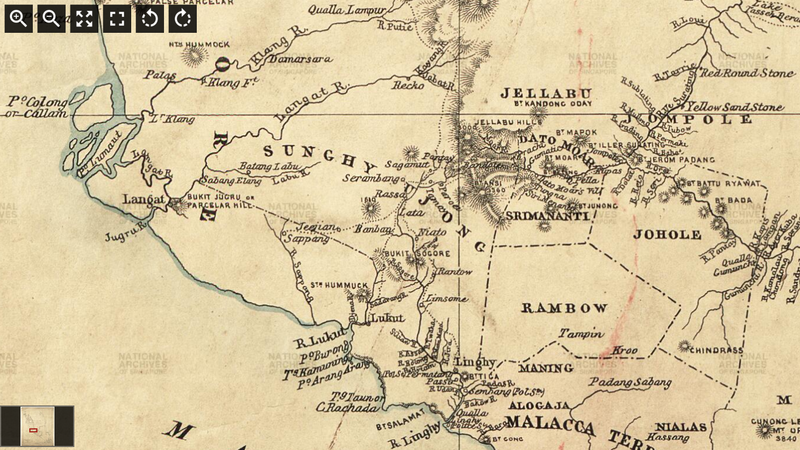
Peta sempadan Selangor-Sungai Ujong, 1876. Ketika itu Rekoh (Recko) masih di bawah pengaruh Sungei Ujong, manakala Lukut di bawah Selangor. Frank Swettenham memudiki Sungai Langat dari Bandar Langat ke Rekoh (ada di dalam peta ini), seterusnya ke Kajang, Cheras, dan Ulu Langat (tiada di dalam peta ini - hanya setakat Sungai Kajang dan Sungai Jebat sahaja): “compiled from sketch surveys made by Captain Innes R E, J W Birch and D Daly, and Admiralty Charts. Lithographed under the direction of Lt. Col. R. Home C.B.R.E” (Royal Geographical Society, London; Royal Geographical Society (Great Britain), 1876: |"Map of Part of The Malay Peninsula, 1876").
Perjalanan dari Bandar Termasa (Langat) ke Rekoh telah dijadikan contoh ayat di dalam kamus istilah karya beliau:-
| How far is it by river from Bandar Termasa [Langat] to Rekoh? | Brapa jauh deri-pada Bandar Termasa mudik ka'Rekoh?” |
| We can reach it with one day's rowing and six day's poling. | Satu hari ber-daiung anam hari ber-galah, bulih sampei. |
(Sumber: Frank Swettenham, 1910: |"Vocabulary of the English and Malay languages with notes", m.s.220).
“Mengikut laporan Swettenham yang membuat lawatan ke tempat itu pada tahun 1875, pada masa itu Rekoh mempunyai penduduk tidak lebih daripada seratus orang yang terdiri daripada orang Melayu, Bugis, Cina dan Korinci. Mereka berada di bawah seorang ketua kampung Bugis (orang Bugis) yang dilantik oleh pembesar Sungai Ujong. Bagaimanapun, ketua kampung itu mungkin tidak disukai oleh penduduk tempat itu. Dia kemudian berpindah ke Singapura. Mengikut laporan Swettenham seterusnya, ” The village 'had the appearance of having been once a very prosperous place. There are plenty of substantial shops and houses built of plank and mud, as good native houses as I have seen anywhere, the Sungai Ujong style but better than houses there…a first Bazaar for houses that ia badly off for water.'“ (Andin Salleh, July 18, 2013: |"Pekan Rekoh yang sudah lenyap"). Dari sumber lain: “In March 1875 Rekoh had a population of no more than a hundred, Malays, Bugis, Chinese and Korinchi, under a Bugis head-man appointed by the ruling chief of Sungei Ujong. The headman evidently found this an unwelcome responsibility and had taken himself off to Singapore. The village 'had the appearance of having once been a very prosperous place. There are plenty of most substantial shops and houses built of plank and mud, as good native houses as I have seen anywhere, the Sungei Ujong style but better than the houses there…a first rate Bazaar for houses that is badly off for wares.'” (J.M. Gullick, 1998: "A History of Selangor 1766-1939", m.s. 74). Terjemahan: “Pada bulan Mac 1875, Rekoh mempunyai penduduk tidak lebih daripada seratus orang, terdiri daripada orang Melayu, Bugis, Cina dan Kerinchi, yang dipimpin oleh seorang ketua berdarah Bugis yang dilantik oleh pemerintah Sungei Ujong. Ketua berkenaan enggan menggalas tanggungjawab yang diberikan, lalu lari ke Singapura. Kampung itu “kelihatan seperti sebuah tempat yang amat makmur suatu masa dulu. Ada banyak kedai dan rumah besar yang dibina daripada papan dan lumpur, sama bagusnya dengan rumah-rumah peribumi yang pernah saya lihat di tempat lain, dengan gaya Sungei Ujong tetapi lebih bagus daripada rumah-rumah di sana… pasar kelas pertama untuk rumah-rumah yang jauh dari sumber.” (terjemahan Ashraf Khalid & Akmal Khuzairy Abd Rahman @ IBDE, 2022: "Sejarah Selangor 1766–1939 - J.M. Gullick", m.s.111).
LATAR PERISTIWA: Jalan Rekoh-Telok Datok
1875-1882: Pentadbiran Raja Kahar
Sekitar tahun 1875, Sultan Selangor, Sultan Abdul Samad telah melantik salah seorang puteranya, Raja Kahar, sebagai pentadbir (Malay Magistrate) daerah Ulu Langat, termasuk Kajang dan Rekoh. Antara faktor keputusan ini ialah kehendak baginda untuk mengembalikan pengaruh keluarganya di daerah tersebut, yang ketika itu di bawah pengaruh Sungei Ujong: “Until 1880 it was the policy of the colonial regime, dictated by the need to practise strict economy, to leave the interior of Selangor in the charge of local notables, and the Sultan wished that his sons would perform public duties in consideration of receiving 'political allowances' from the state treasury. Thus it was that Raja Kahar had charge of the Ulu Langat district as 'Malay Magistrate' for some years. There were particular factors conducive to this arrangement. The Sultan regarded Ulu Langat as his patrimony, inherited from his father, Raja Abdullah, and he was anxious to restore his authority over the part that had fallen under the control of Sungei Ujong. The Sultan's investment in mining through advances to Chinese working in Ulu Langat, which had begun in the 1860s, continued. Employing Kahar to supervise his interests was an example of his general practice of using kindred as proxies. He had sent one of his wives to live in a paddy area opened with his aid. Raja Kahar first appears in the extant records in February 1874, when Sir Andrew Clarke visited Bandar Langat; he and his advisers then first made contact with the Selangor royal family.” (J. M. Gullick @ Journal of the Malaysian Branch of the Royal Asiatic Society Vol. 80, No. 2 (293) (December 2007): |"A Short History of Ulu Langat to 1900", m.s. 7-8).
![Tunku Abdul Kahar [Tahir] Tunku Abdul Kahar [Tahir]](/_media/gambar/wangsa-mahkota-selangor-royal-selangor-ku-alam-1.jpg?w=280&tok=50e26f)
Raja Kahar, Raja yang menjaga Kajang (Wangsa Mahkota Selangor, 19 Jan 2014: |"Y.A.M. Tunku Abdul Kahar [Tahir] ibni Almarhum Sultan Sir ‘Abdu’l Samad Shah").
Tindakan ini telah mengakibatkan ketegangan di antara Selangor dan Sungai Ujong, oleh kerana sebelum ini keduanya bersempadankan Sungai Langat: “Kawasan Sungai Ujong masa dahulu sangat luas, beberapa buah tempat di dalam Negeri Selangor sekarang ini dahulunya dalam kawasan Sungai Ujong. Tempat itu ialah seperti Kajang, Rakoh, Semenyeh, Beranang dan beberapa kampong lain lagi yang kecil-kecil. Sempadan di antara Dato' Kelana Sungai Ujong dengan To' Engku Kelang, Batang Langat (Sungai Langat). Kanan mudek kawasan Sungai Ojong dan kiri mudek kawasan Dato' Engku Kelang. Kawasan sebelah kanan Sungai Langat ini ialah kawasan-kawasan yang termasuk Kajang, Semenyeh, Rakoh dan Beranang. Pada masa Sungai Ujong di perintah oleh Dato' Kelana Sendeng (Dato' Kelana ke-V) Semenyeh telah diberikan kepada Tunku Sutan menantu kepada Raja Husin waris Sungai Ujong. Tunku Sutan dan Raja Husin telah membuka Semenyeh hingga ramai penduduk-penduduknya. Banyak hasil bijih timah dikeluarkan dari sana dan telah diberi izin oleh Dato' Kelana akan Tunku Sutan dan Raja Husin memungut cukai-cukai itu untuk sara hidup mereka. Kemudian Raja Husin membuka Beranang pula pada tahun 1878. Kemudian Tengku Kahar Putera Sultan A. Samad duduk di Kajang hingga Inggeris mencampuri pemerintahan Negeri Selangor.” (Perpustakaan Negeri Sembilan: |"Sungai Ujong").
Sempadan asal Kelang-Sungai Ujong menurut Terombo Sungai Ujong (1901): “FASAL 11. Sempadan Sungai Ujong Dengan Dato'-dato' Yang Empat, Kelang, Sg. Ujong, Jelebu dan Johol. 11.1. Kawasannya yang telah dibuka oleh Batin-Batin dibawah pemerentah masing-masing iaitu Batang Langat, Kuala Labu, Bukit Jukerah, Lalu ke Tunggul Sejaga, Semonyeh terus ke Merbok Awang Hilir Rakoh, Subang Hilang, antara Kajang dan Rakoh terus ke Bukit Perhentian Rimbun perbatasan dengan Pahang. 11.2. Sebelah kiri mudik Sungai Langat di punyai oleh Kelang. Sebelah Kanan mudik Sungai Langat Sungai Ujong punya.” (Susunan Haji Muhammmad Tainu dan Zaini bt. Abd. Hamid, Jawatan Kuasa Penyelidikan Budaya Negeri Sembilan, November 1993, berdasarkan Raja Aman Raja Hussin, 1901: Terombo Sungai Ujong: |"Rengkasan Terombo Sungai Ujong", m.s.9-10).
Terdapat perkhabaran bahawa Raja Kahar turut tidak disenangi sesetengah pihak di perkampungan Ulu Langat, namun Swettenham berpendapat sebaliknya, lalu menyokong beliau: ”(Swettenham to Sec. for Native States, 8 Apr. 1875, enclosed in Clarke to Sec. State, 27 Apr. 1875, CO 809/5): There were also increasing complaints about Raja Kahar. Soon after Swettenham had arrived in Langat, 'Abdul-Samad permitted him to take charge of the Ulu Langat district. In early 1873 complaints were frequently made by people in the village of Ulu Langat about the raja’s behaviour and when Swettenham visited the district later the same month he went armed with a letter from the Sultan instructing his son to obey Swettenham. Contrary to his expectations he was very impressed by Kahar's efforts to restore the town of Kajang and revive its trade and encourage reopening of mines in the area. The source of the complaints was a Menangkabau Imam, Prang Mat Asis, who collected duties in Ulu Langat and resented Raja Kahar's presence. Swettenham claimed that from this episode the word spread that there was wide-spread discontent and migration from Ulu Langat; but in his opinion there was no evidence either at Kajang or Ulu Langat village that Raja Kahar had abused his powers. Instead, at both places Swettenham supported the authority of the Raja and confirmed his right to collect taxes. He permitted the Imam to collect duties at Ulu Langat on the condition that they were sent to Tungku Zia'u'd-din (25 March 1875: Swettenham hoped eventually to have penghulu's established at Reko, Kajang, Cheras and Ulu Langat, each collecting a two dollar duty on every bhara of tin , half going to the Sultan and the remainder to the penghulu). By August, however, Swettenham was informed that Raja Kahar was acting arbitrarily; he had on one occasion taken a daughter from one man who owed him money and on another he had confiscated a quantity of tin. The latter story especially, it was said, had frightened off investors and traders to the district.” (P.L. Burns, November 1965: |"The Constitutional History of Malaya With Special Reference to the Malay States of Perak, Selangor, Negri and Pahang 1874-1914", m.s. 63-64).
Menurut Abdullah Hukum (sambungan penghabisan Perang Klang, sekitar 1875): “Apabila Bugis telah lari maka negeri pun aman. Saya pun duduk di Semenyih berniaga kain ada kira-kira dua tahun lamanya. Adapun Semenyih itu ialah di bawah perintah Raja Husin seorang raja peranakan Sungai Ujong. Hulu Langat, Kajang dan Rekoh masa itu di bawah perintah Raja Kahar Ibn Sultan Abdul Samad. Tengku itu jua majistretnya masa itu dan Tengku itu memberi hukum kepada orang Minangkabau seperti Panglima Muda, Khatib Raja, Ginti Ali dan jurutulis supaya memulangkan harta-harta orang Mendahiling yang dirampas dahulu dipulangkan kepada Raja Yusof dan Fatimah cucu daripada Datuk Penghulu Langat. Saya duduk pula membuka sawah di Langat ada kira-kira dua tahun. Dalam masa saya tinggal di Hulu Langat itu saya mula-mula dapat memandang wajah Yang Maha Mulia Tuanku Sultan Abdul Samad, iaitu pada masa Yang Maha Mulia itu berangkat kerana suatu lawatan melihat persawahan di sana dan Yang Maha Mulia sendiri ada mengaturkan sawah-sawah itu. Kedatangan Yang Maha Mulia itu dari Kuala Lumpur ialah dengan jalan sungai dan bertandu. Yang Maha Mulia itu diiringi oleh ramai dayang-dayang dan hulubalang. Kemudian saya berpindah pula ke Kuala Lumpur menuju rumah Raja Bot dan Raja Syam. Ketika itu saya ingat Raja Bot berkata yang perang telah berhenti kira-kira 30 tahun.” (Adnan Haji Nawang, 1997: "Kuala Lumpur dari Perspektif Haji Abdullah Hukum", m.s.37).
1878-02-10: Menjadi Sebahagian Negeri Selangor
Di dalam suatu perjanjian yang ditandatangani pada 10 Februari 1878, antara lain, Rekoh telah diserahkan kepada Sultan Abdul Samad, lalu dengan rasminya menjadi sebahagian daripada negeri Selangor:-
“Pada hari ini dalam tahun 1878, satu perjanjian mengenai sempadan negeri Selangor dan Sungai Ujung dibuat di antara Sultan Abdul Samad, Yang di-Pertuan Negeri Selangor dengan Dato' Kelana Sungai Ujung, Tengku Saiyid Abdul Rahman. Perjanjian itu antara lain menyatakan bahawa:-
Pertama: Dengan nasihat Kapten Bloomfield Douglas (Residen British di Selangor) Sultan Abdul Samad, bagi pihak dirinya, dan puteranya Raja Musa atau sesiapa juga penggantinya yang akan ditabalkan sebagai Sultan dan waris-warisnya, mulai saat itu mengaku bahawa kawasan Lukut yang pada masa itu diperintah oleh Raja Bot dan semua kawasan tanah dalam Sungai Raya yang sekarang diperintah oleh Raja Daud, yang kesemuanya itu adalah di bawah kekuasaan Sultan Abdul Samad.
Kedua: Dengan nasihat Kapten Murray (Residen British di Sungai Ujung), Tengku Saiyid Abdul Rahman bagi pihak dirinya, pengganti-penggantinya dan waris-warisnya atau sesiapa juga yang memerintah Sungai Ujung dan bergelar Dato' Kelana, mengaku bahawa mulai dari saat itu kawasan yang terletak di Seberang Tebing Sungai Langat bernama Rekoh dan semua tanah bernama Labu adalah diserahkan kepada Sultan Abdul Samad Selangor, pengganti-penggantinya dan waris-warisnya untuk selama-lamanya.
Bagaimanapun, perjanjian itu telah dibantah oleh Raja Bot yang memerintah Lukut kerana beliau tidak diajak berunding mahupun diminta pendapatnya dalam rundingan mengenai perjanjian itu. Raja Bot membantah keras mengenai keputusan memasukkan Lukut dalam perintah Sungai Ujung kerana daerah itu adalah kepunyaan ayahandanya, Raja Jumaat, yang telah diberikan oleh Almarhum Sultan Muhammad pada tahun 1846.”
(Sumber: Hari Ini Dalam Sejarah @ Arkib Negara Malaysia, Ahad 10/02/1878: |"PERJANJIAN SEMPADAN SELANGOR - SUNGAI UJUNG").
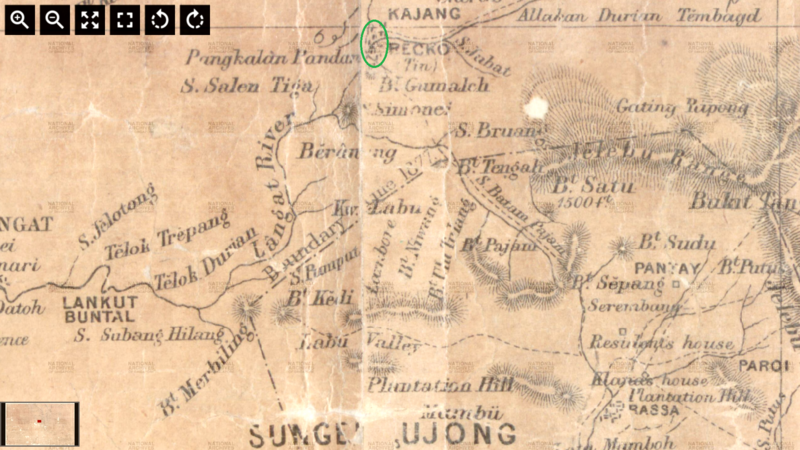
Peta sekitar Rekoh, tahun 1877: ditanda sebagai “Recko (Tin)” (bulatan hijau), kawasan lombong bijih timah terawal di Ulu Langat. Ketika ini persempadanan baru masih di tahap cadangan (ditanda dengan garisan putus-putus, di sebelah utara Sungai Ujong): “This is the bottom portion of the map (See the map of Reference Code SP002097_1 for the top portion), compiled from Admiralty Charts by officers of Her Majesty's Royal Engineer and Artillery Services and Royal Navy, and civil officers in the native states (for) Sir William Cleaver Francis Robinson, Governor of The Straits Settlements.” (|Map of The Malaya Peninisula, 1879 @ National Archives of Singapore).
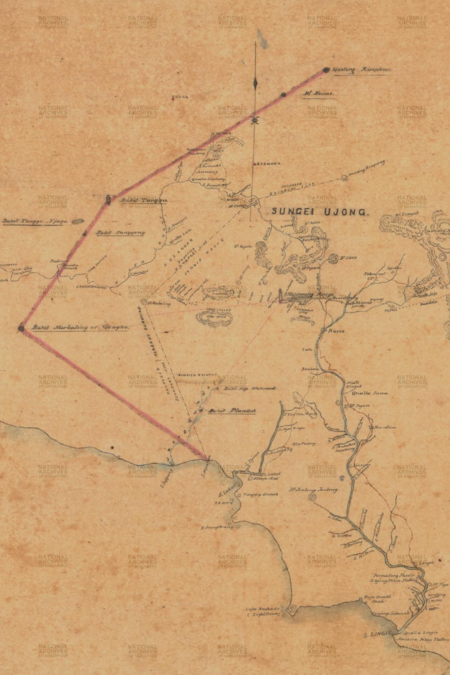
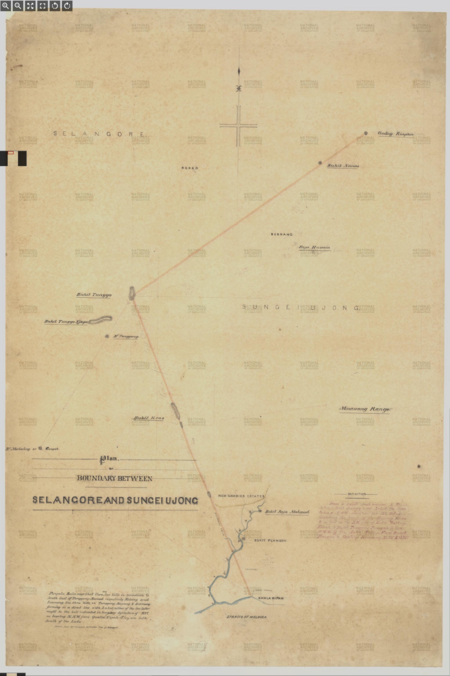
Kiri: Peta Selangor-Sungai Ujong tahun 1877, menunjukkan sempadan semasa (ditanda merah), dan cadangan awal persempadanan baru (ditanda dengan garisan putus-putus): “Map shows track from Seramban (Seremban) to Labu Valley surveyed by B. Douglas, HBM's Resident, Selangor” (
Survey Department, Singapore, 15/10/1877: |"Track From Seramban (Seremban) To Labu Valley").
Kanan: Peta cadangan sempadan Selangor-Sungei Ujong (1877), bersama perincian cadangan. Antaranya, Bukit Tunggul menjadi salah satu mercu tanda serta bucu sempadan tersebut: “Plan Of Boundary Between Selangore And Sungei Ujong, 1877: Plan shows boundary between Selangore (Selangor) and Sungei Ujong at Selangor, Malaya, and a few references, like hills. Extract from Mr Cameron's exploration map of Selangor. … From a small creek named S. Nipha between East Sepang and Lukut the line takes a N.N.W. direction for 12 1/2 Miles, avoiding the heads of the Sepang Rivers to a hill on the S.W. side of Labu Valley. Thence to Bukit Tunggu (Tunggah to the W.N.W. of the ? ? . From Bukit Tunggu to Ginting Rimphung N.73' E.6 ? … Pengalu Bala says that there are two hills in succession to South East of Tanggong - Named respectively Kobang and Siamang in a direct line with Lukut, either of the two latter might be the hill indicated in boundary definition of 1877, as bearing N.N.W. from Qualla Nipah - They are both South of the Labu.” (Survey Department, Singapore, 1877: |"Plan Of Boundary Between Selangore And Sungei Ujong").
Menurut J.M. Gullick (2007): “Another unsettling factor was the uncertainty over the status of land along the right bank of the Langat River, upstream from its junction with the Labu River as far as Rekoh, claimed by Sungei Ujong. To colonial administrators, the solution seemed to lie in an exchange by which Selangor would regain land upstream from Labu village and cede a strip of land along the coast, including Lukut, so that the boundary ran inland from Sepang more or less at right angles to the coast. It would not give back to the Sultan all he claimed but he was quite blithe about giving up Lukut, no longer an important mining centre. After intermittent negotiations, lasting two years (1876-8) a deal on these lines was embodied in an agreement. Raja Bot, however, had inherited Lukut from his father, Raja Jumaat, to whom - so he claimed - Sultan Mohamed had ceded it in perpetuity. This dispute raised nice questions of whether a ruler could alienate state land for ever, but in the end Bot had to accept compensation for his lost patrimony. Douglas was not a man to miss an opportunity of military ceremony. When the 1878 treaty had been signed, he came to Rekoh, where there was 'an old fort' and 'a few huts … the place is evidently not very flourishing'. The local people had been summoned from Ulu Langat, Kajang, and Semenyih to hear a proclamation read and some 200 attended. Among the notables present were Haji Tahir, Dato' Dagang of Kuala Lumpur, who 'assisted me very materially by entertaining the people', Sheikh Mohamed Ali, and Inche Ambo, the leader of the Pahang forces then in occupation of Ulu Selangor. Douglas and Murray, his opposite number from Sungei Ujong, each supported by a police contingent, led the ceremony, at which 'a gun was fired, the Selangor flag hoisted, the men presented arms, the treaty was read, and three cheers given' for everyone from the Governor downwards. A buffalo had been killed and 'a feast in native fashion commenced, everyone having his fill'. More potent perhaps was the change in taxation, since Douglas believed that his tariff was less onerous than that of Sungei Ujong. 'The change gives the miners great satisfaction and encouragement. '” (J. M. Gullick @ Journal of the Malaysian Branch of the Royal Asiatic Society Vol. 80, No. 2 (293) (December 2007): |"A Short History of Ulu Langat to 1900", m.s. 9-10).
LATAR PERISTIWA: Sempadan Selangor-Negeri Sembilan.
LATAR PERISTIWA: Hutan Simpan Bukit Tunggul.
LATAR PERISTIWA: Haji Muhammad Tahir bin Hj Mahmud (1800-an).
Peta Klang-Langat 1879
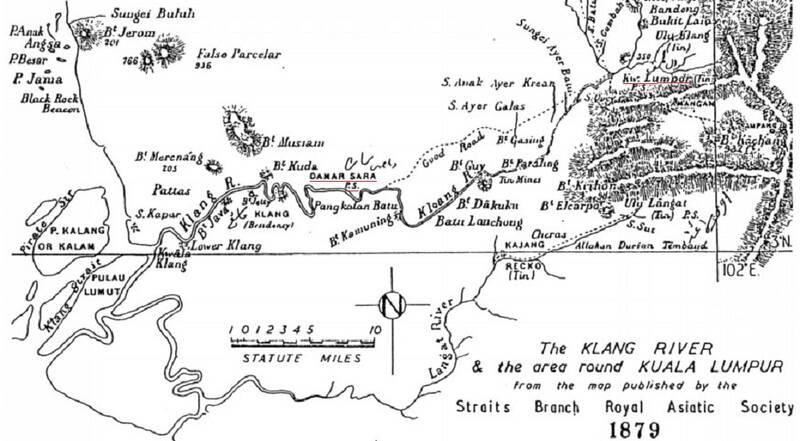
Peta sekitar Sungai Klang, termasuk Sungai Langat, tahun 1879. “Recko (Tin)” turut ditandakan (Yusrin Faidz Yusoff, 18 August 2018: |"What is the meaning of the place named "Damansara"?").
1879-05-29: Lawatan Sultan Selangor
Pada 29 Mei 1879, Sultan Selangor dengan diiringi dua putera baginda serta H.C. Syers, pegawai superintenden polis British, melawat beberapa kawasan di pedalaman daerah Ulu Langat, termasuk Kajang dan Rekoh. Antara lain H.C. Syers melaporkan: sepanjang Sungai Langat dari Ulu Langat ke Rekoh, yang asalnya hutan belantara, telah pun diterokai dan ditanam padi dengan pesatnya, kebanyakannya oleh para peneroka dari Sumatera. Lombong bijih timah kelolaan para pemodal Cina pula sedang menghadapi masalah kewangan yang serius:-
“While staying at Ulu Langat I occupied my time by trying to find out the area of land under cultivation but it would be quite impossible to do so without surveying the whole country. There is no doubts a much larger extent of land now under cultivation than there was in 1876-7. Both banks of the Langat river between Ulu Langat and Reckoo is now cultivated though in a very rude manner. This land two years ago was all jungles. The present occupants are nearly all arrived from Sumatra. They lease a piece of land, plant it with paddy, and after reaping their crop, desert the place, seldom attempting to obtain crops from the same land two years in succession.
Probably if some restrictions were made about the clearing of fresh land these people would not desert their clearings after one year's planting but it is a matter or consideration whether the land they occupy would be worth troubling about.
After the Sultan had completed his stay at Ulu Langat we went out by boat to Kadjang and Reckoo. Nothing of importance occuring at either place except the burning of a Chinese mining congsee at the former. The origin of the fire was unknown.
The Sultan several times expressed satisfaction at the manner in which the Goverment of his country was being carried out and pointed out to his son the benefits they had derived from the Residential system. Rajah Kahar appeared to thoroughly appreciate what was said by his father, but the heir apparent Rajah Moosah evidently hates all Europeans and does not attempt to disguise his hatred, his manner at times being very offensive.
Having spent a week at Kajang and Reckoo we procured boats and returned to Langat.
During my stay in the interior I had several opportunities of visiting the Chinese mining communities and enquiring from them, their views of the present state of the tin trade. They all say that while tin remains at its present price they will be able to work it at considerable profit, but the whole of the mining Tow Kays are as hopelessly bankrupt that there is not the slightest chance of increased production, unless new capital is introduced into the country.”
(Sumber: PEJABAT SETIAUSAHA KERAJAAN NEGERI SELANGOR, 29/05/1879: |"H.H. THE SULTAN'S VISIT TO THE INTERIOR").
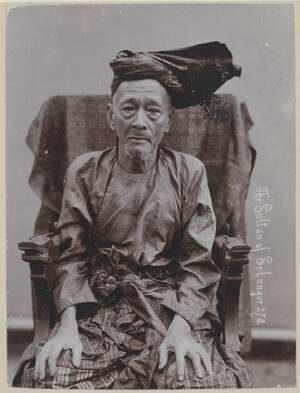
![Tunku Abdul Kahar [Tahir] Tunku Abdul Kahar [Tahir]](/_media/gambar/wangsa-mahkota-selangor-royal-selangor-ku-alam-1.jpg?w=280&tok=50e26f)
CATATAN: Sultan Selangor ketika ini ialah Sultan Abdul Samad Ibni Almarhum Raja Abdullah (memerintah 1857-1898, Gambar kiri: Wikipedia)). Dua putera beliau yang mengiringi beliau ialah Raja Kahar (Raja yang menjaga Kajang, Gambar kanan: Wangsa Mahkota Selangor, 19 Jan 2014: |"Y.A.M. Tunku Abdul Kahar [Tahir] ibni Almarhum Sultan Sir ‘Abdu’l Samad Shah") dan Raja Muda Musa (dilantik Yang Dipertua Majlis Mesyuarat Negeri, menggantikan Tengku Kudin, pada 1880, kemudiannya mangkat pada tahun 1884.) (SEKRETARIAT AKHBAR KERAJAAN NEGERI SELANGOR, 2019: |"SEJARAH NEGERI SELANGOR").
LATAR PERISTIWA: Penanaman Padi di Ulu Langat 1878-1889
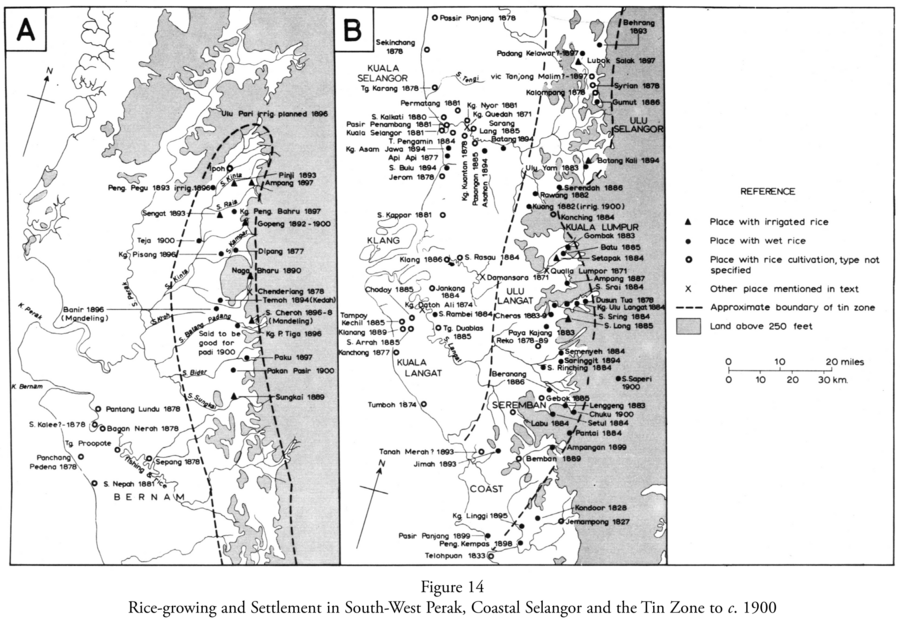
Penanaman padi yang agak meluas ada direkodkan di Rekoh sekitar 1878-1889, namun jenisnya tidak dinyatakan: “In the inland parts of the state several agricultural regions can be recognized. In Ulu Selangor wet rice cultivation was of small significance, consisting of a few discrete centres in a number of small valleys flanking the Ranges. To the south, around Kuala Lumpur, the Setapak, Ampang and Gombak valleys were well-cultivated, but it was in the south-eastern corner of the state, on the line Cheras-Kajang-Reko, and more importantly in the Beranang basin that cultivation was at all extensive. Only in Beranang was cultivation long-lived, that being the location of five-sixths of the tiny total of 8,000 acres existing by 1905 (Selangor AR 1905, 47). Between these nodes of permanent cultivation, shifting cultivation was the rule and this form of culture, in which hill rice was one crop amongst others, occupied a considerable proportion of the total cultivated area. This, by 1884, totalled only some 14,000 acres for the whole state, of which half was in the inland districts: Ulu Selangor, 837 acres, Kuala
Lumpur, 4,492 acres and Ulu Langat, 1,500 acres (Selangor Lands Dept. AR 1883; 1884; Selangor AR 1884, 1004).” (R.D. Hill, 2012: |"Rice in Malaya: A Study in Historical Geography", m.s.168-169).
Pada awal 1880-an, Paya Kajang. serta sepanjang jalan ke utara (Cheras) dan selatannya (Rekoh) merupakan kawasan penanaman padi yang awal. Ianya diapit oleh ladang-ladang orang Kampar dan Mandailing, yang kemudiannya meninggalkannya akibat pengenalan cukai tanah oleh pihak British. Pada tahun 1886, penanaman padi dibuka di Beranang, dan ia berkembang menjadi “jelapang padi Selangor” menjelang tahun 1905. Pengusaha utama penanaman padi di sekitar Cheras-Kajang-Rekoh-Beranang ini adalah dari kalangan orang Minangkabau tempatan (dari Sungai Ujong, Jelebu dan Rembau) juga perantau (dari Sumatera sekitar 1870-an), yang mahir dalam bercucuk tanam. Mereka membina sistem perairan di Kajang, Cheras, Kampong Bukit dan Sungei Sring. Selain padi mereka turut mengusahakan tanaman lain (kelapa, kopi, tembakau, gambir), dan melombong bijih timah. Selain sumber makanan sendiri, hasil padi dijual kepada pelombong Cina di sekitarnya. Kegiatan ini disokong oleh pihak British melalui geran-geran pembukaan tanah (termasuk kepada pengusaha Tamil), sehingga tiada lagi tanah kosong pada tahun 1886. Ketika lonjakan tanaman kopi sekitar 1894, penanaman padi hanya tertumpu di Paya Kajang, sebelum kembali pada tahun 1905 setelah kejatuhan industri kopi tempatan: “In the south-east corner of the state, rice was cultivated more extensively and more permanently than anywhere else in Selangor. By 1905 the total area of rice was about 8,000 acres, of which five-sixths was in the Beranang and adjoining valleys. Earlier, however, cultivation was focused at Paya Kajang with a linear extension along the road to Cheras, and another southwards to Reko. Flanking these cultivated swamp lands were extensive areas of ladangs, occupied by Kampar and Mandeling men, but these quickly moved off when, in 1882, they came to be required to pay an increased quit-rent (Selangor AR 1883, 260; SSS 220/83; 537/83; Ulu Langat MR 12/1883). Later, from around 1886, the Beranang valley was opened. The reason why rice-growing in this area was fairly stable seems related to the class of people there. Whereas the Sumatrans in these parts were in Syers’s words, “merely ladang men” permanent settlers were Minangkabau folk mainly from Sungei Ujong, Jelebu and Rembau, as well as some direct migrants from Sumatra, the earliest of whom had moved in during the mid-1870s (SSS 273/77; 537/83; Ulu Langat MR 5, 6, 7, 9, 10/1883). These people were skilled agriculturalists and although they initially complained of lack of irrigation water, their leaders quickly set about providing it as at Kajang, Cheras, Kampong Bukit and Sungei Sring (Ulu Langat MR 6, 7/1883; 1, 4/1884; 2, 4/1886). Development was well-balanced. On the hills, after an initial catch-crop of dry rice, coconuts, coffee, tobacco and gambier were planted to provide a cash income beyond what rice might bring whilst a certain amount of tin-mining was undertaken on the side. Rice was looked upon not merely as a means of subsistence, but was grown with an eye to the market amongst Chinese miners in the neighbourhood (Ulu Langat MR 5/1883). Such was the boom in land development along the Cheras-Kajang-Reko axis during the three years from 1883, a boom aided by government grants, that by 1886 no further suitable land was available (Ulu Langat MR 2/1886). As in Lower Perak (p. 116) a start was made with Tamil settlement, at least to the extent of granting loans for the purpose (SSS 2240/86; 2259/86). The Cheras-Kajang-Reko area was not further reported upon after 1894, by which time the area under rice had contracted to Paya Kajang alone where a mere 150 acres was still cultivated (Anon., 1894, 344). At the same period the total rice area of the state had shrunk to about 1,500 acres and this shrinkage was ascribed to the high profits obtainable from Liberian coffee “… as compared with the laborious operations, followed by smaller profits, involved in the cultivation of rice…” (Selangor AR 1893, 23). After this short-lived boom, however, rice again increased in importance, reaching about 6,500 acres by 1905 (Selangor AR 1905, 47).” (R.D. Hill, 2012: |"Rice in Malaya: A Study in Historical Geography", m.s.173-174).
LATAR PERISTIWA: Suasana Perlombongan 1880-an
Setelah melalui tempoh kemerosotan pada akhir 1870-an, kegiatan perlombongan pulih semula menjelang akhir 1879: “The late 1870s saw a sustained and catastrophic fall in the price of tin which, together with the high price of imported rice, made tin mining unprofitable and created hardship for everyone. … Late in 1879 the rapid rise in the world price of tin created a boom throughout Selangor, though the tin ore deposits of the district did not match those of the Klang and Selangor river valleys in extent. They were confined to the valley bottom where, beneath 5-12 feet of unproductive overburden, lay deposits 10-50 feet wide and 6 inches to 2 feet in depth.54 By the mid 1880s 1,500 miners, almost all Chinese, were at work.” (J. M. Gullick @ Journal of the Malaysian Branch of the Royal Asiatic Society Vol. 80, No. 2 (293) (December 2007): |"A Short History of Ulu Langat to 1900", m.s. 9-10).
Contoh pelekat (notis) penguatkuasaan perlindungan kegiatan arak, candu dan judi di dalam kawasan perlombongan: “Menyatakan kepada sekalian orang2 surat pajak di dalam Rekoh dan Kajang dan Hulu Langat, orang yang pajak ada dapat kuasa daripada gaberment (government) Selangor di dalam kampung2nya sahaja iaitu di dalam Kampung Rekoh dan Kajang dan Hulu Langat, bukan di dalam lombong atau di dalam kongsi orang(?). Jikalau ada orang hendak tahankan orang masuk arak atau candu atau main judi atau kedai barang2 di dalam lombong boleh ia pergi mengadu kepada mata2 stesyen, apa kala itu boleh ia pergi tangkap bawak kepada kita ? kita menyatakan adanya. Tamat - Tertulis kepada 11 hari Firuari (Februari) 1879” (PEJABAT SETIAUSAHA KERAJAAN NEGERI SELANGOR, 01/08/1879: |"RELATIVE TO THE LOSS OF $100 ON THE PART OF THE LANGAT FARMER").
LATAR PERISTIWA: Candu di Tanah Melayu.
Ketika itu, setiap kawasan perlombongan diuruskan sepenuhnya oleh pengusaha sesebuah lombong secara autonomi, tanpa campur tangan pihak pentadbiran atau penguasa lain: “The situation of the mining areas, and the close organisation of the Chinese population meant that they lived in autonomous communities under their own leadership. The nucleus of the community was the mining kongsi. It might consist of half a dozen men sharing a hut near a small mine in a lonely jungle clearing, or it might be one of many large mines grouped round a thriving township, with a market, gambling-booth, shops, theatres and secret society lodges. The remoter miners lived outside all authority, regulating their own affairs; but in the large centres the miners were drawn together into a single community by a mesh of associations, of which the most important were the kin and territorial associations, the former based on membership of a surname group tracing descent from a common ancestor, and the latter based on common dialect or common place of origin in China. In modern Malaya both types of association perform ritual and welfare functions, building temples, maintaining cemeteries and providing burial insurance, acting as loan societies, providing social assistance and employment services, and providing and maintaining schools. It is likely that in the mining communities of the 1860s and 1870s they had much the same functions, except for the last; there were few children and these were probably privately taught.” (E. Sadka, December 1960: |"THE RESIDENTIAL SYSTEM IN THE PROTECTED MALAY STATES, 1874-1895", m.s.40).
Selain gejala sosial seperti kegiatan arak, candu, dan judi, kegiatan perlombongan besar-besaran di era Residen British turut mencemar kawasan pertanian yang berdekatan, khususnya perairan sawah padi: “tin mining activity, if it was sited in the same area as peasant agriculture,constituted an important disruptive influence on the latter, especially if the agriculture consisted of padi cultivation. The mining activity polluted streams and rivers watering the fields or diverted away water required to irrigate the fields . In its early years, however, mining development had generally taken place in areas located far from the traditional areas of peasant agriculture and damage to the cultivation had been minimised. After the establishment of residential rule, however, there was an increased scale of mining activity and considerable areas of peasant cultivation in the west coast states, both in the traditional as well as the new areas, were rapidly encroached upon. The administration, faced with the dilemma whether it should protect the interests of padi cultivation at the expense of its most important economic activity, was predictably slow to react.” (Lim Teck Ghee, November 1971: |"PEASANT AGRICULTURE IN COLONIAL MALAYA: Its Development in Perak, Selangor, Negri Sembilan and Pahang, 1874-1941", m.s.60).
1879-08-30: Balai Polis Rekoh
Lawatan kerja Pegawai Superintenden Polis Selangor, H.C. Syers, ke balai-balai polis di seluruh Selangor, termasuk balai polis Rekoh. Keadaannya ketika itu amat baik, malah lebih baik berbanding balai polis Kajang: “Visiting the Ulu Langat district, I inspected police station at Reckoo. Here there are six men and a Lance Corporal under Sergeant Mat Singapore. The station is a model of cleanliness and the Arms and Accoutrements are in perfect order. The station is large and affords good accomodation for Officers visiting. The only deficiency is a bath room and cook house. I gave orders for these to be made at once. The work to be performed by the police. At Kadjang a distance of three miles from Reckoo there is a station at which Corporal Rassol and four men are stationed. I found the Corporal had kept his men and their accoutrements in good order. The station is in a very tumble down state and will not stand more than three or four months longer.” (PEJABAT SETIAUSAHA KERAJAAN NEGERI SELANGOR, 30/08/1879: |"SUPT. OF POLICE'S REPORT ON THE POLICE IN THE INTERIOR").
CATATAN: Perihal Balai Polis Rekoh:-
- Lawatan J.P. Rodger dan H.C. Syers pada 17/03/1883: ianya terletak di tengah-tengah kampung di atas Bukit Reko, dan asalnya sebuah rumah kepunyaan seorang raja Melayu: “Recko is a pretty little village on a hill, the Police Station (a house bought, I believe, from some Malay Rajah) occupying a splendid position in the centre.” (PEJABAT SETIAUSAHA KERAJAAN NEGERI SELANGOR, 17/03/1883: |"ENCLOSING REPORT OF JOURNEY TO KAJANG").
- Lawatan George Bellamy pada 20/10/1884: melaporkan keadaan jalan di kaki bukit menuju ke balai polis: “Inspecting the road to Reko, which is also in good order with the exception of about 50 feet over the swamp at the foot of Reko Police Station Hill which requires consolidating. The road up to the station is possibly about 1 mi 10?. for a short distance which avoids along detour or a zigzag which would materially increase the length of the road.” (PEJABAT SETIAUSAHA KERAJAAN NEGERI SELANGOR, 20/10/1884: |"HIS REPORT ON THE ROADS FROM ULU LANGAT TO RECKO AND FROM SAMONIEH TO BERANANG").
- Ditutup sepenuhnya pada 26/03/1897, dan bakal disewakan kepada M. Sidney Perry, pengurus Belmont Estate ketika itu (PEJABAT SETIAUSAHA KERAJAAN NEGERI SELANGOR, 26/03/1897 @ Arkib Negara Malaysia: |"LEASE OF THE REKO POLICE STATION BUILDING TO MR. M.S. PARRY OF BELMONT ESTATE").
1880-an: Suasana Rekoh dan Kajang
“Dalam catatan pada November 1882 terdapat 30 kedai Melayu, 3 kedai Cina & di Rekoh ada 20 kedai Melayu, 4 kedai Cina. Kebanyakan kedai Melayu menjual beras, garam, bekalan makanan dan keperluan terutamanya untuk pekerja pelombong, ada juga kedai yang membeli bijih timah daripada pelombong kecil - kecilan dan mereka juga menjual barangan rotan yang dibekal daripada Orang Asli tempatan. (AR Selangor 1884).” (Faizal Zainal @ Selangor 10: |"Pasar Kajang - 1910").
1882-05-08: Peta Tinjauan Daly
Pada tahun 1875, Sir Andrew Clarke, Gabenor Negeri-Negeri Selat, telah melantik Mr. Dominick Daniel (D.D.) Daly sebagai “Surveyor for the Native States”. Tugasan utama beliau ialah menjalankan tinjauan topografi di seluruh negeri Selangor. Pada Isnin, 8 Mei 1882, Mr. Daly, ketika itu pegawai superintenden Public Works and Survey, Selangor, telah menyampaikan laporan hasil tinjauan beliau di dalam mesyuarat Royal Geographical Society, yang turut dihadiri Sir Andrew Clarke. Antara lain beliau memetakan beberapa lokasi kawasan perlombongan bijih timah di sekitar Selangor (termasuk Rekoh dan Kajang), yang sebelum ini tidak diketahui oleh pihak British: “Klang was then the capital, but in 1880 the British Resident and his staff moved up river to Kuala Lumpur, which has a central position and is now a most important mining capital. From it Mr. Daly's surveys have radiated, fixing the positions of the principal tin mines and settlements - namely Kanching, Ulu Selangor, Ulu Bernam, Ulu Gomba(k), Ulu Klang, Ulu Langat, Sungie Puteh, Recko, and Kajang, with the jungle paths to them. The position of these places was quite unknown up to this date; and Mr. Daly described Ampagnan (Ampang), the chief of the tin mines, as a type of the whole intimating that the depth of the alluvial deposit over the thin layer of ore varies in different mines from 8 feet to 30 feet from the surface.” (SINGAPORE DAILY TIMES, 19 June 1882, Page 3: |"THE SURVEY OF THE MALAY STATES").


Kajang dan Rekoh (Recko) dalam peta Selangor, tahun 1882. Persempadanan Selangor-Sungei Ujong-Negri Sembilan telah pun jelas ketika ini.
Kiri: “Map of The Malay Peninsula to accompany the paper of Mr D.D. Daly” (|Map of The Malay Peninsula to accompany the paper of Mr D.D. Daly, 1882 @ National Archives of Singapore).
Kanan: Peta yang sama, versi lain: “Administrative boundaries are shown. Relief shown by hachures and spot heights. From: Proceedings of the Royal Geographical Society and monthly record of geography. Vol. 4 (1882), no. 7, pp. 393-412; held in Firestone Library. Call number: G7 .J6873” (Edward Stanford @ Princeton University Library, 1882: |"Map of the Malay Peninsula to accompany the paper of Mr. D. D. Daly, Superintendent of Public Works and Surveys, Sĕlângor, showing his surveys and explorations in the native states"); “Detailed map of the Malay Peninsula based on surveys by D.D. Daly, Superintendent of Public Works and Surveys, Selangor. Published in the Journal of the Royal Geographical Society to accompany a paper by Mr. Daly. Original colour. [SEAS5072]” (Royal Geographical Society, 1882: |"Map of the Malay Peninsula").
“The state of Selangor as depicted on D.D. Daly's 1882 Map of the Malay Peninsula (90). Tin is identified as a resource at five upriver locations in the state. “Damar Sara” (Damansara) is marked in the vicinity of what is today Section 23, Shah Alam. The “Good Road” marked between Damar Sara and Kuala Lumpur was in fact far from adequate for vehicular traffic, which was why it was decided in 1883 to build a railway from Kuala Lumpur to Klang which was completed in 1886.” (Frederic Durant, Richard Curtis, 2013: Maps of Malaya and Borneo : Discovery, Statehood and Progress: the Collections of H.R.H. Sultan Sharafuddin Idris Shah and Dato' Richard Curtis).
Latar Tinjauan D.D. Daly
Tujuan utama tinjauan D.D. Daly adalah pemetaan kawasan bijih timah bagi pihak kolonial British di Perak, Selangor dan Sungei Ujong:-
“In 1867, the Straits Settlements were placed under the authority of the Colonial Office, and six years later, Britain embarked on an interventionist policy in the peninsula. Sir Andrew Clarke succeeded Sir Harry Ord as governor of the Straits Settlements in 1873, and was tasked with extending British influence in the region. His efforts focused primarily on the states of Perak, Selangor and Sungei Ujong.
A map produced in 1874 (93) attests to Clarke's expedition to Selangor, where he met the ruler of Selangor, Sultan Abdul Samad, and used the issue of the threat of piracy along the Strait of Malacca to convince him to accept a permanent British Resident. The map shows how limited knowledge of the interior was at the time. Only the mouths of major rivers and a few mountains are shown. Beyond the issue of security from piracy, Clarke's major motivation was to take control of Selangor's important tin mines, including those located in what is today the Federal Territory of Kuala Lumpur, and were at the time under the authority of the Sultan.
…..
As their involvement in the affairs of the peninsula became greater and their position there became more secure, the British began to undertake surveys of the interior. William Barrington D'Almeida (see 87) and Dominick Daniel Daly, in particular, worked on maps of the west coast states of the peninsula in the 1870s.
These new surveys revealed the topography of the interior and gradually filled in the blank spaces that occupied large parts of earlier maps. In doing so, they made apparent the difficulty of representing landforms. Cartographers around the world faced this problem, including in Europe, where they tried to determine the best way to represent altitude: with shadows, shading or contour lines. The magnitude of this task was especially great in areas such as the Malay Peninsula and Borneo where the land was generally very poorly known. In the absence of aerial photographs, and with few men to take topographical surveys in the jungle, it proved to be a gigantic task.
In 1882, under the auspices of the Royal Geographical society, Daly published a map of the entire Malay Peninsula (90). While this showed great strides had been made in terms of knowledge of the west of the peninsula, large areas still remained unexplored. The map also shows the cartographer's desire to depict state borders. The delineation of the protectorates, coloured in pastel shades, was almost complete, while dotted lines were used to show the borders of most of the other states, particularly the northern ones of Kedah, Kelantan and Terengganu, which were still - symbolically at least - under Siamese authority.”
(Sumber: Frederic Durant, Richard Curtis, 2013: Maps of Malaya and Borneo : Discovery, Statehood and Progress: the Collections of H.R.H. Sultan Sharafuddin Idris Shah and Dato' Richard Curtis, m.s. 60-61).
“The purposes of Daly's surveying in Selangor in mid-1870 are fixing the position and jungle tracks thereto of the principal tin mines. His surveys radiated from Kwala (Kuala) Lumpur in many directions: namely, Kanching, Ulu Selangor, Ulu Bernam, Ulu Gombah, Ulu Klang, Ulu Langat, Sungie Puteh, Recko, Kajang, and intermediate places (Daly, 1882: 394). Without sufficient draughtsman and instruments, Daly was forced to make a sketch survey, according to Swettenham's personal observation of his work (Swettenham, 1875: 250). Therefore, even though he was an experienced surveyor who used to participate in one notable traverse survey in the Northern Territory of Australia, from Adelaide to Darwin, rigorous information could not still be expected from Daly‘s surveying.” (Er-Jian Yeh @ Durham University, 2011: |"Territorialising Colonial Environments: A Comparison of Colonial Sciences on Land Demarcation in Japanese Taiwan and British Malaya", m.s. 149).
Menurut Isabella Bird dalam memoirnya tahun 1883, lebih separuh Semenanjung Tanah Melayu ketika itu masih belum diterokai dan tidak diketahui oleh pihak British: “The map, the result of recent surveys by Mr. Daly, and published in 1882 by the Royal Geographical Society, shows that there is a vast extent, more than half of the Malay Peninsula, unexplored. Its most laborious explorer confesses that “of the internal government, geography, mineral products, and geology of these regions, we do not know anything,” and, he adds, that “even in this nineteenth century, a country rich in its resources, and important through its contiguity to our British possessions, is still a closed volume.” “If we let the needle in, the thread is sure to follow” (meaning that if they let an Englishman pass through their territories, British annexation would be the natural sequence), was the reason given to Mr. Daly for turning him back from the States of the Negri Sembilan.” (Isabella Lucy Bird, 1883: |"The Golden Chersonese And The Way Thither").
1883: Pentadbiran Para Penghulu
Pada tahun 1883, daerah Ulu Langat ditubuhkan secara rasmi, dan terdiri daripada 5 buah mukim, setiap satunya ditadbir oleh seorang penghulu. Antaranya ialah Ulu Semenyih (Raja Mahmud, putera Sultan Muhammad), Ulu Langat (Raja Daud), dan Cheras (Syed Yahya, anak kepada Syed Idris yang tinggal di Rekoh): “In 1883 the semi-traditional regime of Raja Kahar as Malay Magistrate was replaced by the formal creation of the Ulu Langat administrative district, though shortage of staff made it necessary that Syers, the superintendent of police, should act temporarily as the first district officer. The district was divided into five mukim (subdistrict), each in the charge of a Malay penghulu (headman), three of whom deserve mention. Raja Mahmud of Ulu Semenyih was the youngest son of Sultan Mohamed, who in his last years appointed Mahmud, a boy of about 10, to the post of Raja Muda. But in the power struggle that followed his father's death in 1857, Mahmud lost the succession (and the office of Raja Muda) and retired to the periphery of his lost kingdom. In the absence of an established local Malay dominant family, Mahmud, who was intelligent and capable, became the recognized leader of the Ulu Langat Malay community. Raja Daud of Ulu Langat mukim had, as a young man, been the paramour of the wife of Sultan Abdullah of Perak (r. 1874-6). He was 'a man of pleasing features, extremely quiet, and of courtly manners [which] … concealed a firm determination and a dauntless courage'. In his later years at Ulu Langat, Daud was 'a charming old man to meet' and no one would have suspected his scandalous past. Syed Yahya, penghulu of Cheras, was the son of an Achehnese immigrant, Syed Idris, who had settled at Rekoh. After his death, he became a saint whose tomb was a local keramat (shrine). Yahya had married the daughter of his predecessor, Che Ngah, and, like his father, he was 'a great advocate of pepper planting' with 3 acres under 7,000 pepper vines. But his efforts to persuade his people to follow his example were ineffective as 'the want of money is the stumbling block'. It was one sign, among many, of the gap between the general body of Sumatran settlers and the upper-class penghulu.” (J.M. Gullick, 2007: |"A Short History of Ulu Langat to 1900"), m.s. 11-12).
Populasi penduduk Rekoh ketika itu 100 orang, dan berbilang bangsa dan budaya. Majoriti penduduk ialah orang Minangkabau, selebihnya termasuk Bugis dan Kerinchi, namun ketuanya Bugis (mungkin Raja Kahar atau wakilnya?). Gabenor Weld pernah melawat Rekoh pada tahun 1883, dan disambut dengan persembahan tarian dan budaya orang asli (Temuan), Melayu, Minangkabau, dan Cina, diiringi nyanyian dan ahli muzik (lelaki Melayu dan Cina): “An 1895 report stated that the Malay population 'almost entirely consists' of Mandailing and Menangkabau. The Menangkabau predominated in the south- eastern portion of the district around Semenyih. This of course had been Sungei Ujong territory until 1878, and Swettenham had seen houses 'in Sungei Ujong style' as far west as Rekoh. But he also noted that the Rekoh headman was Bugis, and the town population of about 100 included Bugis and Korinchi. It was a very mixed population conscious of its cultural differences. When Governor Weld visited Kajang in July 1883, 'we witnessed a series of dances and performances and listened to the chants of wild Sakeis, the Malays, the Menangkabau men and the Chinese - we had scarf dances and shawl dances and saucer dances and a monkey dance and besides singing, Malay and Chinese instrumental accompaniments, all the performers being men.'” (J. M. Gullick @ Journal of the Malaysian Branch of the Royal Asiatic Society Vol. 80, No. 2 (293) (December 2007): |"A Short History of Ulu Langat to 1900", m.s.12).
LATAR PERISTIWA: Penghulu di Zaman Kolonial
LATAR PERISTIWA: Penghulu Syed Yahya
1883-03-18: Lawatan J.P. Rodger dan H.C. Syers
J.P. Rodger, Chief Magistrate and Commissioner of Lands, Selangor, bersama H.C. Syers, Superintendent of Police, Selangor, telah membuat lawatan rasmi ke Kajang dan Rekoh. Menurut catatan mereka, Rekoh merupakan sebuah perkampungan di atas bukit (sekitar Kampung Sungai Tangkas kini). Balai Polis Rekoh (asalnya rumah seorang raja) terletak di tengah-tengahnya, dan dalam keadaan yang baik. Kampung ini pernah didiami lebih 100 buah keluarga, sebelum sebahagian besar (kebanyakannya orang Mandailing dan Kampar) berpindah setelah dikenakan cukai tanah. Jalan Kajang-Reko ketika itu didapati terabai, dan beberapa jambatan telah pun rosak. Berikut adalah catatan penuh mereka berkenaan Rekoh:-
- J.P. Rodger: “18th/ I had intended going to see Mr.Duncan today, but hearing that he was working at a distance of nearly eight miles from Cherass I decided to go to Recko instead. We went by Jibat, an apparently flourishing mining camp, about five miles from Kajang town from Recko, over a fairly good road. Recko is a pretty little village on a hill, the Police Station (a house bought, I believe, from some Malay Rajah) occupying a splendid position in the centre. I was sorry to find that many people had deserted their clearings between Kajang & Recko. The Sergeant at Recko told me that more than one hundred families had gone, in consequence (he said) of the ? Land Tax. I spoke to all the principal people at Recko, telling them that any one could occupy land free from rent for one year, & that we would give them a reasonable time in which to pay afterwards. This seemed to produce a good effect, & they all promised to try & bring the people back again. As far as I can learn few, if any, of them have yet left Selangor altogether. We returned to Kajang by the direct road only about 3 and a half miles in length, but the road was in such bad condition, the bridges being all broken, that we took nearly two hours to reach Kajang. Slept at Cherass. Sayd Jahya offers to contract for two thirds of road from Cherass to Pudu if you will give him specifications. We left Cherass at 6.30 A.M arriving at K.L. at 9.30. - J.P. Rodger” (PEJABAT SETIAUSAHA KERAJAAN NEGERI SELANGOR, 17/03/1883: |"ENCLOSING REPORT OF JOURNEY TO KAJANG").
CATATAN: Punca ramai penduduk meninggalkan Rekoh adalah kerana tidak bersetuju dengan sistem cukai tanah yang baru diperkenalkan, atau tidak mampu membayarnya: “In 1882 new land regulations gave the occupiers of agricultural, mining, and town lands a leasehold title, with the obligation to pay annual 'quit rent', in effect, land tax. The Malay smallholders no longer had to give unpaid customary labour ( kerah ) but they objected to the new tax, arguing that they did not have the opportunity of earning cash with which to pay it. The state government was obliged to remit the new impost for three years (1884 - 6).” (J.M. Gullick, 2007: |"A Short History of Ulu Langat to 1900"), m.s. 12).
CATATAN: Syed Jahya / Yahya ialah (bakal?) Penghulu Cheras, dan ada memiliki tanah dan sebuah rumah di Kampung Rekoh. Rumah ini telah musnah dalam sebuah kebakaran beberapa tahun sebelum 1898.
LATAR PERISTIWA: Perihal J.P. Rodger.
- H.C. Syers: “4. On Sunday we went via Jibat to Reckoo and found the track in fair condition. There are a number of Chinese mining in this district and it ought to become very important when properly developed. At present there is a difficulty about getting coolies to work there. They like being nearer to Kwalla Lumpur where provisions are cheaper but I have no doubt that when the means of communication is improved this difficulty will disappear. 5. The station at Reckoo is in first rate repair and requires nothing but a little whitewash to make it tidy. The building will stand for three years without any further repairs. The Sergeant informed me that a number of Malays had left the district in consequence of their viability to pay the new land tax. They were principally Mandaling and Kampar men and have returned to Sumatra. I noticed several empty houses on the track between Reckoo and Kajang that were formerly occupied by paddy planters. 6. We returned to Kajang by the nearest route but it proved by no means the best. We were very nearly losing our ponies. The track is in a fearful state overgrown by jungle and full of bottomless swamps that render it dangerous for anything attempting to cross that way. Rajah Kahar seems to have done absolutely nothing to improve his district. The people would willingly make the roads passable if they were permitted by him to do so.” (PEJABAT SETIAUSAHA KERAJAAN NEGERI SELANGOR, 19/03/1883: |"REPORT ON HIS VISITING AT KAJANG ON THE 17TH INSTANT").
LATAR PERISTIWA: Perihal H.C. Syers.


Gambaran kasar perjalanan mereka:-
Kiri: Berdasarkan peta tahun 1904 (bukan 1883, kerana di dalam simpanan kami, belum ada peta yang cukup terperinci untuk tahun-tahun sebelum itu) (Edinburgh Geographical Institute, 1904 @ Yale University Library - Digital Collections: |"Selangor, Federated Malay States, 1904 / John Bartholomew & Co ; W.T. Wood, chief draftman").
Kanan: Berdasarkan peta kini (Mapcarta).
Biru: Kajang - Sungai Jebat (Sungai Reko) - Rekoh (5 batu / 8 kilometer).
Merah: Rekoh - Kajang (3 batu / 5 kilometer).
1884-06-23: Jalan Ulu Langat-Reko
Projek pembinaan jalan yang menghubungkan di antara Ulu Langat dan Reko tergendala di Semenyih, disebabkan kesilapan dalam anggaran jarak keseluruhan, mengakibatkan kenaikan kos. Namun ianya terpaksa diteruskan, oleh kerana ia menghubungkan Semenyih dan Kajang, yang dianggap penting (PEJABAT SETIAUSAHA KERAJAAN NEGERI SELANGOR, 23/06/1884 @ Arkib Negara Malaysia: |"WITH REFERENCE TO THE ROAD FROM ULU LANGAT TO REKO, ASKS FOR SANCTION TO EXCEED THE VOTE BY $7,000 APPROXIMATELY").
Jalan ini diselenggara oleh syarikat kontraktor Messrs Hill and Rathborne (Sumber: PEJABAT SETIAUSAHA KERAJAAN NEGERI SELANGOR @ Arkib Negara Malaysia):-
Kontraktor ini turut terlibat dalam pembinaan landasan keretapi Selangor State Railway dan Sungei Ujong Railway:-
- “Thomas Heslop Hill was a coffee planter from Ceylon. He would later form a partnership with Rathborne to form Hill & Rathborne. The company would be contracted to build roads, and supply wooden sleepers for the construction of the Selangor State Railway in 1883, and was involved in the construction of the Sungei Ujong Railway. Hill would go on to write Camping and Tramping in Malaya.” (Mahen Bala, July 22, 2020: |"1869—1874 The Johore Wooden Railway: A revised history").
- “…a firm by the name of Hill and Rathborne was granted a concession to construct and operate the 24 ¾ mile long line between Seremban and Port Dickson.Construction started in 1888 and it was completed in 1891. The name of the company set up to run this line was Sungai Ujong Railway Company Limited. The locomotive was aptly named Sungai Ujong and it was later sent to Selangor and was called FMSR 4. It was sold to a contractor in 1909.” (Eric Lim, December 7, 2020: |"Federated Malay States Railway").
1884-06-05: Lawatan George Bellamy
Lawatan kerja Acting Collector & Magistrate, George (G.C.) Bellamy, ke beberapa lokasi di sekitar Kajang dan Ulu Langat, termasuk Reko. Ketika itu terdapat kira-kira 120 penghuni di situ, separuh daripadanya mencari peluang di lombong-lombong di sekitarnya: “Arrived at Recko about 9.30 & found every thing at Station in good order. The Campong, how ever, wants plenty of attention as the roads are much overgrown with weeds. Sergt. has applied to Inspector of Prisons for 3? Orang Salah. Campong seems a busy place & contains about 120 inhabitants half of whom are Chinese interested in the many mines in the neighbourhood.” (PEJABAT SETIAUSAHA KERAJAAN NEGERI SELANGOR, 04/07/1884: |"HIS OFFICIAL JOURNAL FOR JUNE 1884").
Beliau melawat Reko sekali lagi pada 20/10/1884, ketika membuat pemeriksaan terhadap keadaan jalan Ulu Langat-Rekoh dan Semenyih-Beranang. Kali ini antara lain beliau melaporkan keadaan jalan di Bukit Reko, iaitu lokasi Balai Polis Rekoh ketika itu: “Reached Sammonieh on our return at 12.15. and left again at 3. Inspecting the road to Reko, which is also in good order with the exception of about 50 feet over the swamp at the foot of Reko Police Station Hill which requires consolidating. The road up to the station is possibly about 1 mi 10?. for a short distance which avoids along detour or a zigzag which would materially increase the length of the road. The road made by the convicts under Mr. Syers direction, to Kajang is in very poor order it is very much over grown and several culverts require renewal. Reached Kajang at 5.30.” (PEJABAT SETIAUSAHA KERAJAAN NEGERI SELANGOR, 20/10/1884: |"HIS REPORT ON THE ROADS FROM ULU LANGAT TO RECKO AND FROM SAMONIEH TO BERANANG"; 20/10/1884: |"WITH REFERENCE TO THE UPKEEP OF THE ROADS FROM ULU LANGAT TO REKO AND SAMONIEH TO BERANANG A.E.1884").
LATAR PERISTIWA: Perihal G.C. Bellamy.
1884-07-10: Penerokaan Jalan Rekoh-Langat
Menyahut seruan Frank Swettenham, pasukan pemangku majistret Ulu Langat, Mr. George Bellamy, dengan dipandu oleh seorang orang asli, menjalankan satu ekspedisi mengesan jalan dari Rekoh ke Langat, dari Kampung Simpang Ampat (sekitar Kuala Sungai Semenyih): “I proceeded on Monday to Rekoh to endeavour to find a track from that place to Klang. I was informed that the track, a very bad one, began at Sempang Ampat, some miles down the river. I therefore obtained a sampan & started about 7 a.m. from Rekoh. About 2p.m. we reached Sempang, and having obtained a Sakei guide, went on towards Klang. The road being very bad for coolies we made but little progress and after four hours walking, having arrived at a Sakei hut, we were obliged to pass the night. It was necessary for me to be back at Kajang today, so I was obliged to retrace my steps yesterday to Rekoh. 2. I much regret I was unable to reach Klang, but the object of my errand was so far attained that I am able to report the existence of tracks which go from Sempang to K.Lumpur, Klang or more correctly Penkalen Batu, K. Labuh, and Bandar Langat, and judging from the country through which we passed, I do not think there would be very much difficulty in making bridle paths to supersede the existing Sakei tracks. The underwood is remarkably scanty consisting principally of attap bertam and a peculiar kind of thorny palm. There are no hills of any great height and although the Sakeis said the swamps were bad, yet we only encountered one that was at all formidable.” (PEJABAT SETIAUSAHA KERAJAAN NEGERI SELANGOR, 10/07/1884: |"RE HIS PROCEEDINGS TO REEKO TO ENDEAVOUR TO FIND A TRACK FROM THAT PLACE TO KLANG").

Gambaran kasar ekspedisi penerokaan, dari Rekoh (bulatan merah di sebelah kanan sekali) jam 7 pagi. Mereka menaiki sampan (ditanda dengan garisan biru tua) ke bulatan kedua (Kampung Simpang Empat, jam 2 petang). Dari situ mereka berjalan menuju ke bulatan akhir (Kawasan Langat), dan bermalam di suatu lokasi yang tidak diketahui, sebelum pulang semula ke Rekoh (Berdasarkan peta Edinburgh Geographical Institute, 1904 @ Yale University Library - Digital Collections: |"Selangor, Federated Malay States, 1904 / John Bartholomew & Co ; W.T. Wood, chief draftman").
LATAR PERISTIWA: Jalan Rekoh-Telok Datok
1885-05-23: Pembersihan Sungai Langat
Projek pembersihan Sungai Langat untuk laluan trafik, bermula dari Rekoh ke hilirnya. Ketika ini Sungai Langat masih lagi merupakan jalan pengangkutan utama bagi kawasan pedalaman. Pada mulanya J.A.G. Campbell (majistret daerah Ulu Langat) meluluskan pembersihan dari Rekoh ke kawasan Kuala Labu dengan kos $1000 (di bawah tanggungan kedua-dua daerah Ulu dan Kuala Langat), pada 23 Mei 1885. Projek ini bakal dijalankan oleh seorang kontraktor bernama Haji Tahir. Namun setelah perbincangan yang agak panjang, pada 1 Ogos 1885 kos tersebut dikurangkan dari $1000 kepada $750, oleh sebab kekangan peruntukan kewangan oleh pihak pentadbiran British. Berikutan dengan itu, skop pembersihannya turut dikurangkan, pada mulanya dari Rekoh ke Kuala Semenyih, kemudian dilanjutkan sedikit, dari Rekoh ke Simpang Ampat. Menurut kontrak, kerja-kerja akan bermula pada 15 Ogos 1885 (PEJABAT SETIAUSAHA KERAJAAN NEGERI SELANGOR, 23/05/1885: |"ABOUT HADJI TAHIR, UNDERTAKING A CONTRACT FOR CLEARING THE LANGAT RIVER FROM REKO; TO AS FAR AS IT REQUIRES CLEARING, DOWN STREAM").

Kawasan pembersihan Sungai Langat kini (Ditandakan dengan biru tua di dalam peta: di antara Rekoh dengan Kuala Semenyih dan Kampung Simpang Empat @ Mapcarta).
LATAR PERISTIWA: Perihal J.A.G. Campbell.
LATAR PERISTIWA: Haji Muhammad Tahir bin Hj Mahmud (1800-an).
1885-10-01: Laporan Hasil Timah
Laporan majistret daerah Ulu Langat, J.A.G. Campbell. Selain melaporkan kerosakan Jalan Reko ketika itu, beliau turut melaporkan statistik hasil bijih timah bagi daerah tersebut (disusun semula mengikut jumlah hasil):-
“Friday 9th: Office routine. Inspected convicts' work. They are repairing bridges on the bridle path to Cheras. As soon as the water has subsided there is work for them on the Reko road. At present the road is impassable for a horse. No rain to speak of today.
….
Monday 19th: Office in the morning. After breakfast rode to Recko. Stopped there an hour & then went on to Semonieh (Semenyih). I intended to take a sampan from there & inspect Raja Mahmoud's river cleaning, but very heavy rain & thunder stopped me. The rain continued all night. I inspected all the quit rents receipts on Town Lots. Only two men could not produce them & they are fresh farmers.”
Tin Return, October (1885)
| Place | Slabs | Areas | Approximate weight piculs | Value per picul | Approximate value in Revenue | From where exported |
|---|---|---|---|---|---|---|
| Kajang | 230 | 34 | 125 | $5 | $345 | Kuala Langat |
| Ulu Langat | 189 | 41 | 100 | $5 | $300 | Kuala Langat |
| Reko | 154 | 21 | 84 | $5 | $252 | Kuala Langat |
| Semenyih | 140 | 15 | 43 | $5 | $219 | Kuala Langat |
| Cheras | 64 | - | 35 | $5 | $105 | Kuala Lumpur |
| Cheras | 46 | 5 | 25 | $5 | $45 | Kuala Langat |
Ketika ini Reko masih lagi merupakan antara pengeluar hasil bijih timah yang utama di Ulu Langat, di bawah Kajang dan Ulu Langat.
(Sumber: PEJABAT SETIAUSAHA KERAJAAN NEGERI SELANGOR, 01/10/1885: |"OFFICIAL JOURNAL FOR THE MONTH OF OCT. 1885").
LATAR PERISTIWA: Perihal J.A.G. Campbell.
1887-01-01: Penghulu Che Man
Perlantikan “Che Man” sebagai Penghulu Kajang & Reko, oleh Residen Selangor, melalui cap kuasa Sultan Selangor. Beliau menggantikan Raja Kahar, putera Sultan Abdul Samad, yang dikatakan tidak mempunyai rumah di kawasan ini, dan tidak pernah membuat lawatan sejak setahun setengah yang lalu. Che Man disebut sebagai seorang “anak negeri” yang disukai “orang dagang” dan masyarakat umumnya. Beliau juga dikatakan rakan rapat Raja Kahar. Latar perlantikan:-
- 12/08/1886: Perlantikan beliau telah dicadangkan oleh J.A.G. Campbell (Majistret daerah Ulu Langat), atas dasar beliau sebagai anak negeri serta sahabat baik Raja Kahar: “I have the honour to request that a Penghulu be appointed for the Districts of Kajang & Reko. At present Raja Kahar is by name only Penghulu, & he has not visited this District now for over a year & a half. I would suggest that Inche Man, who is universally liked, by “Aurang Dagang” & everyone be appointed. He is an “Anak Negrie”, who? would make his appt all the more acceptable to the people of the country, & to the Sultan. As he is a relation of Rj. Kahars, & also a great friend of his, no opposition need be feared in that quarter. Raja Kahar has not even a house here; & any Rajas or Penghulus stopping in the village have to put up in the shops. - J.A.G. Campbell, Collector & Magistrate, Ulu Langat.” (PEJABAT SETIAUSAHA KERAJAAN NEGERI SELANGOR, 12/08/1886: |"ASKS THAT A PENGHULU BE APPOINTED FOR THE DISTRICT OF KAJANG & REKO").
- 27/11/1886: Cadangan perlantikan telah dipersetujui oleh ahli Council negeri Selangor: “Extract from minutes of Council dated November 27th 1886: 6. An application is considered for the appointment of a Penghulu for the District of Kajang & Reko, forwarded by the Collector of U. Langat, who recommends Inche Man for the appointment, after consultation with the people of the districts concerned. Raja Kahar says that he knows Inche Man intimately & believes that he would prove a very efficient Penghulu. Resolved that Inche Man be appointed Penghulu of Reko & Kajang from January 1st 1887, on a monthly salary of $15.00.” (PEJABAT SETIAUSAHA KERAJAAN NEGERI SELANGOR, 24/09/1890: |"ASKS FOR THE APPOINTMENT OF PENGHULU OF KAJANG VICE CHE MAN").
Che Man seterusnya menjadi penghulu Kajang & Rekoh selama sekurang-kurangnya 6 tahun, berdasarkan beberapa rekod urusan beliau sehingga tahun 1892:-
- “STATES THAT INCHE MAN PENGHULU OF KAJANG HAS APPLIED FOR A LOAN OF $200 FOR THE PURCHASE OF CARTS” (PEJABAT SETIAUSAHA KERAJAAN NEGERI SELANGOR, 26/02/1889: |"STATES THAT INCHE MAN PENGHULU OF KAJANG HAS APPLIED FOR A LOAN OF $200 FOR THE PURCHASE OF CARTS").
- “RECORD ON THE APPLICATION FROM PENGHULU CHE MAN FOR A LOAN OF $40 WHICH HE PROPOSED TO REPAY BY MONTHLY INSTALMENTS OF $10.” (PEJABAT SETIAUSAHA KERAJAAN NEGERI SELANGOR, 09/06/1892: |"PENGHULU CHE MAN - APPLIES FOR A LOAN OF $40.00/100").
LATAR PERISTIWA: Penghulu di Zaman Kolonial.
LATAR PERISTIWA: Perihal J.A.G. Campbell.
1890-an: Pembukaan Ladang Kopi
Pada tahun 1880-an, ladang-ladang kopi mula dibuka di Johor, Perak dan Selangor, pada mulanya oleh para pengusaha dari Ceylon. Ladang-ladang kopi terawal di Selangor ialah Weld Hill's Estate dan Batu Caves Estate di Kuala Lumpur, sebelum berkembang ke sekitar Kajang dan Rekoh menjelang tahun 1890-an. Beberapa liputan berkaitan:-
- Straits Times Weekly Issue, 10 September 1890, Page 3: |"Planting Enterprise in the Straits from a Ceyloneses standpoint".
- The Singapore Free Press and Mercantile Advertiser (Weekly), 10 September 1890, Page 291: |"THE PLANTING ENTERPRISE IN JOHORE AND THE MALAY PENINSULA GENERALLY".
- The Singapore Free Press and Mercantile Advertiser (Weekly), 10 September 1890, Page 295: |"Tropical Cultivation in Selangor Straits Settlements".
- The Singapore Free Press and Mercantile Advertiser (Weekly), 14 July 1891, Page 6: |"PLANTING IN SELANGOR".
- The Singapore Free Press and Mercantile Advertiser, 13 April 1893, Page 2: |"COFFEE IN THE STRAITS".
- Sekitar 1896, pengurus Batu Caves Estate, E.B. Skinner, meletakkan jawatannya berikutan perancangan pembukaan ladang kopi di Rekoh: “Mr E. B. Skinner will shortly relinquish charge of the Batu Caves Estate, as he is about to open up coffee in connection with Messrs. Hicks and Allen, two of he latest additions to our planting comm(u)nity.” (The Singapore Free Press and Mercantile Advertiser (Weekly), 21 January 1896, Page 4: |"SELANGOR NOTES").
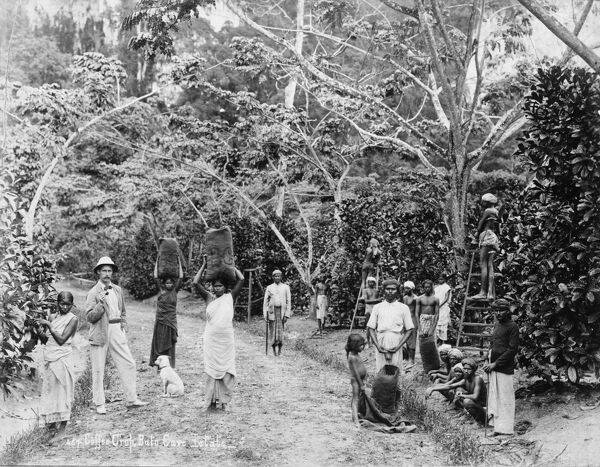
Gambar hiasan: Ladang kopi di Batu Caves Estate, Selangor, tahun 1899 (RBG KEW, 12th February 2015: |"Coffee harvest at Batu Cave Estate, Singapore, 1899").
1891-02-06: Tanah Perkebunan Nagiah
Permohonan sebidang tanah perkebunan di Rekoh, untuk seseorang yang bernama “Nagiah” (PEJABAT SETIAUSAHA KERAJAAN NEGERI SELANGOR, 06/02/1891: |"FORWARDS APPLICATION FROM NAGIAT FOR 0A.2R.26P. OF LAND IN THE DISTRICT OF REKO").
1891-05-12: Jalan Reko-Sepang
Penerokaan Jalan Reko-Sepang ini melalui kawasan hutan yang tidak pernah diterokai, yang kemudiannya dikenali sebagai Hutan Simpan Bangi (1906), dan bakal menjadi kawasan Universiti Kebangsaan Malaysia (UKM - 1970) kini. Seterusnya melewati Bukit Tunggul (kini lokasi Bukit Unggul Golf Country Resort), sebelum merentas kawasan paya menuju Sepang.
LATAR PERISTIWA: Jalan Reko-Sepang.
1892: Pemindahan Tokong Sin Sze Si Ya / Shen Sze She Yar
“Located between Jalan Tukang and Jalan Mendaling is the Sin Sze Si Ya temple, the oldest Chinese temple in Kajang. The temple was initially located at Rekoh but was later moved to its current site in Kajang in 1892. It went through some construction work in 1898 and a grand ceremony was held in 1899. Today, the temple is among thirteen Sin Sze Si Ya temples that can be found in major tin mining towns in Perak, Selangor and Negri Sembilan.”
(Sumber: Eric Lim @ Museum Volunteers, JMM, July 15, 2020: |"History of Kajang").
“Established in 1898, the Kajang Shen Sze She Yar Temple relocated from Rekoh in1892.” (Hanna Hussein @ New Straits Times, December 19, 2019: |"#JOM! GO: More than satay").
1896-03: Pembukaan Ladang West Country dan Belmont
Pada bulan Februari 1896, pemangku pegawai daerah Ulu Langat telah menerima permohonan pembukaan ladang kopi di sekitar Jalan Reko. Beliau turut mengesyorkan agar pihak kerajaan mewartakan keseluruhan kawasan tandus di situ sebagai tanah rizab perladangan: “The Acting D.O., Ulu Langat, writes: 'Several applications have been sent in for waste land on the right bank of the Langat River off the Rekoh Road. There seems little doubt that the land applied for together with a great extent of waste land south of the proposed Klang-Kajang Road, forms part of an all but continuous alluvial plain which stretches down to join the Klang planting reserve on the side of the Langat Road; and if this should prove to be the case, it is greatly to be hoped that the Government will see its way to reserving the whole plain for coffee planters, as it is at present entirely waste, contains no mining land, and is the only portion of the district which is in the smallest degree suitable for a planting reserve.'” (The Singapore Free Press and Mercantile Advertiser (Weekly), 25 February 1896, Page 14: |"SELANGOR NOTES").
Pada bulan Mac 1896, penama-penama bagi permohonan ladang-ladang tersebut telah disiarkan, iaitu F.B. Hicks, E.B. Skinner, A.A. Allen, dan E.J. Allen (West Country Estate), G.F.S. dan M. Sidney Parry (Belmont Estate), dan Kindersley (Reko Hill dan Sungai Reko Estate, diikuti beberapa lagi ladang lain): “Regarding planting in Ulu Langat, Selangor, Mr. Skeat writes in his report: 'The outlook as regards the development of the district by European planters is, on the other hand, most encouraging, and it is greatly to be hoped that the present year will see coffee planting started in earnest on a large scale. Four applications for 320 acres each were received from Messrs. F.B. Hicks, E.B. Skinner, A.A. Allen, and E.J Allen, and two more applications, also for 320 acres each, from Messrs. G.F.S. and M. Sidney Parry, whilst a previous application from Messrs. Kindersley for 320 acres on the Rekoh Road has been granted. The land embraced by the first six applications is a tract upon the right geographical bank of the Langat River, in the neighbourhood of Merbau Tumbang and Bukit Tempurong. It forms the upper end of the broad alluvial flats which stretch, roughly speaking, from the Langat River at Rekoh to the Langat Road at Klang, and merge into the coffee reserve in Klang District. When it is once thoroughly drained and roaded, it should include an abundance of excellent coffee land from which selections cloud be made by intending planters, and it would therefore prove no small advantage if a continuous coffee reserve, running through the two districts, could be proclaimed by the Government.'” (The Singapore Free Press and Mercantile Advertiser (Weekly), 17 March 1896, Page 13: |"COFFEE PLANTING IN THE LANGAT DISTRICT").
Namun perkembangan perladangan kopi agak terencat disebabkan saingan kopi Brazil beberapa tahun selepasnya: “The promise in coffee planting led Malay and Chinese farmers to venture into Ulu Langat in the 1890s. In 1893, some Sumatran migrants experimented with the planting of Liberian coffee. A year later, a European planter was reported to be clearing 607ha of land (AR Selangor, 1893 and 1894). In 1896, Goh Ah Ngee, who was already active in Broga, embarked on coffee planting on a newly-acquired 130ha concession near Kajang (DOUL, 587/1896).
In December 1895, the Kindersley brothers of Inch Kenneth estate in Kajang put in an application for 130ha of land along Reko Road about 3km from Kajang town. This application was considered “of special importance” as it was reported that this locality was once both “populous and extensively cultivated”. Other European planters submitted six applications for 130ha each in the same locality. The hope placed on coffee was also boosted by the new railway
line to Negeri Sembilan (ARUL, 1895). In 1896, several of the leading Chinese miners in the district applied for a total of 294ha of agricultural land (MRUL, June 1896). With the increased demand for land, land revenue more than doubled from $572 in April 1895 to $1,283 a year later. At the turn of the twentieth century, competition from Brazilian producers and diseases threatened to cripple the local coffee planting industry. Although it had yet to be replaced by rubber, coffee was vanishing from the scene. By the 1900s, only 13ha were alienated for its
cultivation in the district.”
(Sumber: Voon Phin Keong @ Malaysian Journal of Chinese Studies, Volume 2, No.2, 2013: |"Transforming the Development Frontier: Chinese Pioneers in the Ulu Langat District of Selangor, Malaysia", m.s.8-9).
Hal ini turut disoroti oleh suatu makalah kompilasi yang ditulis pada tahun 1922: “In the Kajang district, the Kindersley brothers, R. C. M. known as ” the Corporal “ and D. C. P. as ” the Marine “, owned ” Inch Kenneth “ estate and took upland on the Rekoh Road, after which they named their new property. The former is the planting member of the Federal Council of to-day. The Hon. Everard Fielding also took up land which is now the big ” West Country “ Estate in Kajang and Geo. Shepherd was Manager of ” Balgownie “ Estate. … The price of coffee was about dollars thirty five a picul and even went up to dollars forty for number one. The duty was one and half per cent on the gross value. H. H. Huttenbatch, of the present firm of Huttenbach Lazarus, opened a coffee factory in the latter part of 1894. Then it was roughly estimated that it took about dollars three hundred to bring an acre of coffee into bearing, and with luck in two and half years you got your money back. The result was that coffee was planted extensively in Ceylon and here, and we both had a bad slump. The coffee tree however suffered badly from the attacks of fungi and pests, more especially when the cultivation was extensive, particularly in Ceylon. In later years a good many Chinese interplanted Para Rubber with coffee till the shade of the rubber trees allowed no sun in. … R. C. M. Kindersley and his brother D. C. P. successfully turned ” Reko Hill “ from coffee into rubber, and have done a great deal for the industry. The former has now represented planting interests on the Federal Council for some years and has proved very sound, but his brother was killed in the great war to the regret of all. E. U. and R. M. Skinner are still largely connected with rubber planting interests and held a large share in the big Belgian Company, but their interests were recently changed, and they still remain large shareholders and Directors only of the Kajang Group, of which ” West Country “ is the chief one. They have interests in Kedah and elsewhere also. It is believed that both brothers had retired, but the big slump in the rubber industry when the price went below seven pence has caused a good few old planters to return and reorganise their large interests.” (“RIMBA”, 1922: |"Bygone Selangor; a souvenir", m.s.38-40).
LATAR PERISTIWA: West Country Estate dan Belmont Estate.
1896-10-17: Datoh Dagang Ali Mustapha
Permohon pelanjutan kontrak jawatan Datoh Dagang Jawa Rekoh, Ali Mustapha: “… the term of probation of Ali Mustapha, the Javanese Datoh Dagang of Reko, expires on the 31st October. I recommend that he be given a further probationery period of six months, on the same salary, commencing from the 1st November. - District Officer, Ulu Langat.” (PEJABAT SETIAUSAHA KERAJAAN NEGERI SELANGOR, 17/10/1896: |"EXTENSION OF PERIOD OF PROBATION, OF ALI MUSTAPHA, DATOH DAGANG, REKO. RECOMMEND;").
Kontrak lanjutan ini berakhir pada 30 April 1897, dan mungkin tidak disambung lagi selepas itu: “As I am not altogether satisfied that his appointment has been justified by results I recommend that he be employed on his present salary until the end of the current year when, if more satisfactory progress is not shown, his employment can be discontinued.” (PEJABAT SETIAUSAHA KERAJAAN NEGERI SELANGOR, 01/06/1897: |"EMPLOYMENT OF ALI MUSTAPHA, DATOH DAGANG OF REKO").
1897-01-22: Pembinaan Jalan Keretapi
Pembinaan jalan keretapi mula dijalankan di sekitar Rekoh. Seorang pemilik sebidang tanah di situ, A. Ramasamy Mudeliar, membuat aduan menyatakan tanahnya dicerobohi dalam proses pembinaan ini: “That the portion of land … contains 7 acres and 55 poles in Reko road Ulu Langat District which I bought on 20th July 1896 for $350-00. In which there were 1 bullock sheds and two houses. Now the Railway Department has taken that lot without settling with me. … Again they set fire to those sheds & houses and they are now erecting some buildings for the railway purpose. - A. Ramasamy Mudeliar” (PEJABAT SETIAUSAHA KERAJAAN NEGERI SELANGOR, 22/01/1897: |"COMPENSATION FOR HIS LAND ON REKO ROAD WHICH HAS BEEN RESUMED FOR RAILWAY PURPOSES").
LATAR PERISTIWA: Landasan Keretapi Rekoh-Bangi
1897-03-26: Penutupan Balai Polis Rekoh
Bangunan Balai Polis Rekoh tidak lagi digunakan oleh pihak polis, lalu bakal dijual kepada M. Sidney Parry, pengurus Belmont Estate ketika itu: “I have the honour to report receipt of an application from Mr M. S. Parry, Manager of the Belmont Estate near Reko, enquiring as to the terms on which the Government may be prepared to sell in lease the Police Station and Compound at Reko. 2. The station in question has recently been abandoned by the Police and is at present occupied by a caretaker. 3. I do not think it will be advisable to sell the land outright but see no objection to leasing it to Mr. Parry for -say- two years, at a nominal rent of $1- per annum to include the use of the house. 4. Should this suggestion be approved the applicant is prepared to put the building into good repair, a course which necessitates a certain fixity of tenure. … - Acting District Officer, Ulu Langat.” (PEJABAT SETIAUSAHA KERAJAAN NEGERI SELANGOR, 26/03/1897 @ Arkib Negara Malaysia: |"LEASE OF THE REKO POLICE STATION BUILDING TO MR. M.S. PARRY OF BELMONT ESTATE").
Akhir 1890-an: Kemerosotan Hasil Bijih Timah
“Although the upper Semenyih valley was believed to be rich in tin, it was only in the later part of the nineteenth century, following the accelerated tempo of activity in many parts of the west coast, that mining began and ushered in radical change. Much was due to a group of enterprising pioneers some of whom had already found success elsewhere in the state. The district became a hive of mining activity in the mid-1890s. From $25 in early 1895, the mining revenue of Ulu Langat district reached $717 a year later. Tin was first exported from the district in 1895 (DOUL, 677/1895). Expecting a “mining boom”, Chinese poured into every part of the district and many applications were received in 1896 for mining in the upper Semenyih valley (DOUL, 587/1896; MRUL, January 1896).
…
Loke Yew was granted 40ha of mining land at Sungei Merbau in Ulu Langat in February 1896 (MRUL, February 1896). In 1897, he began mining in the outskirts of Kajang with 180 workers. He then ventured into Sungei Kachau in the upper Semenyih valley in 1898 with 100 workers to work on a 40ha concession (MRUL, August 1898).
…
Tin mining stimulated the development of land transport. … In Ulu Langat district, a cartroad of 24km was built from Kuala Lumpur to Kajang in 1888, and extended to Semenyih, 11km to the south, in 1889; a bridle path continued southwards to Beranang in 1890 (AR Selangor, 1890). The 1890s saw short extensions of branch cart and bridle roads from Semenyih to Bangi in the southwest, Broga in the east and Kachau village in Ulu Semenyih in the northeast.
…
Despite the prospects of the tin mining industry, it was soon realized that Ulu Langat district was nothing like the “Eldorados of Kuala Lumpur and Ulu Selangor districts” as “tin is everywhere too pockety” (DOUL, 587/1896). Patchy deposits in some localities were soon worked out and miners had to move elsewhere in the state (ARUL, 1897).”
(Sumber: Voon Phin Keong @ Malaysian Journal of Chinese Studies, Volume 2, No.2, 2013: |"Transforming the Development Frontier: Chinese Pioneers in the Ulu Langat District of Selangor, Malaysia", m.s.7-8).
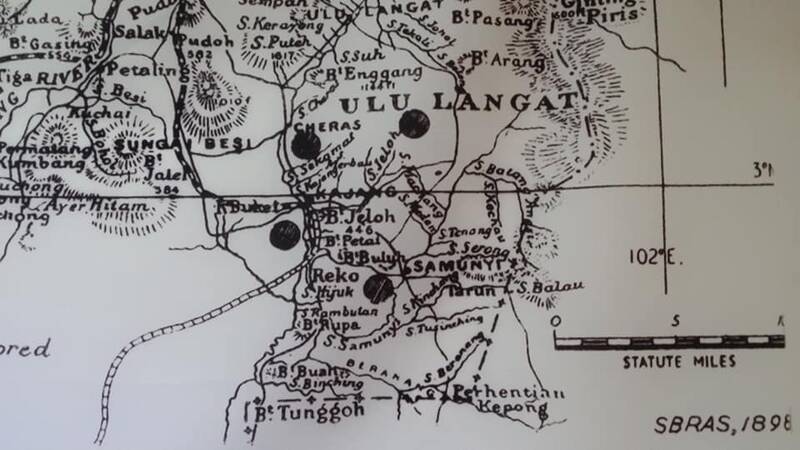
Reko masih ditandakan sebagai antara kawasan lombong di sekitar Hulu Langat: “Location of mines in Hulu Langat.” - SBRAS, 1898. (Kajang Heritage Centre乌鲁冷岳社区文物馆, 21 April 2020: |"Kajang, a Tin Mining Town").
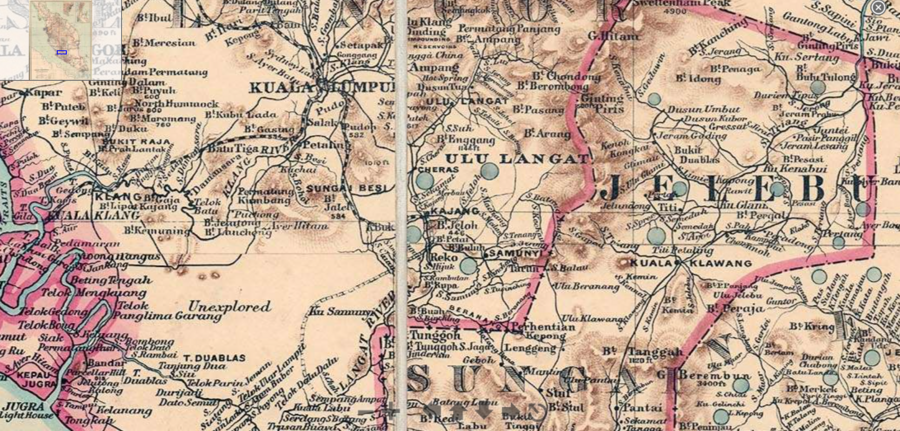
Sebahagian peta 1898 versi asal, merangkumi daerah Ulu Langat, Klang dan Jelebu (John van Cuylenburg, Edward Stanford, The Straits Branch of the Royal Asiatic Society Singapore, 1898 @ Geographicus: |"1898 Cuylenburg / Stanford Map of Malaya Peninsula: Malaysia, Singapore, Siam").
Tahun 1898 masih mencatatkan aktiviti perlombongan di sekitar Sungai Rekoh: “Going further south, there was another Agency at Kajang, opened in 1898, and “actively engaged in buying ores from producers in the surrounding district, including the mining towns of Seminyih, Sungei Reko, Broga, Cheras and Ulu Langat.” This ore was despatched by the agent, F. D. Rees (who was still alive in 1962), to the Singapore smelter, as was that from the Seremban Agent, E. Cameron. Here much of the purchasing was done from Chinese middle- men, owing to the small supplies available. Perhaps 50,000 piculs annually went out through Port Dickson.” (K. G. Tregonning @ Journal of the Malayan Branch of the Royal Asiatic Society, Vol. 36, No. 1 (201) (May,1963): |"STRAITS TIN: A brief account of the first seventy-five years of The Straits Trading Company, Limited", m.s.106).
1898-06-20: Kampung Rekoh
Suatu tinjauan dan bancian semula di Kampung Reko, untuk tujuan pengeluaran semula geran-geran pemilikan tanah penduduknya ketika itu, yang telah lama tidak terurus. Geran-geran tanah yang pernah dikeluarkan di antara 1883-1889 semuanya telah terbatal, berikutan kematian atau penghijrahan pemegang gerannya. Menurut laporan tinjauan, suatu kebakaran yang agak besar pernah berlaku beberapa tahun sebelum ini. Antara yang musnah di dalam kebakaran ini ialah rumah Syed Jahya / Yahya (Penghulu Cheras) dan Anjong bin Amat (yang turut memiliki 6 lot tanah di sini). Berikut adalah hasil tinjauan serta pelan tanah yang dilakarkan.

Pelan tanah Kampung Reko, 1898.
| Section | Lot | Claimant | Nature of Title | Recommendation |
|---|---|---|---|---|
| I | 2 | Ali Mustapha (formerly acting as Datoh Dagang of Reko) | This land appears to have been granted originally to Pongoh bin Sutan under Permit 53 of 1883. Ali Mustapha bought Pongoh's interest in the land, and a Temporary License was issued to him in 1895. Rent paid up to date. | Issue Grant to Ali Mustapha: no premium, rent $1/- per annum. |
| 3 | Syed Jahya (Penghulu of Cheras) - no title, but Syed Jahya appears to have held the land for very many years: formerly built on, but the house was destroyed by fire some years ago; no record of any rent having ever been paid. | Issue Grant to Syed Jahya: no premium, rent $1/- per annum. | ||
| 5 | Anjong bin Amat - Temporary License Formerly contained a house, since destroyed by fire. - Issue Grant no premium, rent $1/- per annum. | |||
| 6 | Sulop | Temporary License. Appears to have been held originally under Agreement 71/84, since cancelled by Notification in the Gazette. | do | |
| II | 1 | Anjong bin Amat | Temporary License | Issue Grant to Anjong; no premium rent $1/0 per annum. |
| 2 | Anjong bin Amat | do | do | |
| 3 | Anjong bin Amat | do | do | |
| 6 | Saleh | Temporary License | Issue Grant to Saleh; no premium, rent $1/- per annum. | |
| 7 | Anjong bin Amat | do | Issue Grant to Anjong; no premium, rent $1/- per annum. | |
| 8 | Anjong bin Amat | do | do |
Hasil tinjauan ini turut menemui 2 buah rumah yang terletak di tebing Sungai Langat, milik Ja Pahlawan (sebelumnya Haji Daud) dan Haji Abdullah. Mereka akan ditawarkan lot kosong di dalam pelan, tetapi dibenarkan terus mendiami rumah-rumah sedia ada tersebut: “There are, however, two houses, built close to the river bank, upon land which it is not advisable to alienate under Grant. They are owned respectively by Ja Pahlawan (former Agreement 39/85 in name of Haji Daud) and Haji Abdullah. I propose to allow each of these parties to select one of the vacant lots in Sections 1 and 2, and to issue Grants on the terms proposed in other cases. They can continue, should they so wish, to occupy their present sites under Temporary Licenses, until the existing houses disappear.”
(Sumber: PEJABAT SETIAUSAHA KERAJAAN NEGERI SELANGOR, 20/06/1898: |"REKO VILLAGE SETTLEMENT").
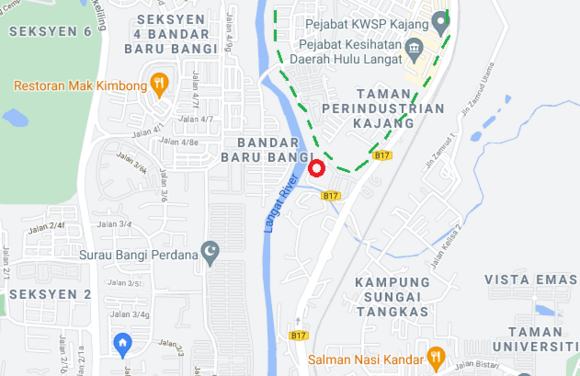
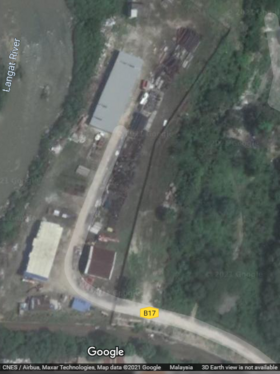
Kiri: Kemungkinan lokasi Kampung Reko kini (bulatan merah), di sempadan selatan Reko Hill Estate (garis putus hijau - ketika itu belum wujud lagi, bakal dibuka 1904).
Kanan: Kemungkinan kawasan pelan tanah, kini.
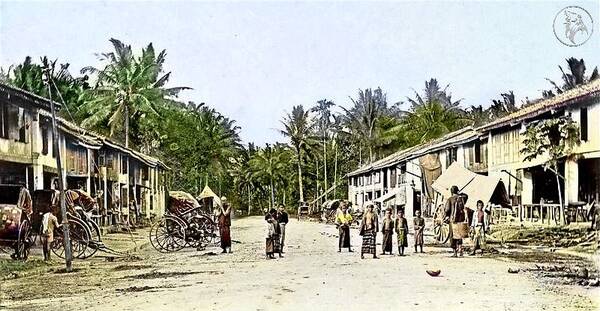
Gambar hiasan: Perkampungan Mandailing-Rawa di Kuala Lumpur, tahun 1890. Kemungkinan perkampungan Rekoh ketika itu juga begini: “Kuala Lumpur, 1890 - Image of Kampung Rawa, the Mandailing-Rawa settlement that formed the core area of old KL at the southern end of Batu Road, on the western bank of the Klang River.” (Vijaya Kumar Ganapathy: "Kuala Lumpur, 1890 - Image of Kampung Rawa").
1896-1900: Permulaan Era Getah
Tanaman getah komersial terawal dirintis oleh pasangan adik-beradik Kindersley atas cadangan H.N. Ridley pada tahun 1896 di ladang Inch Kenneth, Kajang. Kejayaan ini menjadi galakan kepada mereka serta pengusaha lain untuk membuka ladang-ladang getah di sekitar Kajang (Balgownie, Paradise), Rekoh (West Country, Belmont), dan Bangi (Bangi Estate): “The original purpose of the Kindersley brothers was to open coffee estates (free of the restriction to 250 acres in the Klang valley), but in 1896 H. N. Ridley, Curator of the Botanic Gardens in Singapore, supplied them with rubber seedlings to plant an experimental 5 acres on Inch Kenneth estate, near Kajang. They are generally credited with being the first to plant rubber on a commercial scale in Malaya. The collapse of the coffee industry in 1899 brought the Kindersleys to the brink of ruin but these dogged Scotsmen survived the crisis and went on to become prominent in the new industry. One of them, R. C. M. Kindersley, was an unofficial member of the FMS Federal Council in the 1920s. The example of the Kindersleys led to the creation of a group of estates, mostly within a mile or two of the railhead (1897) at Kajang. The Kindersleys owned Balgownie, Inch Kenneth, and Bangi estates. In 1898 Lau Boon Tit opened Semenyih estate, which was later acquired by the Asiatic Rubber Produce Company. Lau 'went for broke' in planting 54 acres of rubber in 1898. A few years later, the FMS Rubber Co. owned West Country, Belmont, and Ayer Hitam estates, and E. V. Carey, chairman of the Selangor Planters' Association, opened Paradise estate. Thus, for the first time, Ulu Langat became a flourishing 'planting district'. It was a turning point.” (J.M. Gullick, 2007: |"A Short History of Ulu Langat to 1900"), m.s. 16-17).
Menjelang 1900-an, Kajang dan Rekoh telah menjadi antara kawasan ladang getah terawal di Selangor, didominasi oleh peladang Eropah secara kolektif: “Significantly, the earliest systematic planting of rubber in Selangor took place in 1895 in Ulu Langat district itself. This was the experiment of the Kindersley brothers who planted 2ha in their Inch Kenneth coffee estate near Kajang. … Once the economic potentials of rubber had been proven, and having gained experience in coffee cultivation, European planters were quick to seize the opportunities offered by the new crop. Commercial production of rubber also marked the beginning of domination of European enterprise over Asian smallholders. There were 30 European and 22 other rubber estates in Ulu Langat district in 1908 (MRUL, May 1908; DOUL, 92/1908). European planters formed the Kajang Branch of the Planters' Association in May 1912 to further their interests and organized a social club in June to strengthen ties among each other (MRUL, July 1912, SSF, 112/1912).” (Voon Phin Keong @ Malaysian Journal of Chinese Studies, Volume 2, No.2, 2013: |"Transforming the Development Frontier: Chinese Pioneers in the Ulu Langat District of Selangor, Malaysia", m.s.9).
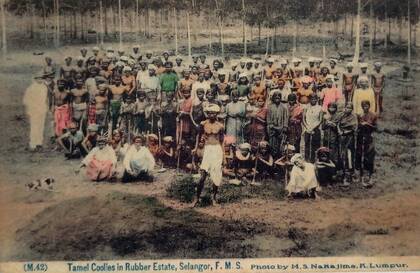
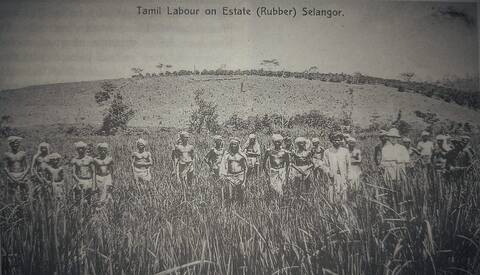
Gambar hiasan: Pekerja ladang getah awal, di sekitar Selangor. Kiri: Tamil coolies in Rubber Estate, Selangor, F.M.S.“ (M.S. Nakajima, 1910 @ Faizal Zainal, Selangor 10, 9 Oktober 2019: |"Foto Selangor Zaman Dulu - Dulu"). Kanan: Faizal Zainal @ Selangor 10, 10 Januari 2020: |"Ladang Getah Pertama".
“Ladang getah pertama di Selangor dan di negara ini bermula di Kajang pada tahun 1896 apabila peladang dan usahawan berbangsa Scotland R.C.M Kindersley menanam seluas 5 ekar pokok getah di kawasan ladang kopi milik beliau di Inch Kenneth Coffee Estates Kajang selepas memperolehi anak - anak pohon getah dan juga mendapat panduan dan dorongan daripada Bapa Getah Tanah Melayu Henry Ridley (Director Singapore Botanical Garden).
Pada 1904 Inch Kenneth Rubber Estates di tubuhkan di Edinburg dan pada 1910 Kajang Rubber Estates ditubuhkan mengabungkan beberapa ladang getah di sekitar Kajang - Bangi untuk pengurusan ladang komersial secara besar - besaran.
Tayar kereta di New York dan London, getahnya di toreh di Kajang dengan gaji 50 sen sehari.”
(Sumber: Faizal Zainal @ Selangor 10, 10 Januari 2020: |"Ladang Getah Pertama").
LATAR PERISTIWA: Perladangan Kindersley dan Inch Kenneth Estate (1894).
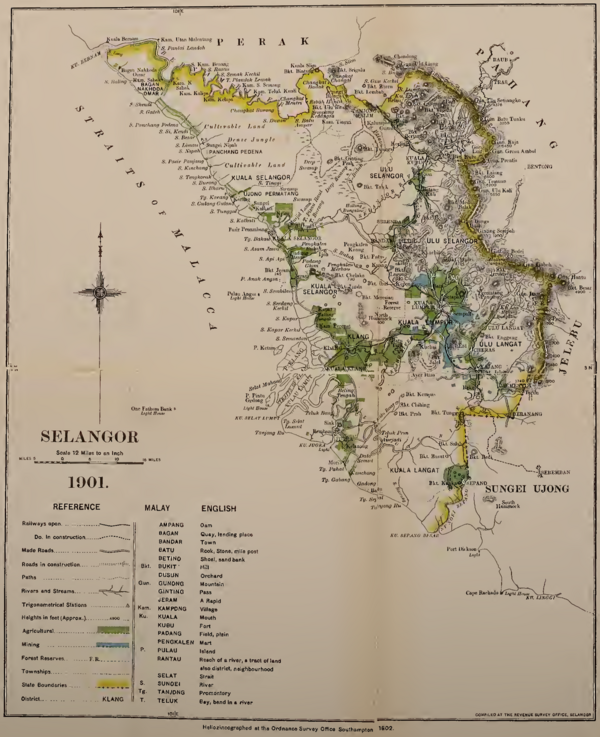
Peta Selangor, tahun 1901 (Henry Conway Belfield, 1902: |"Handbook of the federated Malay states").
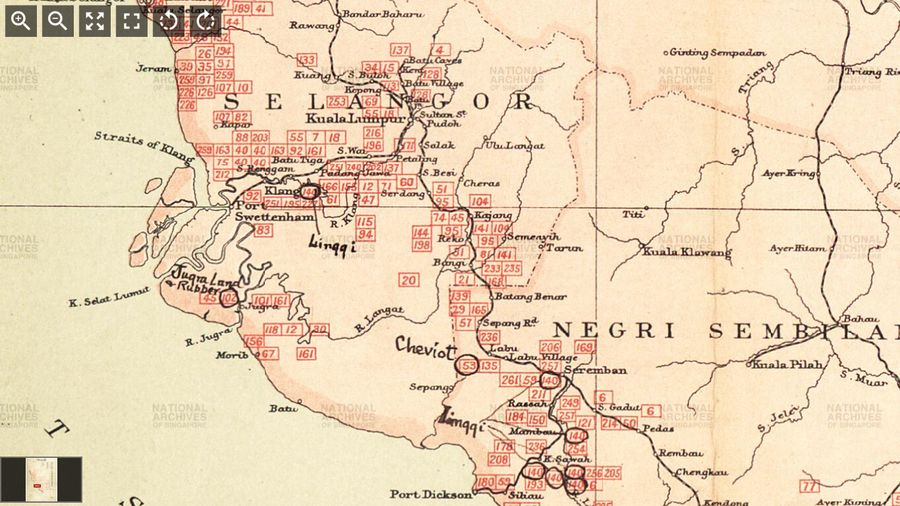
Pada tahun 1910-an, kawasan Bangi-Reko-Kajang-Semenyih adalah antara kawasan ladang-ladang getah utama di Selangor: “This map of Malaya shows the rubber estates with the names of the rubber estate companies and the number of their estates tabulated, British Territories of Pulau Pinang, (Province) Wellesley, Dindings, Malacca and Singapore, Federated Malay States of Negri Sembilan, Selangor, Perak and Pahang under British Protection, other Malay States of Johore, Kelantan, Trengganu, Kedah and Perlis under British Protection, towns, rivers, islands, railways in operation, proposed railways, railway stations, George Town, Port Weld, Taiping, Ipoh, Kulala Lumpur, Port Swettenham, Seremban, Malacca Town, Johore (Bahru), Singapore City, Pekan, Kuantan, Kuala Trengganu, Khota Bahru (Kota Bharu), Sungei Perak, Sungei Benam, Sungei Klang, Sungei Muar, Sungei Batu Pahat, Sungei Johore, Sungei Endau, Sungei Pahang, Sungei Kelantan, Pulau Tioman, and others.” (G.J. Richardson Co., 1910 @ National Archives of Singapore: |"The Financial Times Map Showing The Position of The Rubber Estates in British Malaya").
1900-05-05: Pampasan Tanah Landasan
Rayuan oleh Andrishamy, seorang pemilik tanah di sekitar Kajang-Rekoh, agar pihak British memberikan pampasan yang lebih setimpal dengan keluasan tanah beliau yang telah diambil alih untuk tujuan pembinaan Landasan Keretapi Rekoh-Bangi: ”…Petitioner had been a resident of this State for about 9 years and laid his small savings on lands in Kajang with the hope of bettering his prospects and settling here. … he also laid a sum of money on a piece of land in extent 4 1/2 acres situated on the Reko Road. About 5 years ago the Public Works Department took over a portion of the Petitioner's land for the purpose of constructing a road and paid Petitioner a compensation of ($35/-) Dollars Thirty five only. That during this year the Railway Department took over another portion of the Petitioner's land for the Seremban Extension of the Railway. Thus the Petitioner's land has been divided into several pieces. The Petitioner was given a sum of ($20/-) Dollars Twenty only … the Railway taking 100 feet on both sides of the line in addition to the land already taken there only remains two strips of land one between the Public Road and Railway line and the other on the off side of the Railway line. … the Petitioner can in no way utilize these two strips of land … before the Railway took the portion what they required, an offer of ($100/-) Dollars One hundred was made. Lands out here are rising in price from time to time…“
Menurut Pegawai Daerah Ulu Langat yang mengajukan perkara ini, J.R.O. Aldworth, tanah tersebut agak terbiar, dan Andrishamy telah pun bersetuju secara bertulis dengan pampasan awal ($20), tetapi kali ini memohon pampasan yang lebih setimpal: “In 1896 petitioner acquired from the State 4 1/2 acres of land fronting on the Reko Road, immediately outside the present extended town limits. … At the end of last year … a strip of lane 200 feet wide for railway purposes and I awarded to petitioner the sum of $20/-; this I considered very liberal, he lost only 3 roods of lalang land on which were 7 areca nuts and one small coconut, all in a neglected condition. What I took most into consideration in awarding the compensation, which was paid on 12th February, 1900, was the severance of the land. … The petitioner has no legal right to have his case further considered as he accepted my award of $20/-”
(Sumber: PEJABAT SETIAUSAHA KERAJAAN NEGERI SELANGOR, 05/05/1900: |"AUDRIS HAMY'S PETITION RE LAND OFF THE REKO ROAD RESUMED FOR RAILWAY PURPOSES").
LATAR PERISTIWA: Landasan Keretapi Rekoh-Bangi.
LATAR PERISTIWA: Perihal J.R.O. Aldworth.
1900-06-02: Kuari Landasan Keretapi
Pewartaan tanah rizab kuari di Reko, untuk tujuan pembinaan landasan keretapi yang menghubungkan Kajang dan Bangi (PEJABAT SETIAUSAHA KERAJAAN NEGERI SELANGOR, 02/06/1900: |"NOTICE OF RESERVATION OF LAND FOR A RAILWAY QUARRY AT REKO").
LATAR PERISTIWA: Landasan Keretapi Rekoh-Bangi.
1902-10-30: Jambatan Besi di Jalan Reko
Pembinaan jambatan besi di Jalan Reko: ”…recommending that the sum of $2659.68 be expended in purchasing two twenty feet span iron bridges from the Factory for the Sungei Lallang and Reko Roads.“ (PEJABAT SETIAUSAHA KERAJAAN NEGERI SELANGOR, 30/10/1902: |"TWO TWENTY FEET SPAN BRIDGES FOR SUNGEI LALLANG AND REKO ROADS").
1903-04-16: Perolehan Tanah Landasan
Beberapa bidang tanah di sekitar Kajang diambil alih oleh kerajaan untuk tujuan penyelenggaraan landasan keretapi Kajang-Bangi. Antara penama-penama tanah ini ialah Ali Mustapha, Pongoh bin Sutan, dan Ja Pahlawan, yang ada memiliki tanah di Kampung Reko (PEJABAT SETIAUSAHA KERAJAAN NEGERI SELANGOR, 16/04/1903: |"Lands and Reserves, F.M.S. Rlys").
LATAR PERISTIWA: Landasan Keretapi Rekoh-Bangi.
1905: Kemuncak Pembukaan Ladang Getah
“U.L.No:233/1905. District Office, Kajang, 3rd: November, 1905. Report for the month of October, 1905. Sir, I have the honour to make my report for the month of October, 1905. 1. The Resident and the State Engineer visited Kajang on 4th and 5th. Accompanied by myself and the ag: Executive Engineer they motored over practically all the roads in the district, visiting Reko, Semenyih, Beranang, Balau, Ulu Langat and Dusun Tua. 2. Visits of inspection were also made by the Financial Commissioner and the Chief Police Officer. … 4. An application was made by Mr: R.C.M.Kindersley on behalf of the Inch Kenneth Rubber Estates Limited for 1000 acres of land for rubber planting between Reko and Bangi. If this application is approved, practically all the available land between Kajang and Bangi will be under rubber cultivation. - Ag: District Officer, Ulu Langat” (Arkib Negara 1957/0125542W, 03/11/1905: |"MONTHLY REPORT FOR OCTOBER, 1905 -").
1905-1906: Perlombongan di Sungei Pajak
Tidak pasti lokasinya di mana. Rekod permohonan lesen perlombongan bijih timah di sini:-
- 1905-12-12: Teng Wi Liong dan Yi Leng (10 ekar), di Batu 18 Jalan Reko, menghala ke Semenyih. Khabarnya telah ada lombong lain di sekitarnya (PEJABAT SETIAUSAHA KERAJAAN NEGERI SELANGOR, 12/12/1905: |"APPLICATION FROM TENG WI LIONG AND YI LENG FOR 10 ACRES OF MINING LAND AT SUNGEI PAJAK REKO :").
- 1906-04-27: Lim Loh dan Yi Leng (35 ekar). Khabarnya bakal diusahakan oleh 30 orang pekerja (PEJABAT SETIAUSAHA KERAJAAN NEGERI SELANGOR, 27/04/1906: |"SANCTION TO ISSUE A MINING CERTIFICATE TO LIM LOH AND YI LENG OVER 35 ACRES OF LAND AT SUNGEI PAJAK REKO").
1906-11-05: The Bangi Rubber and Tin Properties
Pendaftaran Syarikat The Bangi Rubber and Tin Properties, bagi memperolehi tanah kerajaan negeri Selangor seluas 705 ekar di sekitar Rekoh, untuk tujuan perladangan getah (Kajang Rubber Estates) serta perlombongan bijih timah (The Straits Times, 5 November 1906, Page 7: |"New Rubber Company"; The Singapore Free Press and Mercantile Advertiser, 6 May 1907, Page 7: |"Page 7 Advertisements Column 1").
CATATAN: Ladang di Rekoh ini pernah dilengkapi dengan sebuah hospital, namun ianya ditutup setelah Hospital Kajang dibuka untuk seluruh warga terdekat (mungkin setelah bangunan barunya siap dibina pada tahun 1910 (Hospital Kajang, 2016: |"Sejarah")). Ladang Bangi Rubber kemudiannya bergabung dengan Ladang Balgownie, kemungkinan sekitar tahun 1908-1909 (The London Gazette, December 1, 1908: |"JOINT STOCK COMPANIES").

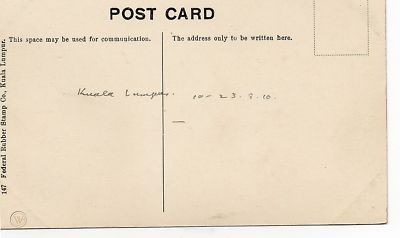
Para pekerja sedang menggali tanah permukaan lombong bijih timah di Cheras, 1910. Kemungkinan lombong-lombong di Rekoh juga begini (Federal Rubber Stamp Co., Kuala Lumpur, 1910 @ Worthpoint: |"TIN MINING, CHERAS, SELANGOR, MALAYSIA, 1910").
1911-05-10: Tapak Cadangan Padang Golf
Cadangan padang golf seluas 30 ekar di sekitar Reko: “a proposal is now under consideration by the European Residents in UlU Langat district for the formation of a new Golf Course with Club House - stables etc just 2 1/2 miles out of Kajang on the Reko road. … The proposed site is a block of about 30 acres of undulating land at present forming part of the Kajang Rubber Companys property…” (SETIAUSAHA KERAJAAN NEGERI SELANGOR, 10/5/1911: |"LAND FOR THE PROPOSED NEW GOLF COURSE WITH CLUB HOUSE &C AT 2? MILES REKO ROAD, ULU LANGAT").
1912-07-08: Hospital Reko
Hospital Reko diasaskan.
LATAR PERISTIWA: Hospital Reko.
Peta Rekoh 1920-an dan Kini

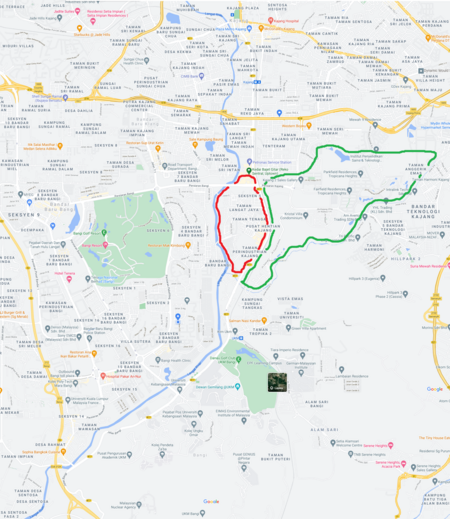
Kiri: Kawasan Rekoh, 1920-an. (Survey Department, Singapore, 1927 @ National Archives of Singapore: |"Parts of Seremban and Jelebu Districts with portions of Ulu Langat and Kuala Langat Districts (Selangor), Kajang, Negri Sembilan").
Kanan: Kawasan Rekoh kini (Google Maps).
| Petunjuk Peta (1920-an) | Kawasan yang sama kini | |
|---|---|---|
 | Sungai Reko Estate. Sempadan selatannya sepanjang Sungai Reko. | Kajang 2, Kajang Villa, Tropicana Heights, Rafflesia International School, Taman Anggerik Emas. |
 | Reko Hill Estate. Muara Sungai Reko di sebelah selatannya. | Bandar Baru Bangi Seksyen 5, SJK(T) Ladang West Country Timur, SMK Jalan Reko, Taman Tenaga, Taman Langat Jaya, Pusat Hentian Kajang, Taman Perindustrian Kajang. |
1924-02-15: Perlombongan di Lembah Reko
Permohonan untuk perlombongan di Lembah Reko seluas 186 ekar, oleh Messrs A.H. Elowerdew and E.W. Tyler (PEJABAT SETIAUSAHA KERAJAAN NEGERI SELANGOR, 15/02/1924: |"PROSPECTING LICENSE OVER 186 ACRES OF STATE LANDS, REKO VALLEY, KAJANG - APPLICATION FROM MESSRS. A.H. ELOWERDEW AND E.W. TYLER FOR").
Perkembangan Kajang dan Peminggiran Rekoh
Menjelang 1900-an, pekan terdekat dengan kawasan Rekoh, Kajang, mula berkembang pesat sebagai pusat ekonomi serta pentadbiran British bagi kawasan selatan Selangor. Hal ini menyebabkan Rekoh mulai terpinggir dan akhirnya menjadi sebahagian daripada ladang-ladang estet yang dibuka besar-besaran ketika itu, untuk tujuan tanaman kopi dan kemudiannya getah. Pekan dan perkampungan Rekoh beransur lenyap dan semakin dilupakan, sehingga tiada kesannya lagi kini:-
- ”Tin mining and rubber cultivation led to the establishment of Kajang town. In 1850s, first tin mine in Hulu Langat District was at Rekoh. In 1868, Towkay Chin Ah Chan was offered by Sultan Abdul Samad to open tin mine in Bukit Arang. The Mandailing migrants from Sumatra were the pioneers in opening up forest land in and around Kajang. Chinese and India migrants moved into Kajang in the 1870s as labourers and traders. 1884 census report of Kajang Town recorded 60 inhabitants, consisted of 19 Chinese, 1 Indian and 40 Sumatrans. In 1890s, British planters started coffee cultivation in Kajang. However, it failed due to disease infection. In 1895, Kindersly Brothers started planting rubber and were successful. At the same time, the first batch of brick shophouses was built. In the early 20th century, Kajang had developed into a commercial and administrative centre in Southern Selangor.“ (Lee Kim Sin @ Selangor.Travel, October 19, 2019: |"A brief History of Kajang via the Kajang Heritage Walk").
- “Ulu Langat District Office was set up in 1883 and records of that time show that the Ulu Langat village was the largest settlement in the district but Kajang was chosen as the district capital because of its central location. An early census of Kajang is interesting – one police clerk (indicating that the police station was already established), one ranger (most definitely Raja Alang), twenty-two shopkeepers (of which sixteen were Sumatrans) and one gambler (most likely a Chinese!). The district office building was built in the 1910s and was in operations until it was demolished and a new building (Bangunan Dato Nazir) constructed in 1970.” (Eric Lim @ Museum Volunteers, JMM, July 15, 2020: |"History of Kajang").
- “Pada November 1882 pusat utama di Hulu Langat ialah Rekoh yang mempunyai empat buah kedai Cina dan 20 kedai Melayu, dan Kajang dengan 3 atau 4 buah kedai Cina dan 30 buah kedai Melayu. Kira-kira 900 orang pula bekerja di lombong bijih berhampiran Rekoh (mungkin di kampung Sungai Tangkas yang masih wujud pada masa kini). Bagaimanapun selepas itu, Kajang lebih diberi perhatian dan dijadikan pusat pentadbiran daerah. Sekolah Inggeris dan Melayu dibina di Kajang, bukan di Rekoh. Begitu juga hospital dan pejabat-pejabat kerajaan yang lain. Rekoh akhirnya mengalami kemerosotan dan “lenyap”.” (Andin Salleh, July 18, 2013: |"Pekan Rekoh yang sudah lenyap").
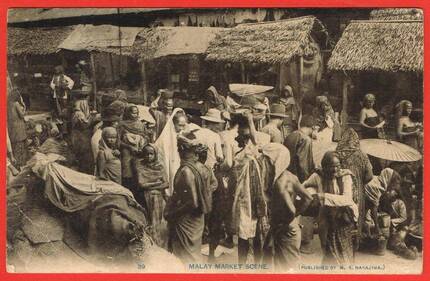
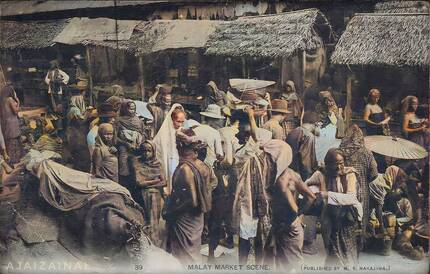
“Salah satu koleksi foto poskad M.S.Nakajima: Suasana di Pasar Melayu, Kajang,Selangor sekitar tahun 1910. M.S.Nakajima antara jurufoto Jepun yang awal bertapak di Kuala Lumpur yang merakam foto-foto sebagai poskad di Tanah Melayu dan Singapura. Poskad ini pernah di siarkan di E-bay dan sudah pun terjual. Rujukan : Worth point.” (Izmal Karim, 11 September 2018: "Poskad & Sejarah : Suasana di Pasar Melayu, Kajang – 1910s". Diwarnakan semula oleh: Faizal Zainal @ Selangor 10: |"Pasar Kajang - 1910").
Ringkasan
2023-10-21: Pembentangan Wacana Cebisan Sejarah Rekoh
Bahan yang telah dibentangkan: 2023-10-21: Pembentangan Wacana Cebisan Sejarah Rekoh

